
The Federal Democratic Republic of Ethiopia
Guideline for Mainstreaming Disaster Risks
into the Development Planning Process and
Future Investment Decisions in Ethiopia
National Disaster Risk Management Commission, Ethiopia
2017

© 2017 National Disaster Risk Management Commission, Ethiopia
Published in 2017
Printed in Ethiopia by Central Printing Press
This guideline for Mainstreaming Disaster Risks into the Development Planning
Process and Future Investment Decisions in Ethiopia is developed by the National
Disaster Risk Management Commission (NDRMC) to establish future directions for
scaling up disaster and climate resilience in recognition of the Sendai Framework
for Disaster Risk Reduction, the Sustainable Development Goals, and the Paris
Agreement. These global frameworks have stressed the importance of the role of
DRM mainstreaming in building resilience at national and local levels.
Under the overall guidance of H.E. Ato Mitiku Kassa, Commissioner of the NDRMC,
this guideline is produced by the NDRMC led by Ato Tadesee Bekele, Advisor to
the NDRMC. The external technical team consisted of Mr. Aslam Perwaiz from
the Asian Disaster Preparedness Center (ADPC), and Mr. Prashant Singh and
Mr. Alemseged W. Yohannes Bedane from the World Bank (WB). Technical
support was provided by Dr. Sunil Prashar, Mr. Irfan Maqbool, and Ms. Phitsamai
Khammanivong of ADPC, which was highly appreciated. The guideline benefited
from a peer review by Ato Tadesse Bekele and Dr. Zewdu Eshetu Asfaw from
the African Center for Disaster Risk Management (ACDRM), and Ato Fikre Negussie
from the World Bank. We would like to extend our sincere gratitude to the
World Bank for financial support, and the Asian Disaster Preparedness Center for
technical support in the development of this guideline.
We would like to express our appreciation to the representatives of federal
government line agencies that reviewed this guideline and provided sector-
specific inputs required to develop this sectoral guideline. We would also like to thank
Mr. Mathewos Hunde Tulu, Head of UNISDR Africa, for providing essential guidance.
Finally, our deep gratitude extends to the NDRMC staff, for their coordinated efforts
in the conceptualization, development, and finalization of this document
National Disaster Risk Management Commission, Ethiopia
Disclaimer: This document is a compilation field study, comprised of desk-based
research and existing reports. Any discrepancies are unintended. Care has been
taken in providing factual descriptions and data sources. This document remains
open for any corrections required in facts, figures, and visuals.
Photo Credits: ADPC

Foreword
By 2025, our vision is to reach the level of lower-middle-income countries, where
democracy, good governance, and social justice are maintained through people’s
participation. The vision of our country calls for creating a comprehensive Disaster
Risk Management (DRM) system for Ethiopia by broadening the scope to encompass the
urban and industrial sectors, and to widen its approach that focuses on preventive and
ex-ante aspects of DRM. Mainstreaming disaster risks into the development planning
process and future investment decisions are the main priorities of the Commission.
The National Policy and Strategy on Disaster Risk Management (NPSDRM) and the
Disaster Risk Management Strategic Programme and Investment Framework (DRM-SPIF)
of Ethiopia presents clear pathways for managing disaster risks through the National
Disaster Risk Management Commission (NDRMC) and the lead agencies to develop a specific
framework for action to reduce disaster risk and design mechanisms for efficient and
harmonized fund allocation and utilization. It also provides investment options for
partners interested in supporting DRM efforts in the country. One of the specific key
objectives of DRM-SPIF is to, “mainstream DRM into all sectors, and ensure it is integrated
into regular development programs and implemented at all levels”.
As part of its long-term program on establishing a robust disaster risk management
system in the country, the DRM-SPIF aims to create a paradigm shift from response and
recovery, to a multi-sectoral and comprehensive approach that focuses on disaster
prevention, mitigation, and preparedness. The NDRMC coordinates with key sectors
and development partners for the implementation of the SPIF. The current institutional
capacity is sufficiently strong to take up the overall coordination mechanism.
To achieve our objectives, this guideline serves as an important tool for designing and
implementing public investment programs ensuring the disaster and climate risk are
integrated into the planning and budgeting process. It is expected that lead sector
agencies will take ownership of the guideline in terms of its implementation and its
enhancement based on actual use in the future. It is important that the commitment of
the development partners is realized by providing support to lead agencies in
operationalizing the sectoral mainstreaming guideline and putting the guideline into
practice.
I am extremely confident that this guideline will support in establishing and
strengthening the integrated system for DRM by increasing cross-sectoral, multi-agency
interaction, including private and public-sector partnerships.
Mitiku Kassa
Commissioner
NDRMC
i

ii

Contents
Foreword
i
Acronyms
viii
Executive Summary
x
Part 1: Introduction
1
1.1 Overview of DRM in Ethiopia
1
1.2 DRM System and Structures
8
Part 2: Mainstreaming Disaster Risk Management into Development 17
2.1 DRM Mainstreaming and its Significance in Resilience Building 17
2.2 Existing Tools, Methods, Approaches and Policy Environment
Supporting DRM Mainstreaming in Ethiopia
25
Part 3: Process of DRM Mainstreaming
31
3.1 Conceptual Framework
31
3.2 Mainstreaming DRM into Policy Making
32
3.3 Mainstreaming DRM into Development Planning
37
3.4 Mainstreaming DRM into Budgetary Processes and Resource
Allocations
42
3.5 Mainstreaming DRM into Development Projects
49
Part 4: Guidelines for Mainstreaming DRM into Policy and
Planning in Ethiopia
55
4.1 Development Planning Process in Ethiopia 55
Part 5: Guidelines for Developing Risk-Sensitive
Sectoral Investment Plans
65
Guidance Note 1: Agriculture and Rural Transformation Sector
73
Guidance Note 2: Environment and Climate Resilient Green Economy 87
Guidance Note 3: Health Sector Development
97
Guidance Note 4: Potable Water Supply and Irrigation Development Sector107
Guidance Note 5: Integrated Transport and Logistics Services
119
Guidance Note 6: Urban Development and Housing
131
Guidance Note 7: Education and Training
141
Guidance Note 8: Social Welfare and Security (Safety Net)
155
iii

List of Boxes
Box 1.1
Box 1.2
Box 2.1
Box 2.2
Box 2.3
Box 5.1
Box 5.2
Box 5.3
Box 5.4
Box 5.5
Box 5.6
Box 5.7
Box 5.8
Box 5.9
Box 5.10
Box 5.11
Box 5.12
Box 5.13
Box 5.14
New Drought Affected Southeastern Regions (2015-2016)
6
National Disaster Risk Management Commission:
Duties and Responsibilities as Stated in Regulation No.363/2015
10
Ethiopia’s Economic Growth by Eight Percent
18
Key Objectives of Mainstreaming DRM
19
Mainstreaming Disaster Risk Management into Sectoral Institutions
27
Natural Resource Management (NRM): Good Practice Checklist
86
EMB Integrates Disaster Risk Reduction and Climate Change
Adaptation in the Environmental Impact Assessment (EIA)
Requirement in the Philippines EIS System
96
Health Sector Self-Assessment Tool for Disaster Risk Reduction -
Pan American Health Organization (PAHO)
105
Promote the Use of Wereda Disaster Risk Profile Data and
Information for Enhancing the Health Sector Vulnerability and
Risk Assessment Mapping
105
Promote the Use of Wereda Disaster Risk Profile Data and
Information for Irrigation Development Feasibility Study and Design 118
Conduct Capacity Building or Training of Staff on DRM/R
Integration into Irrigation Development, Including Irrigation,
and Design Works
118
Disaster Risk Reduction and the Road Network, the Philippines
118
Communication During Emergency Response
127
Checklist for Mainstreaming Disaster Risk Reduction into
Transportation Projects - Identification, Preparation, and
Appraisal Standards
128
City Strength Resilient Cities Program for Addis Ababa
129
Checklist for Integrated Solid Waste Management Initiatives in Cities 139
Checklist for Building Codes and Disaster-Resilient Construction
in Cities
140
Comprehensive School Safety Framework
140
A Guide for Including People with Disabilities in Disaster
Preparedness Planning
161
iv

List of Figures
Figure 1.1 The Most Important Hazard (As perceived by rural households)
1
Figure 1.2 Most Important Perceived Constraints for Poor Households
2
Figure 1.3 Most Important Perceived Constraints for Well-off Households
2
Figure 1.4 Ethiopia INFORM risk index
3
Figure 1.5 Hazard, Exposure, Vulnerability, and Lack of Coping Capacity
4
Figure 1.6 Key Constraints for Livelihoods in Ethiopia
5
Figure 1.7 Average Percentage Share of Damage and Loss to Livestock by
Type of Hazard
5
Figure 1.8 Timeline Showing DRM Institutional Arrangements in Ethiopia
8
Figure 1.9 NDRMC – Organizational Structure
9
Figure 1.10 Government Coordination Structure in Ethiopia
13
Figure 2.1 Conceptual Framework for Mainstreaming DRR into Development
17
Figure 2.2 Overall and Insured Losses from the World Natural Catastrophes,
1980 to 2016
18
Figure 2.3 Policies and Strategies in Ethiopia with DRM Linkages
22
Figure 2.4 Expected Outcomes of Mainstreaming DRM in Ethiopia
24
Figure 2.5 Key Components of the WDRP Database
25
Figure 2.6 Webpage of Wereda (District) Disaster Risk Profiling Information
Management System
26
Figure 2.7 Application of Wereda Disaster Risk Profile
26
Figure 3.1 Conceptual Framework for Mainstreaming DRR into Development
31
Figure 3.2 Development Framework Process
32
Figure 3.3 Mainstreaming DRM Process into Policy Making
34
Figure 3.4 Mainstreaming DRM Process into Development Planning Process
38
Figure 3.5 Mainstreaming DRM Process into Budgetary Processes
44
Figure 3.6 Risk Layering and the Application of Financial Instruments
48
Figure 3.7 Mainstreaming DRM into Development Projects
50
Figure 4.1 Organizational Structure of the National Planning Commission
in Ethiopia
56
Figure 5.1 Steps for Mainstreaming DRM into Sector
66
Figure 5.2 Conceptual Framework for Sectoral Disaster Risk Management
69
v

List of Tables
Table 1.1 DRM Gaps, Issues, and Challenges in Ethiopia
14
Table 2.1 Priorities for Action for Mainstreaming DRM
20
Table 2.2 Priorities for Action for Mainstreaming DRM in Africa
21
Table 2.3 Lead Sector Institutions Responsible for DRM in Ethiopia
28
Table 3.1 Process of Mainstreaming DRM into Policy Making: General Guidance 35
Table 3.2 Process of Mainstreaming DRM into Development Planning
Process: General Guidance
39
Table 3.3 Disaster Information and Potential Sources
42
Table 3.4 Process of Mainstreaming DRM into Budgetary
Processes: General Guidance
45
Table 3.5 Process of Mainstreaming DRM into Development Projects:
General Guidance
51
Table 4.1 Getting Started in Mainstreaming DRM into the Development
Planning Process in Ethiopia: Key Tasks
60
Table 4.2 Guidance on Mainstreaming DRM into the Development
Planning Process in Ethiopia
60
Table 5.1 Broad Mainstreaming Steps and Descriptions
67
Table 5.2 Explanation of Conceptual Framework for Sectoral DRM
70
Table 5.3 Selected Sector, Lead Sector Agencies, and Data/Sources for
Sectoral Risk Analysis
71
Table 5.4 Lead Agencies Roles and Key Programs on DRM: Agriculture
and Rural Transformation
74
Table 5.5 Objectives of Agriculture and Rural Transformation
75
Table 5.6 Implementation Strategy for Agriculture and Rural Transformation
76
Table 5.7 Major Impacts of Disasters on Agriculture and Livestock in Ethiopia
77
Table 5.8 Key Steps and Activities for Mainstreaming DRM into Agriculture
and Rural Transformation
78
Table 5.9 Lead Agencies’ Roles and Key Programs on DRM: Environment
and Climate Resilient Green Economy
88
Table 5.10 Specific Objectives of Environment and Climate Resilient
Green Economy
89
Table 5.11 Implementation Strategy of Environment and Climate Resilient
Green Economy
90
Table 5.12 Impact of Droughts and Floods on the Environment
92
Table 5.13 Key Steps and Activities for Mainstreaming DRM into Environment
and Climate Resilient Economy
92
vi

Table 5.14 Lead Agencies’ Roles and Key Programs on DRM:
Health Sector Development
98
Table 5.15 Health Impacts of Floods in Ethiopia
100
Table 5.16 Key Steps and Activities for Mainstreaming DRM
into Health Sector Development
101
Table 5.17 Lead Agencies’ Roles and Key Programs on DRM:
Potable Water Supply and Irrigation Development
108
Table 5.18 Specific Objectives of Potable Water Supply and Irrigation
Development Sector
109
Table 5.19 Impacts of Natural Hazards on Water Supply, Irrigation and Electricity 110
Table 5.20 Key Steps and Activities for Mainstreaming DRM into Potable
Water Supply and Irrigation Development
110
Table 5.21 Lead Agencies’ Roles and Key Programs on DRM:
Integrated Transport and Logistics Services
120
Table 5.22 Specific Objectives for Integrated Transportation and Communication 121
Table 5.23 Key Steps and Activities for Mainstreaming DRM into Integrated
Transport and Logistics Services
123
Table 5.24 Lead Agencies’ Roles and Key Programs on DRM:
Urban Development and Housing
132
Table 5.25 Specific Objectives of Urban Development and Housing
133
Table 5.26 Shocks and Stress in Addis Ababa
135
Table 5.27 Key Steps and Activities for Mainstreaming DRM into
Urban Development and Housing
135
Table 5.28 Lead Agencies’ Roles and Key Programs on DRM:
Education and Training
142
Table 5.29 Specific Objectives of Education and Training
143
Table 5.30 Priorities of Education and Training
143
Table 5.31 Impact of Hazards on Education
145
Table 5.32 Key Steps and Activities for Mainstreaming DRM
into Education and Training
146
Table 5.33 Lead Agencies’ Roles and Key Programs on DRM:
Social Welfare and Security (Safety Net)
156
Table 5.34 Key Impacts of Hazard on Social Welfare and Security
157
Table 5.35 Key Steps and Activities for Mainstreaming DRM
into Social Welfare and Security (Safety Net)
158
vii

Acronyms
ADPC Asian Disaster Preparedness Center
CCA Climate Change Adaptation
CRED Centre for Research on the Epidemiology of Disasters
CRGE CSA Climate Resilient Green Economy
CSA Central Statistical Agency
CSO Civil Society Organization
DPPA Disaster Prevention and Preparedness Agency
DRM Disaster Risk Management
DRMFSS Disaster Risk Management and Food Security Sector
DRM-SPIF Disaster Risk and Management Strategic Program and Investment Framework
DRMTWG Disaster Risk Management Technical Working Group
DRR Disaster Risk Reduction
EBCS-8 Ethiopian Building Code Standard
ECAA Ethiopia Civil Aviation Authority
EIA Environmental Impact Assessment
EIAR Ethiopian Institute of Agricultural Reserch
ERC Ethiopian Railways Corporation
ESDP Education Sector Development Programme
ESIA Environmental and Social Impact Assessment
EWS Early Warning System
FAO Food and Agriculture Organization
GDP Gross Domestic Product
GTP Growth and Transformation Plan
HFA Hyogo Framework for Action
INFORM Index for Risk Management
LIAS Livelihood Impact Analysis Spreadsheet
MoANR Ministry of Agriculture and Natural Resources
viii

MoARD Ministry of Agriculture and Rural Development
MoE Ministry of Education
MEFCC Ministry of Environment, Forest and Climate Change
MoFEC Ministry of Finance and Economic Cooperation
MoLF Ministry of Livestock Development and Fisheries
MoUDH Ministry of Urban Development and Housing
MoLSA Ministry of Labour and Social Affairs
NAPA National Adaptation Plan of Action
NDRMC National Disaster Risk Management Commission
NMA National Meteorology Agency
NPDPM National Policy on Disaster Prevention and Management
NPC National Planning Commission
NRM Natural Resource Management
UNOCHA United Nations Office for the Coordination of Humanitarian Affairs
PASDEP Plan for Accelerated and Sustained Development to End Poverty
PSNP Productive Safety Net Programme
PwDs People with Disabilities
SFDRR Sendai Framework for Disaster Risk Reduction
SESA Strategic Environmental and Social Assessment
SPIF Strategic Program and Investment Framework
UN United Nations
UNDP United Nations Development Programme
UNISDR United Nations International Strategy for Disaster Reduction
UNFCCC United Nations Framework Convention on Climate Change
WDRP Wereda Disaster Risk Profiles
ix

EXECUTIVE SUMMARY
At global and regional forums, the Government of Ethiopia has emphasized the need
to establish an overarching National Disaster Preparedness Plan, reinforce operational
capacity at all levels, and establish Emergency Preparedness and Response Centers
throughout the country. This emanates from the fact that the current trend of rising
disaster risk will require a major shift in development planning and practice. Systematic
risk identification, and risk-informed development strategies, plans, and projects
are vital in preparing for unavoidable disasters.
Mainstreaming Disaster Risk Management (DRM) into sectoral institutions is one of
the key policy directions and strategies of Ethiopia’s National Policy and Strategy on
Disaster Risk Management. It is well known that DRM is a cross-cutting issue, and is
the responsibility of multiple sectoral institutions. Concerned bodies are advised to
implement DRM by integrating it into their regular development activities. The national
policy identifies the key principle of mainstreaming disaster risk into development
programs as ensuring that DRM activities are implemented as integral to development
planning frameworks, including development programs across all government sectors,
private sector investment, and community development planning.
The Disaster Risk Management Strategic Programme and Investment Framework
(DRM-SPIF) identifies some key interventions, including sectoral assessment of
successful DRM mainstreaming into key sectors/sub-sectors, including 1) Agriculture and
Rural Transformation, 2) Potable Water Supply and Irrigation Development, 3) Health
Sector Development, 4) Environment and Climate Resilient Green Economy, 5) Education
and Training, 6) Social Welfare and Security, 7) Urban Development and Housing, and
8) Integrated Transportation and Logistics Services. Key interventions include producing
and implementing operational guidance on DRM mainstreaming; integrating DRM
into development policy legislation or mandatory guidance; networking and influencing
development organizations/institutions to operationalize guidance; and integrating DRM
into school curricula.
Through its directorate, and with the assistance of development partners, the National
Disaster Risk Management Commission (NDRMC) is interested in developing capacities
at all administrative and developmental levels (i.e., federal, regional, wereda, kebele and
city levels) for streamlining DRM, early warning, and response systems across all
government sectors. It seeks to achieve this by creating an enabling environment
for the implementation of DRM through extensive capacity building, coordination, and
international collaborations and engagement programs. This guideline was developed
for the purpose of mainstreaming disaster risk into the development planning process,
budgeting, training, and capacity building linked with DRM investment planning
through comprehensive risk identification and risk reduction process. This six-part
guideline addresses the conceptual and the practical aspects of mainstreaming. The key
sections are briefly introduced as follows:
x

Part 1: Introduction: This section addresses the introduction of DRM in Ethiopia, including
recent challenges, impacts, and constraints posed by major natural hazards in Ethiopia;
the present DRM system and structures in the country; and DRM related issues and
challenges.
Part 2: Mainstreaming DRM into Development: This section presents a needs
analysis and conceptual framework for DRM mainstreaming. It particularly addresses
conceptualizing mainstreaming DRM from a theoretical angle, as well as from a global,
regional, and Ethiopian context. From the country context, it describes the existing
tools, methods, approaches, and policy environment supporting DRM mainstreaming in
Ethiopia. Finally, it presents objectives, goals, and expected outcomes of DRM
mainstreaming in Ethiopia.
Part 3: Process of Mainstreaming DRM: This section discusses ‘why’ and ‘when’ to
conduct DRM mainstreaming. It elaborates the conceptual framework for DRM
mainstreaming into four key elements of development framework: 1) Policy, 2) Planning,
3) Budgeting, and 4) Implementation. For each key element, it provides a basic
understanding of the process, outcomes, and potential activities/actions/roles DRM
mainstreaming. Case examples are described throughout that provide real-world
examples to enrich readers’ understanding of the concepts used in the guideline.
Part 4: Guideline for Mainstreaming DRM into Policy and Planning in Ethiopia:
This section discusses the theoretical basis for the key stages of the development
planning process, namely: 1) Preliminary stage, 2) Analytical stage, 3) Adjustment and
directive stage, 4) Elaboration stage, 5) Adoption stage, and 6) Implementation stage;
and provides general guidance, key tasks, and information on key components for
mainstreaming DRM. Suggestions and tips are provided.
Part 5: Guidelines for Developing Risk-Sensitive Sectoral Investment Plans:
This section discusses the ‘how to’ of DRM mainstreaming. A step-by-step process for
mainstreaming DRM into sectors that are crucial for the economy and highly vulnerable
due to climate and disaster risks is presented. The process was developed through
consultations and discussions with the key lead agencies defined in the Growth and
Transformation Plan – II.
This guideline was prepared for NDRMC to fulfil its mandate for providing technical
support to lead sector agencies in DRM mainstreaming in their respective development
policies, plans, budgets, and project components. Moreover, the guideline provides step-
by-step guidance for selected lead sector agencies in formulating an action plan for DRM
mainstreaming into their development planning process. This guideline can also support
the National Planning Commission in developing an increased understanding and
identifying improved options for disaster risk management under the Growth and
Transformation Plan (GTP). It can further help in monitoring the progress of GTP targets
on DRM.
xi

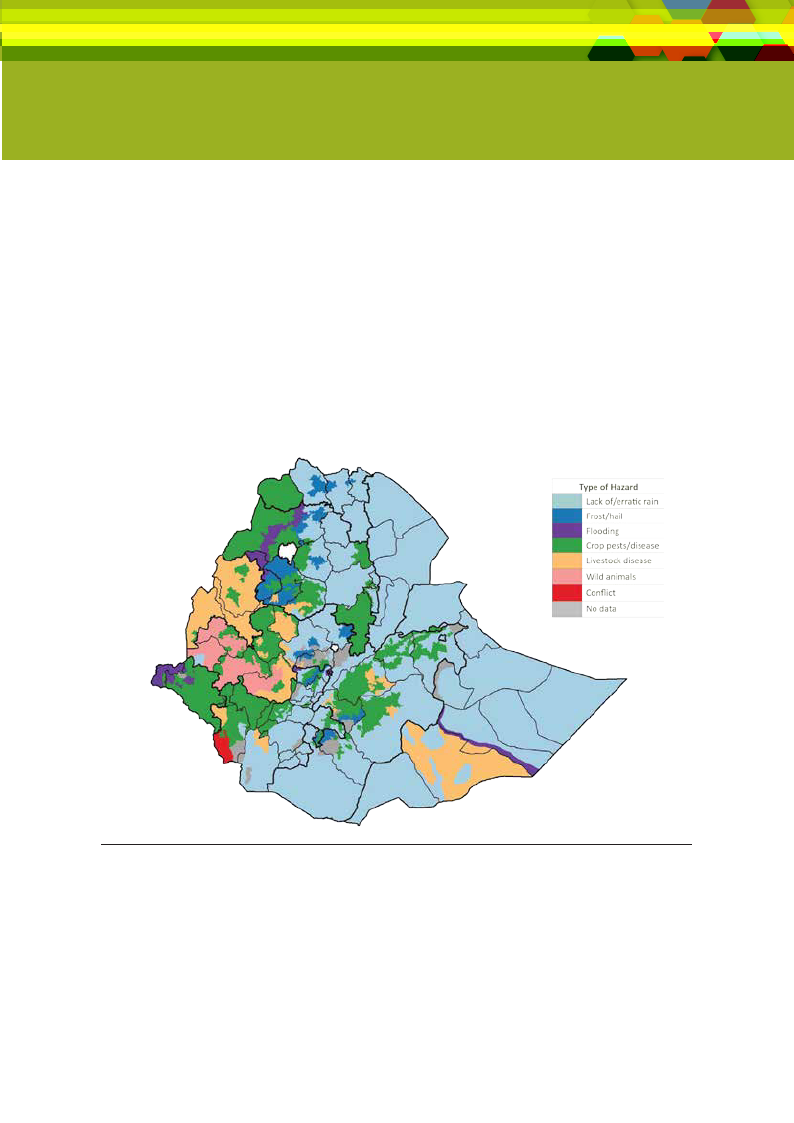
Part 1: Introduction
1.1 Overview of DRM in Ethiopia
Ethiopia has experienced substantial progress in economic, social, and human
development over the past decade, achieving rapid and inclusive economic growth
averaging 10.9 percent per year since 2004. At the same time, it has faced a series of
disasters with increased intensity, coverage, and frequency, largely due to the country’s
diverse geographic, agro-climatic, and socio-economic conditions, partnered with climate
change induced factors. The lack of predictable rain, flooding, crop diseases, livestock
diseases, wild animals’ habitat disturbance, and conflicts (i.e., inter-clan or inter-ethnic)
are some of the most important hazards perceived by rural households (Figure 1.1).
Figure 1.1 The most important hazard perceived by rural households (Government of Ethiopia, 2011)
Figure 1.1 shows the single most important perceived short-term hazard faced by
rural people from year to year. However, the hazard is not necessarily occurring at the
same place every year. For example, in drought predominated areas, crop and livestock
diseases cause consistent losses (Figure 1.1). The ‘Livelihoods Atlas for Ethiopia’
identified crop and livestock diseases as one of the several constraints for both poor and
well-off households (Figure 1.2 and 1.3).
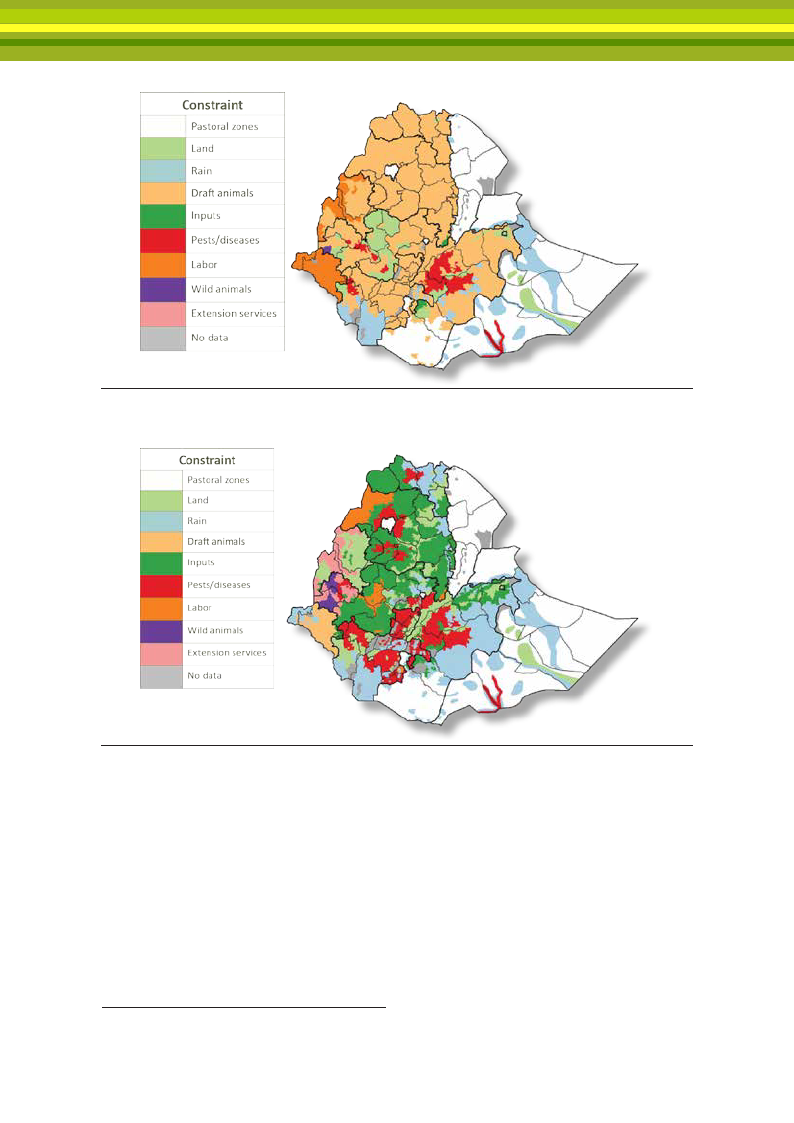
Figure 1.2 Most Important Perceived Constraints for Poor Households (Government of Ethiopia, 2011)
Figure 1.3 Most Important Perceived Constraints for Well-off Households (Government of Ethiopia, 2011)
In addition to drought, the country frequently faces flash floods and river floods.
Flash floods and seasonal river floods are becoming increasingly common due to the
combined effects of deforestation, land degradation, increasing climate variability, and
settlement patterns (World Bank, 2009). Torrential rains and corresponding flash floods
in 2016 left at least 236,890 people displaced (Reliefweb, n.d.). The belg1 rains, though
late in onset, were heavier than usual both in terms of intensity and geographic
coverage, which is a manifestation of strong impacts of climate variability. Additionally,
the floods hit on the back of nearly 18 months of drought that left communities’ coping
capacity weakened. Human and livestock epidemics, and urban and forest fires are
other kinds of hazards that communities in Ethiopia face nearly every year.
1 Belg is the main rainy season for south and southeast regions of Ethiopia and is considered the short rainy season in
the agrarian (north, northwest, west and central Ethiopia) regions. It starts at the end of February and continues through
mid-May.
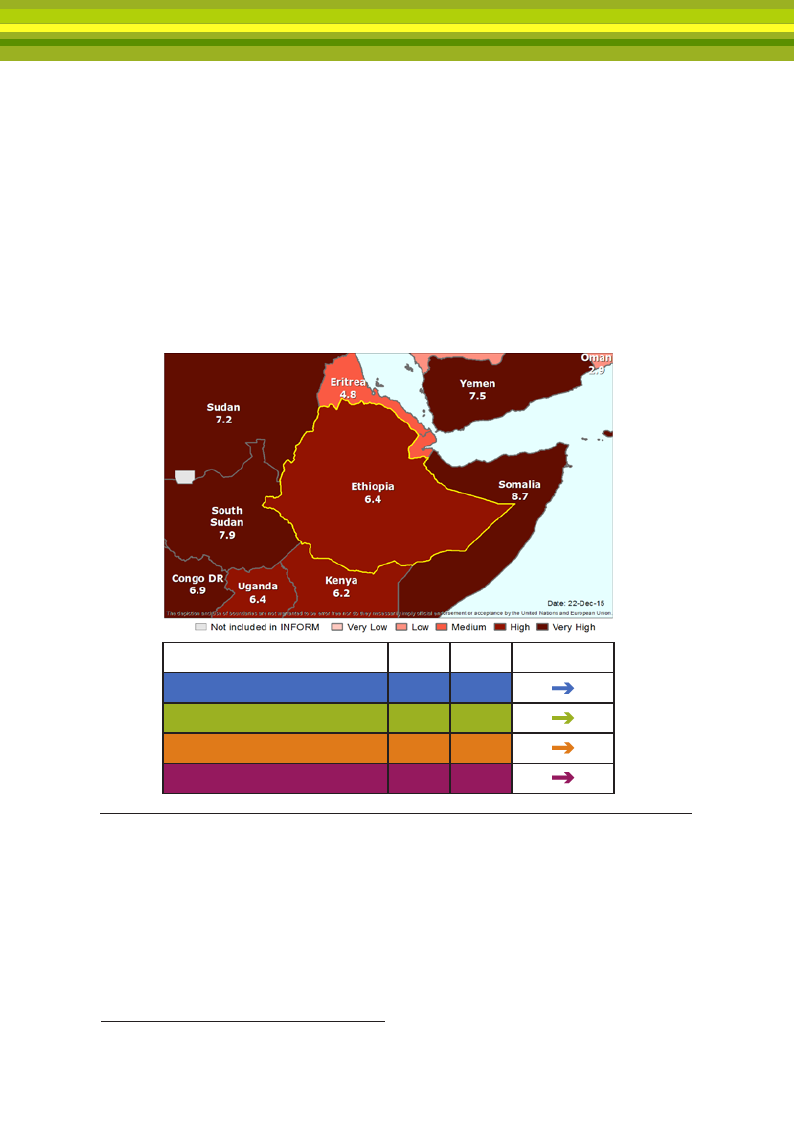
As per the INFORM2 2017 Risk Index (Figure 1.4), the current level of risk and the trends
in recent years in Ethiopia have remained high in terms of multifaceted hazards.
The elements of risk, as well as the coping capacity of Ethiopia, are presented in Figure
1.5. More than 10 million Ethiopians required relief food assistance in 2016 (World
Food Programme, 2016). This poses a huge challenge to the government and
development partners in responding to the current situation and creates challenges
for putting risk reduction measures in place.
Droughts that are exacerbated by El Niño (World Food Programme, 2016), combined
with extensive flooding, resulted in disease outbreaks and the disruption of basic
public services, which all are having a negative impact on the lives and livelihoods of
9.7 million Ethiopians (UNOCHA, 2017). Long-term measures are, therefore, needed
to meet these challenges.
INFORM Risk6
Hazard & Exposure
Valnerability
Lack of Coping Capacity
Value
.4
5.63
6.71
6.9
Rank
15
8
0
28
Trend (3 years)
Figure 1.4 Ethiopia INFORM Risk Index (Source: Inform, 2017)
2 INFORM is a global, open-source risk assessment for humanitarian crises and disasters. It can support decisions about
prevention, preparedness, and response. Details can be found at http://www.inform-index.org.
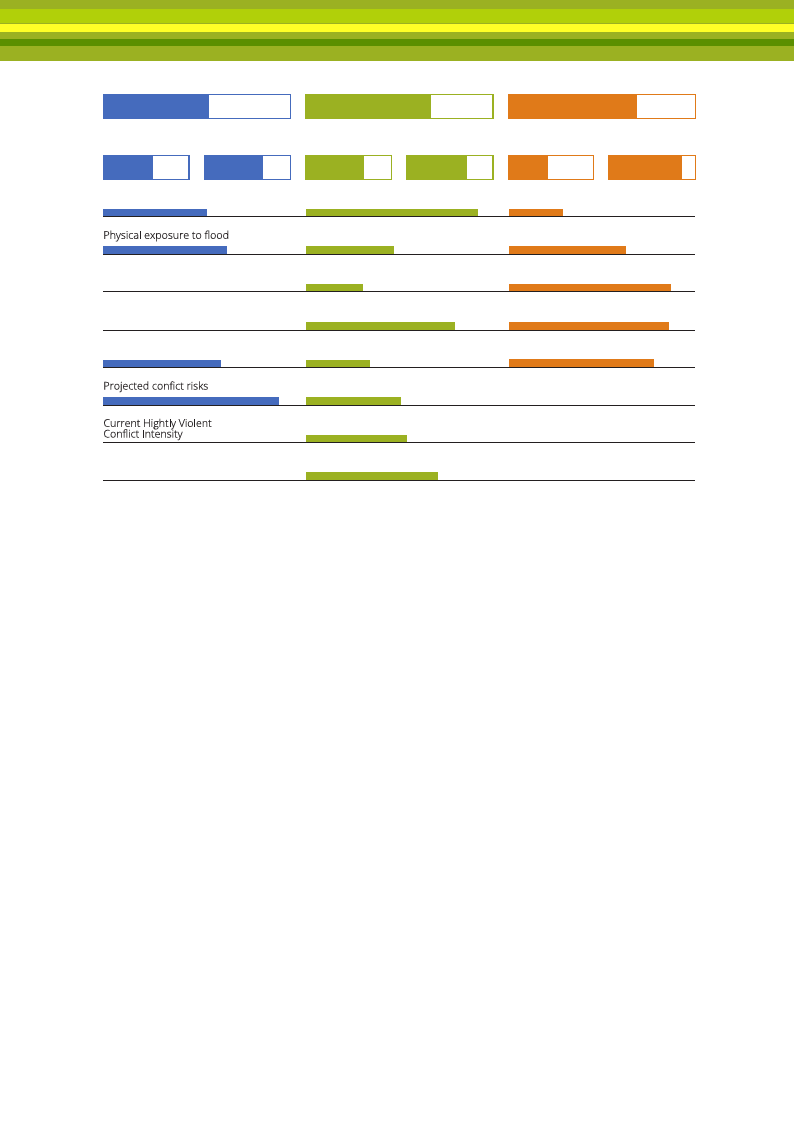
Hazard & Exposure
5.6
Vulnerability
6.76
Lack of Coping Capacity
.9
Natural
4.36
Human
.7
Socio-Economic
6.56
Vulnerable Groups Institutional
.9
4.68
Physical exposure to eartquake 5.55 Development & DeprivationD
.5 RR
Infrastructure
.4
2.9
6.6 Inequality
4.7 Governance
6.3
Physical exposure to tsunami
0.0 Aid Dependency
3.0 Communication
8.7
Physical exposure to
tropical cuclone
Droughts probability &
historical impact
0.0 Uprooted people
6.3 Health Conditions
9.4 Children US
8.0 Physical Infrastructure
8.6
3.4 Access to health care
7.8
5.1
0.0 Recent Shocks
5.3
Flood Security
7.1
Figure 1.5 Hazard & Exposure, Vulnerability and Lack of Coping Capacity
With 60-70 percent of the population’s livelihood dependent on livestock in one way or
another in Ethiopia (Kimball, 2012), the reliance on livestock can be classified into two
groups: those living in the rural highland areas; and those in the pastoral lowland
communities. The livelihoods of the majority of people in the rural highlands depend on
the crop-livestock mixed farming system, while pastoralists rely more on livestock than
any other population category in the country.
Livelihood Context
In Ethiopia, there are four main livelihood production systems across over 170 livelihood
zones, namely cropping, pastoralism, agro-pastoralism, and others (i.e., households
with either no livestock for herding or no land for cropping, that make their
livelihood through a variety of means, including casual labor, petty trading, personal
communication, and seasonal farmland renting) (DRMFSS, 2014).
These different production systems and livelihood activities are also differently affected
by Ethiopia’s rainfall patterns, water scarcity and insecurity, reduction in land ownership,
harsh climate, and flooding and drought, among others (Figure 1.6).
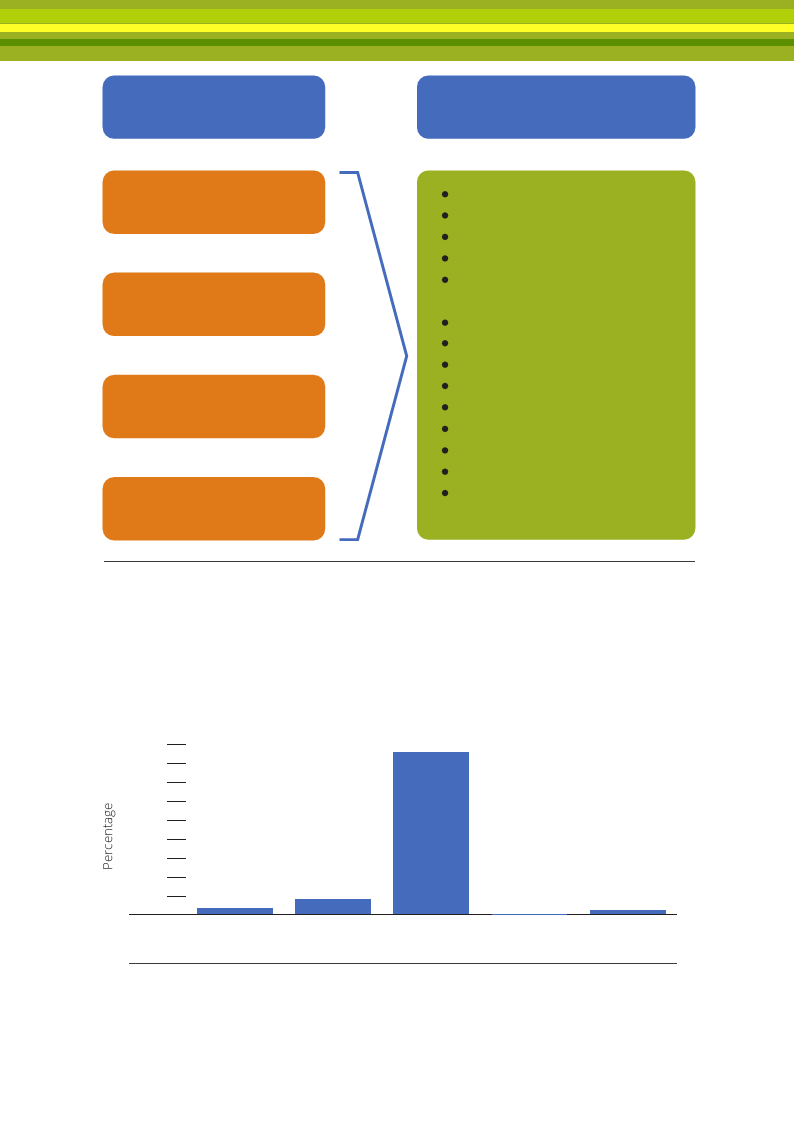
Livelihood Production
System in Ethiopia
Key Constraints
Cropping
Pastoralism
Agro Pastoralism
Others
(casual labor, petty trading, etc.)
Water scarcity & insecurity
Shortage of cultivable land
Less land ownership
Traditional farming
Poor access to infrastructure,
including roads and market
Flooding
Salinity
Shortage of grazing land
Harsh climate
Land degradation
High population density
Illegal trade
Drought hazards
Poor soil fertility and
water quality
Figure 1.6 Key Constraints for Livelihoods in Ethiopia
In relation to disasters, livestock is the second most affected subsector after crops in
developing countries accounting for USD 11 billion, or 36 percent of all damages and
losses reported in the post-disaster needs assessments of the Food and Agriculture
Organization (FAO) of the United Nations (Food and Agriculture Organization, 2015).
Moreover, livestock is mainly affected by the drought hazard noted by the FAO based
on data from post-disaster needs assessments between 2003–2013 (Figure 1.7).
90
80
70
60
50
40
30
20
10
03
.2
Storms
8.4
Floods
85.80
DroughtsT
.2
sunamis
2.3
Earthquakes
Figure 1.7 Average Percentage Share of Damage and Loss to Livestock by Type of Hazard (2003-2013) (FAO,2015)

A 2016 FAO study noted that the severe drought in 2015-2016 left 9.2 million people
food insecure in the south-eastern regions of Ethiopia (FAO, 2016). The limited
seasonal October-December rains sent shockwaves throughout southern and south-
eastern pastoral areas of SNNPR, Oromia and Somali Regions, and led to a widespread
scarcity of pastures and water (FAO, 2016). Livestock body conditions deteriorated
and thousands of animals died. Meanwhile, the prices for livestock declined in
response to the glut of animals brought to the market, disfavoring terms of trade for
livestock owners (see Box 1.1).
Box: 1.1 New Drought Affected Southeastern Regions (2015-2016)
In 2015-2016, drought induced by the El Niño phenomenon severely disrupted the
productivity of livestock and crop-dependent communities in Ethiopia. Incomes of the
farming households were reduced and seed supplies depleted due to two consecutive
failed seasons – the belg (spring rain) and meher (summer rain) of 2015. As a result, 1.7
million households were identified as seed insecure at the start of 2016, 88 percent of
which were successfully reached with emergency agricultural inputs for the meher season
by FAO and other humanitarian actors.
Additionally, stress sales of animals by livestock-dependent households were widespread
throughout much of 2015 and early 2016, and milk and meat production declined
considerably in affected areas. The response in the livestock sector remains underfunded,
with just USD 13 million raised, paling in comparison to the USD 35 million FAO estimates
raised by humanitarian actors for seed distribution. In pastoral and agro-pastoral areas of
the southeast, families face deepening vulnerability due to poor rainfall and a potentially
long dry period until the onset of the 2017 spring rains in March-April.
In August, the Mid-Year Review of the Humanitarian Requirements Document indicated that
2.4 million households require urgent livestock assistance until the until at minimum the
end of 2016, and potentially beyond. National-level food insecurity remains high, with 9.7
million people considered food insecure. Just less than one-third of the country’s weredas
(districts) were classified as Priority 1 hotspot areas, having decreased only slightly from 224
in March to 206 in July. The hotspot classification findings are critical for the prioritization
and allocation of resources to affected weredas.
Challenges Facing Food and Agriculture
The 2011-2016 drought has affected livestock-dependent households in southern zones
of Oromia, Somali Regions and South Omo Zone in SNNPR, with dry spells likely to last until
the spring rains of 2017. The deyr/hageya short rains (October to December), accounting
for up to 35 percent of annual rainfall in these areas, have been influenced by a negative
Indian Ocean Dipole, a phenomenon causing poor precipitation across East Africa. A dearth
of pasture and dwindling water supplies in the southern and south-eastern rangelands
has led to a sharp deterioration in livestock body conditions. Disease outbreaks have also
been widely reported; of the 6000 livestock deaths reported since October in Oromia
Region, 2000 animals reportedly died of opportunistic diseases linked to low body weight,
according to regional authorities. Tens of thousands of livestock across the affected regions
were unable to stand without assistance.
6

In addition to water trucking, pasture is in acute demand, as hundreds of thousands of
livestock critically require it for survival, along with supplementary feed. Livestock prices
continued to plummet due to excessive supplies of weak and vulnerable animals being
brought to market. The impact in terms of trade for livestock owners has been significant,
and households would have to sell more animals to purchase commodities, exposing them
to greater food insecurity. A large influx of livestock has migrated into Somali and Oromia
Regions from Somalia and Kenya, which were also experiencing drought and is a cause for
concern. This is putting additional strain on the already limited resources in these regions.
More than 322,000 refugees from conflict-embroiled South Sudan are now living in the
Gambella Region. With inadequate resources and livelihood options, both refugees and
host communities face high levels of food insecurity. Wheat rust disease has affected more
than 45,000 households in Amhara, Oromia, SNNP and Tigray Regions since August. High
fungicide costs and limited supplies are affecting disease management.
Source: (FAO, 2016)
The above case example further confirms the significant impact of disasters on the lives
of people and on the country’s social, economic, and political development. Not only do
disasters impose serious economic costs for response and rehabilitation, and require
the diversion of national development resources, but they also reverse development
goals and exacerbate poverty.
From a DRM perspective, there is great variability across Ethiopia`s diverse livelihood
systems, which directly affect the depth of household and community resources
available to cope with disasters. A disaster risk management system is required that can
analyze and respond to different livelihood zones in an optimal manner including an
understanding of the most important hazards and their impacts on communities and
national economy.
7

1.2 DRM System and Strutures
DRM Institutional Arrangements
The existing institutional arrangements for Disaster Risk Management (DRM) in Ethiopia are
the result of long institutional growth (Figure 1.8).
Time line (1970s)
1973-74
DRM Institutional Arrangements
1995
2004
2007
Relief &
Rehabilitation
Commission
Established in the wake
of 1973/74 famine
Disaster
Prevention
and
Preparedness
Commission
(DPPC)
Disaster
Prevention
and
Preparedness
Agency (DPPA)
Food Security
Coordination
Bureau (FSCB)
Disaster Risk
Management
and Food
Security
Sector
(DRMFSS)
Time line (2017)
2016
National
Disaster Risk
Management
Commission
Figure 1.8 Timeline Showing DRM Institutional Arrangements in Ethiopia (Illustration from authors)
The first formal governmental disaster management institution was the Relief and
Rehabilitation Commission (RRC), established in the wake of the 1973-1974 famine,
with a mandate to provide relief supplies to drought victims. In 1993, the government
adopted the National Policy on Disaster Prevention and Management (NPDPM). The
NPDPM guided relief management policies, institutions, and processes whereby
drought disasters were detected and resources, especially food aid, were mobilized and
prioritized for affected areas.
A major shift took place in 1995 when the Disaster Prevention and Preparedness
Commission (DPPC) was created, with significant changes in the mandate particularly
emphasizing the link between relief and development. Another major change occurred
in 2007 as a result of business process re-engineering, where the rights and obligation
of the Disaster Prevention and Preparedness Agency were transferred by proclamation
to the Ministry of Agriculture and Rural Development (MoARD), which led to the
establishment of the Disaster Risk Management and Food Security Sector (DRMFSS)
within the MoARD.
This institutional arrangement in 2007 brought a paradigm shift in the approach to
disaster management in terms of moving from a drought and relief focused approach
to a more proactive, multi-sectoral, and multi-hazard DRM approach. In 2015–2016,
the National Disaster Risk Management Commission (NDRMC) was established by
Regulation No.363/2015 under the Prime Minister’s office by transforming the
DRMFSS to a full-fledged Commission. This has significantly strengthened its legal and
operational framework for a comprehensive and integrated National DRM system at
national and local levels.
8
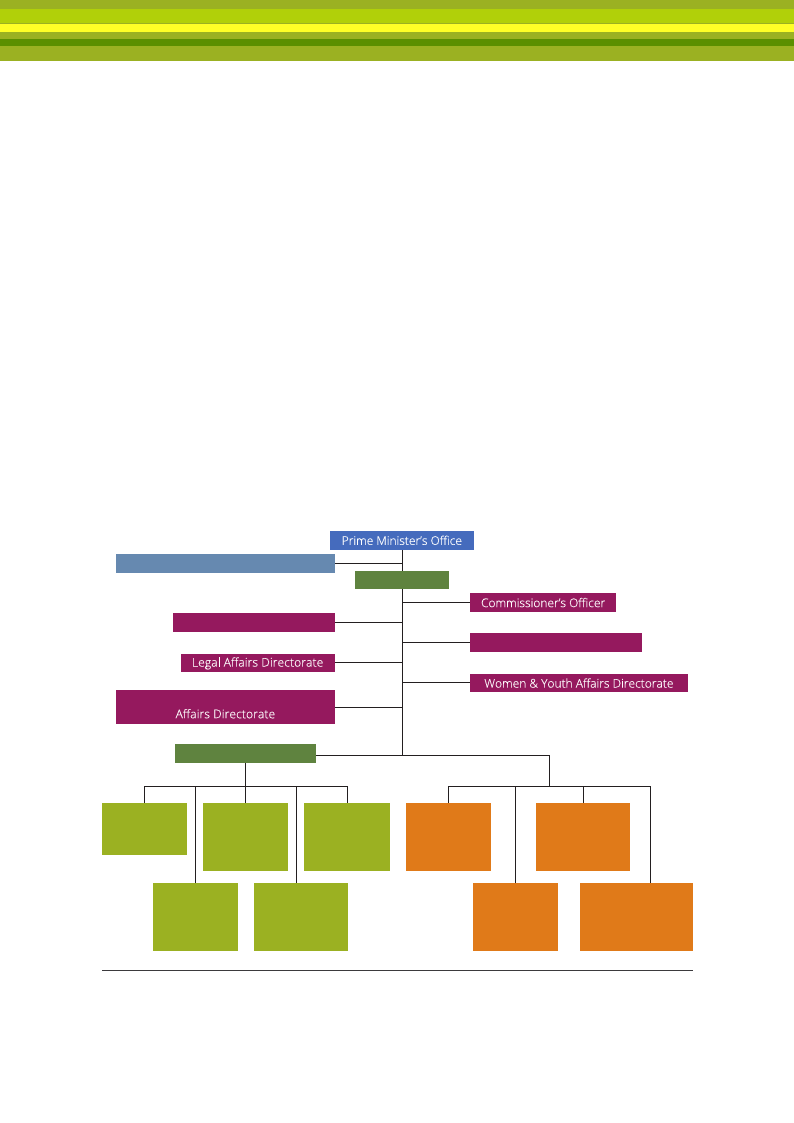
National Disaster Risk Management Commission
The NDRMC is expected to ensure a more streamlined DRM approach, including an
Early Warning and Response System across all government sectors, at the federal,
regional, wereda, Kebele, and city levels. This will be achieved by broadening its scope
to encompass the urban and industrial sectors, and by widening its approach to focus
on preventive and ex-ante aspects of DRM. In addition to the regular ex-post recovery
and response functions of DRM, the entire process will remain in line with its National
Policy and Strategy on Disaster Risk Management, which was adopted in 2013. The
NDRMC reports its DRM related activities and issues to the Disaster Risk Management
Council (DRMC), chaired by the Prime Minister or his/her deputy under the Proclamation
No-363/2015.
The NDRMC is responsible for coordinating disaster response, risk management,
preventive measures and recovery programs in the country. The commission functions
through a well-established structure (Figure 1.9), and duties and responsibilities are
clearly listed in the Council of Minister’s regulation no. 363/2015. Overall, the NDRMC
has a vision of reducing disaster risks and potential damages caused by a disaster
through establishing a comprehensive and coordinated DRM system in the context of
sustainable development.
National Disater Risk Management Commission (NDRMC)
Organizational Structure
Disaster Risk Management Council
Internal Audit Directorate
Commissioner
Public relation’s Directorate
Planning, Reform & Good Governance
Deputy Commissioner
Disaster Risk
Reduction
Directorate
Disaster
Response &
Rehabilitation
Directorate
Supplies &
Logistics
Directorate
Early Warning
& Emergency
Response
Fund Raising &
Management
Directorate
Human
Resource
Management
Directorate
Supply &
Property
Administration
Directorat e
Budget &
Finance
Directorate
Information
Communication
Technology
Directorate
Figure 1.9 NDRMC Organizational Structure (NDRMC, 2017)
9

The Ministers Regulation no.363/2015 clearly defines the roles and responsibilities
of NDRMC, which provides clear direction to the commission in order to achieve the
DRM policy vision: “Capacity for withstanding the impact of hazards and related
disasters is built at national, local, community, household and individual levels; and
damages caused by disasters are significantly reduced by 2023”. The 17 core activities
are briefly described in Box. 1.2.
Box 1.2 National Disaster Risk Management Commission: Duties and
Responsibilities as Stated in Regulation No.363/2015
i) Ensure that DRM is mainstreamed into government development policies, strategies,
development plans and programs, and in the plans of the private sector, and in
school curricula; and provide support, as may be necessary, to concerned bodies in
relation to such issues;
ii) Ensure and follow-up the inclusion of DRM in the plan of the executive organs, which
are identified as lead sector institutions in the Disaster Risk Management Policy and
Strategy document;
iii) Collect and compile nationwide action plans for the implementation of DRM policy
and strategy; regularly monitor and evaluate implementation of the same, and
submit at least bi-annual performance reports to the Disaster Risk Management
Council;
iv) Coordinate, follow up and evaluate disaster risk reduction, disaster response and
rehabilitation programs of disaster victims;
v) Implement, lead, and coordinate responses in the event of disasters that either do
not fall under the responsibility of any one of designated lead sector institutions or
a sudden disaster that is beyond the capacity of the lead sector institution;
vi) Hold and administer disaster response fund, relief food, and non-food stock;
vii) Whenever necessary, distribute emergency relief food supplies upon discharging
from concerned government institution in charge of administration of the
strategic food reserve;
viii) In collaboration with concerned bodies, lead and coordinate work on the
development and revision of disaster risk profiles at the national level;
ix) On the basis of the disaster risk profile, develop and implement comprehensive
contingency plans at all levels; facilitate conditions to undertake regular and
planned simulation exercises at all levels to assess existing emergency response
preparedness, including the contingency plan, and take corrective measures
accordingly;
x) Lead and coordinate studies and assessments conducted at the national level
before, during, and after the disaster period including a disaster risk forecaster;
xi) Lead and coordinate the Federal Early Warning and Emergency Coordination
Center by supporting it with modern technologies; support the establishment of
similar center in lead sector institutions at Federal, Regional, Zonal and Wereda
Administration levels, as required;
xii) Facilitate conditions and provide support for wider application of information and
communication technologies for disaster risk management; serve as a repository
for disaster risk management information at the national level and provide support,
as required, to enable the Regional Administrations to set up a similar repository;
xiii) Following the official declaration of a disaster and upon the decision of the Disaster
Risk Management Council, mobilize resources from domestic and international
sources;
xiv) Utilize secured resources by itself and through other concerned lead sector
institutions found at Federal and Regional Administrations levels for emergency
response;
10

xv) In collaboration with concerned bodies, establish and operate a mechanism to
enable the disaster risk management system to get comprehensive support from
volunteers organized on a voluntary basis and engaged in result oriented disaster
risk management activities;
xvi) In accordance with the relevant laws and directives of the country, establish working
relationships and collaborations with relevant international organizations,
governmental, and private organizations to facilitate the smooth implementation of
the National Disaster Risk Management Policy and Strategy;
xvii) Own property, enter into contracts, sue and be sued in its own name; and
xviii) Perform other necessary related activities to meet its objectives.
DRM Policy
A National Policy and Strategy on Disaster Risk Management (NPSDRM) was developed
in 2014, and includes general directions and major implementation strategies for
Ethiopia. The overall objective of the National Policy and Strategy on DRM is to, “Reduce
disaster risks and potential damage caused by a disaster through establishing a
comprehensive and coordinated disaster risk management system in the context of
sustainable development.”(Government of Ethiopia, 2013, “National Policy and Strategy
on Disaster Risk Management”, para. 3.
The policy is composed of the following directions and strategies:
• Early warning and disaster assessment information informed response
• Official disaster declaration system
• Decentralized disaster risk management system
• Mainstreaming of disaster risk management into sectoral institutions
• Source of resources and resource mobilization procedures
• Information management and communication systems
• International cooperation
• Implementation capacity
• Cross cutting issues: DRM to give special attention to: a) women, children, elderly,
and persons with disabilities; b) people living with HIV/AIDS; and c) social and
environmental issues.
Overview of Strategic Program and Investment Framework: A Disaster Risk
Management Framework in Ethiopia
As part of its long-term program for establishing a robust DRM system in the country,
the Disaster Risk and Management Strategic Program and Investment Framework
(DRM-SPIF) was developed and ratified in 2014, which aims at promoting a paradigm
shift from response and recovery to a multi-sectoral and comprehensive approach that
focuses on disaster prevention, mitigation, and preparedness.
The SPIF provides a strategic framework for the prioritization and planning of
investments that will drive Ethiopia’s DRM system. It is designed to operationalize the
DRM policy by identifying priority investment areas with estimates of the financing
needs to be provided by the government and its development partners. The SPIF is a
strategic framework that outlines major areas of investment that can then be more fully
fleshed out with development partners moving forward.
11

The SPIF focuses on the creation of a comprehensive system for managing disaster risk
that builds upon past lessons and works to increase cross-sectoral multi-agency
integration. The main components of the DRM system already exist, and several of
them have made important progress in effectiveness in recent years. However, the
components do not function adequately as an integrated system and this limits the
overall effectiveness. This requires scaling up efforts in the disaster risk management
sector, further developing capacity, and ensuring full synchronization and strategic
complementary of the numerous initiatives and interventions.
The SPIF envisions a whole-of-government initiative led by the DRMFSS that reflects the
priorities of the government and a wide range of stakeholders. The SPIF is fully aligned
with the Growth and Transformation Plan (GTP), a successor to the Plan for Accelerated
and Sustained Development to End Poverty (PASDEP), which realized an average annual
growth rate of 11 percent for the past five years for the country. The GTP sets the vision
for the country as a middle income, democratic and developmental state, and a carbon
neutral climate resilient economy by 2025.
Moving towards the implementation of the NPSDRM and DRM-SPIF, the 2015
establishment proclamation has given NDRMC the authority and autonomy to bring in
multiple stakeholders including various sectoral ministries, donors, UN agencies, and
various civil society organizations through formation of various structures to address
sectoral interventions. The structure is in place (Figure 1.10) for addressing various
disaster management aspects in holistic manners by facilitating convergence between
disaster response and long-term resilience building.
The Disaster Risk Management Technical Working Group (DRMTWG), co-chaired by
the NDRMC, is primarily responsible for coordinating DRM strategic program in the
country. It also supports the implementation of the new multi-sectoral and multi-
hazards DRM approach in Ethiopia, in addition to providing a platform for the mutual
engagement and support of humanitarian organizations and development partners.
The DRMTWG continues to work as the nodal coordination forum on all DRM phases –
pre-disaster (prevention, mitigation, and preparedness), during disaster (response), and
post-disaster (recovery and rehabilitation).
The DRMTWG is supported by a set of Technical and Sector Task Forces. These Task
Forces are primarily responsible for the coordination and actions under each sector
and are headed by respective relevant government line ministries. They are supported
by organizations from other line ministries, UN agencies and civil society organizations.
Cross-cutting to all these is the Working Group on Mainstreaming Gender in DRM that
will work with DRMTWG and all other sector Task Forces to mainstream discussions
on vulnerabilities associated with gender, and other socially vulnerable groups.
12
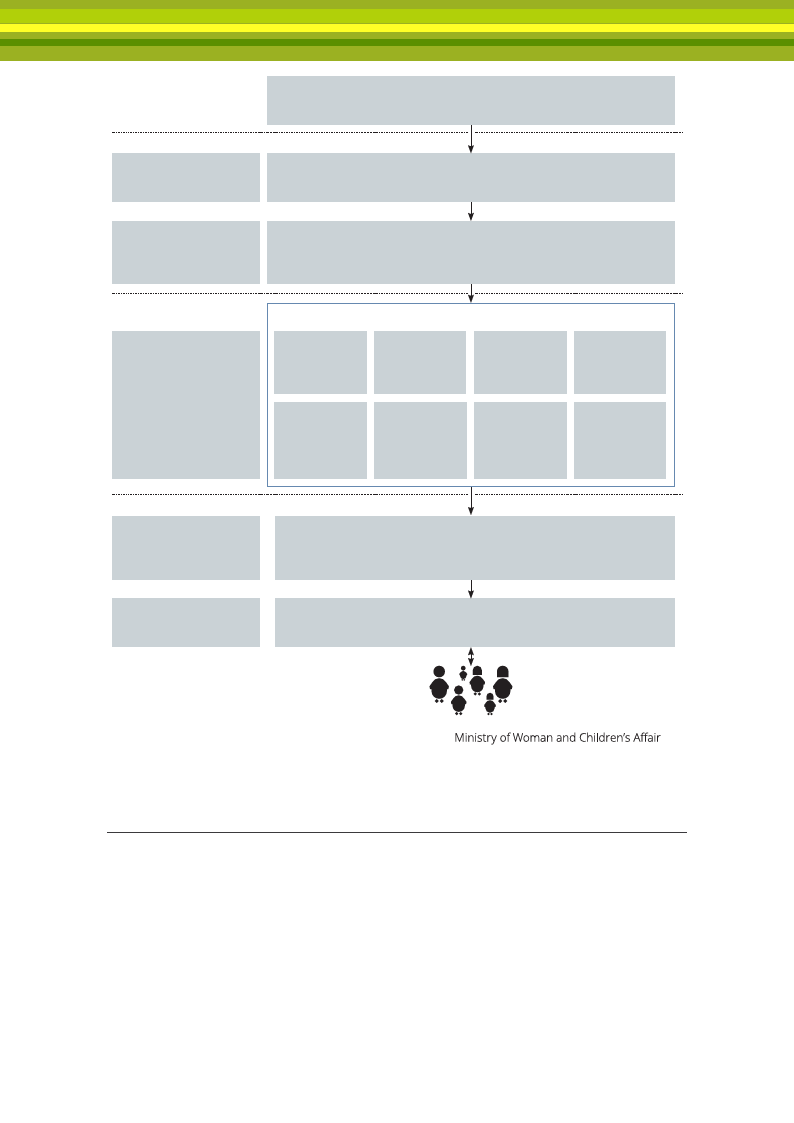
Political
Strategy
NDRMC
National Disaster Prevention & Preparedness Committee (NDPPC)
Chair: DPM
Members: line ministries
National Technical Committee
Chair: NDRMC
Members: line ministries
Multi-agency
Coordination (S-MAC)
Chair: Commissioner
Co-chair: HC
Disaster Risk Management Technical Working Group (DRMTWG)
Chair: NDRMC
Co-chair:OCHA
Members: line ministries, UN, NGO and donors at the technical level
Federal
Emergency Task Forces
(Government-led, multi-
agency coordination)
Regional
Regional DPPC
Sectoral task forces
Agriculture &
livestock
Chair: NDRMC
Co-chair: FAO
Food security
Chair: NDRMC
Co-chair:WFP
Health &
nutrition
Chair: MoH
Co-chair: WHO
Nutrition
Chair: NDRMC/
ENCU
Co-chair: UNICEF
WASH
Education
Chair: MoWIE
Chair: MoE
Co-chair: UNICEF
Co-chair:
UNICEF/Save the
Children
Emergency
shelter & NFIs
Chair: ICM
Child protection
Chair: MoWIE
Co-chair: UNICEF
Regional Disaster Risk Management Technical Working Group
(RDRMTWG)
Chair: DPPC Heads
Members: Sector Bureau, Humanitarian partners
Regional
Regional Task Forces
Chair: DPPC Heads
Members: Regional Bureaus, Humanitarian partners
Population
ENCU
FAO
HC
IOM
MoE
MoH
Emergency Nutrition Coordination Unit
Food and Agriculture Organization
Humanitarian Coordinator
International Orgnaization for Migration
Ministry of Education
Ministry of Health
MoWCA
MoWIE
NDRMC
UNICEF
WFP
Ministry of Water, Irrigation and Electricity
National Disaster Risk Management
Commission
United Nation;s Children Fund
World Food Program
Figure 1.10 Government Coordination Structure in Ethiopia (NDRMC, 2017)
DRM Challenges
The DRM system in Ethiopia has been evolving rapidly in recent years, with substantial
progress made in building the overall system envisioned in the DRM policy. This provides a
dynamic base upon which to develop future improvements to the system. In order to achieve
goals and objectives of the National Policy and Strategy on Disaster Risk Management, it is
essential that the existing gaps are identified and addressed (Table 1.1).
The following section briefly discusses DRM issues or gaps and challenges in Ethiopia, which
are mostly drawn from the DRM-SPIF analysis (DRMFSS, 2014) and ADPC’s assessment
report (ADPC, 2017).
13

Table 1.1 DRM Gaps/Issues/Challenges in Ethiopia
Gap Type
Gaps/Issues/Challenges
Systems
Level
• Lack of sector-wide linkages and synergies
• DRM has been implemented in a fragmented
manner using separate instruments, process, and
institutions without integration
• In the existing system, much of the DRM budget is
mobilized for response without enough investment
in building resilient households including protec-
tion from shocks
• Weak coordination among multiple government
and other agencies responsible for disaster pre-
vention and mitigation
Institutional • Organizational structures do not have harmonized
Level
roles and responsibilities at federal, regional, and
wereda levels, which can lead to duplication of ef-
forts in key functional areas
• Capacity limitations include physical office space,
equipment, communications including appropriate
technology, and other facilities
DRM compo- • Existing contingency plans are limited in scope and
nents
overall DRM planning are not yet fully aligned to
targeted development plans
• Risk assessment, monitoring and early warning
products (WDRP, LIAS, and the EWS) are not fully
harmonized within one system, which reduces ef-
ficiency
• Communities and development sectors are fully
involved in the contingency planning process at
the wereda level, but the processes are not fully
adopted by sectors for implementation as a result
of low diffusion of knowledge about agreed pre-
paredness measures
• Gaps in preparedness in terms of contingency
planning, early warning, and the linkages to re-
sponse
• Task force structure is currently being decentral-
ized to the regional level, and is only formally pres-
ent in a handful of regions
• EWS is not yet a truly multi-hazard information
collection and dissemination tool, as the major-
ity of data gathered relates only to food security
and drought issues. Furthermore, the ‘backflow’ of
information is weak
• Knowledge base on DRM in Ethiopia remains low
and requires enhancement
• Work of sectoral task forces has been mostly
response-focused
• Gaps in recovery and rehabilitations: 1) no stan-
dard methodologies in practice to assess recovery
needs or to implement recovery activities, and 2)
widespread and fragmented responsibility for re-
covery and rehabilitation across multiple agencies
Remark
For example, NDRMC
and MEFCC have a
cross-cutting man-
date that requires in-
tegration with other
sector ministries
For example, there
is a lack of adequate
communication facili-
ties to transmit early
warning and risk and
vulnerability assess-
ment information
Disaster Risk Re-
duction (DRR) and
contingency planning
were not integrated
with development
priority activities of
respected line minis-
tries and agencies
14

Gap Type
Other
Gaps/Issues/Challenges
Remark
• Disaster insurance is not yet available, though
Land use planning
there are some risk financing mechanisms in their and land suitability
early stages
consideration are not
• Building Code EBCS-8 deals specifically with the
seriously considered
design of structures for earthquake resistance, but as per recommenda-
there are gaps in implementation and enforcement tions made by Envi-
• DRR considerations are not featured in the plan- ronmental and Social
ning process for private constructions under the Impact Assessment
Ethiopian Building Proclamation 624/2009
(ESIA) studies
Source: (DRMFSS, 2014; ADPC, 2017)
15

References and Additional Reading:
Asian Disaster Preparedness Center (ADPC). (2017). Assessing DRM capacities of NDRMC. Bangkok.
Benson, C. & Twigg, J. (2007). Tools for Mainstreaming Disaster Risk Reduction: Guidance Notes for Development
Organizations. Prevention Consortium. Retrieved from http://www.preventionweb.net/files/1066_toolsformain-
streamingDRR.pdf
Disaster Risk Management and Food Security Sector (DRMFSS). (2014). Disaster Risk Management Strategic
Programme and Investment Framework. Ministry of Agriculture, Government of Ethiopia. Retrieved from http://
www.dppc.gov.et/downloadable/Documentation/DRM%20SPIF%202014%20-%20Final.pdf
Relief Web (n.d.). Ethiopia: Floods - Apr 2016. Retrieved August 24, 2017, from http://reliefweb.int/disaster/fl-
2016-000045- eth
Food and Agriculture Organization (FAO). (2015). The Impact of Natural Hazards and Disasters on Agriculture and
Food Security and Nutrition. A Call for Action to Build Resilient Livelihoods. Retrieved from http://www.fao.org/3/
ai4434e.pdf
Food and Agriculture Organization (FAO). (2016). Ethiopia: Situation Report – November 2016. Retrieved from
http://www.fao.org/3/a-bs138e.pdf
Government of Ethiopia. (2013). National Policy and Strategy on Disaster Risk Management. The Federal
Democratic Republic of Ethiopia, Addis Ababa.
Government of Ethiopia. (2011). An Atlas of Ethipian Livlihoods. Retrieved from http://foodeconomy.com/wp-
content/uploads/2016/02/Atlas-Final-Web-Version-6_14.pdf%0D
Kimball, T. (2012). Livestock Production Systems and their Environmental Implications in Ethiopia. Retrieved from
http://web.colby.edu/eastafricaupdate/files/2012/02/Environmental-Policy-Review-2011_Chapter-3_color_
small.pdf
National Disaster Risk Management Commission (NDRMC). (2017). Capacity Building Support to National Disas-
ter Risk Management Commission, Government of Ethiopia. The Federal Democratic Republic of Ethiopia, Addis
Ababa
OCHA. (2017). Weekly Humanitarian Bulletin, Ethiopia. Retrieved from
http://reliefweb.int/sites/reliefweb.int/files/resources/02_january_hb_final.pdf
Trobe, L., Sarah, & Davis, I. (2005) Mainstreaming Disaster Risk Reduction: A Tool for Development Organizations.
Tearfund. Retrieved from https://www.unisdr.org/2005/HFdialogue/download/tp2-Tearfund-Mainstreaming-
drr.pdf
World Bank. (2009). Disaster Risk Management Programs for Priority Countries: Africa. Global Facility for
Disaster Reduction and Recovery. Retrieved from http://www.unisdr.org/files/14757_6thCGDRMProgramsforP
riorityCountrie.pdf
World Food Programme. (2016). WFP El Nino response. Retrieved from http://documents.wfp.org/stel-
lent/groups/public/documents/newsroom/wfp281333.pdf?_ga=2.175537515.877408405.1503618606-
1786875748.1503618606
UNISDR. (2005). Hyogo Framework for Action 2005-2015: Building the Resilience of Nations and Communities to
Disasters. Retrieved from http://www.unisdr.org/files/1037_hyogoframeworkforactionenglish.pdf
UNISDR. (2015). Sendai Framework for Disaster Risk Reduction 2015-2030. Retrieved from http://www.unisdr.org/
files/43291_sendaiframeworkfordrren.pdf
UNISDR. (2015). Proposed Updated Terminology on Disaster Risk Reduction: A Technical Review. Background
Paper. Retrieved from http://www.preventionweb.net/files/45462_backgoundpaperonterminologyaugust20.
pdf
16
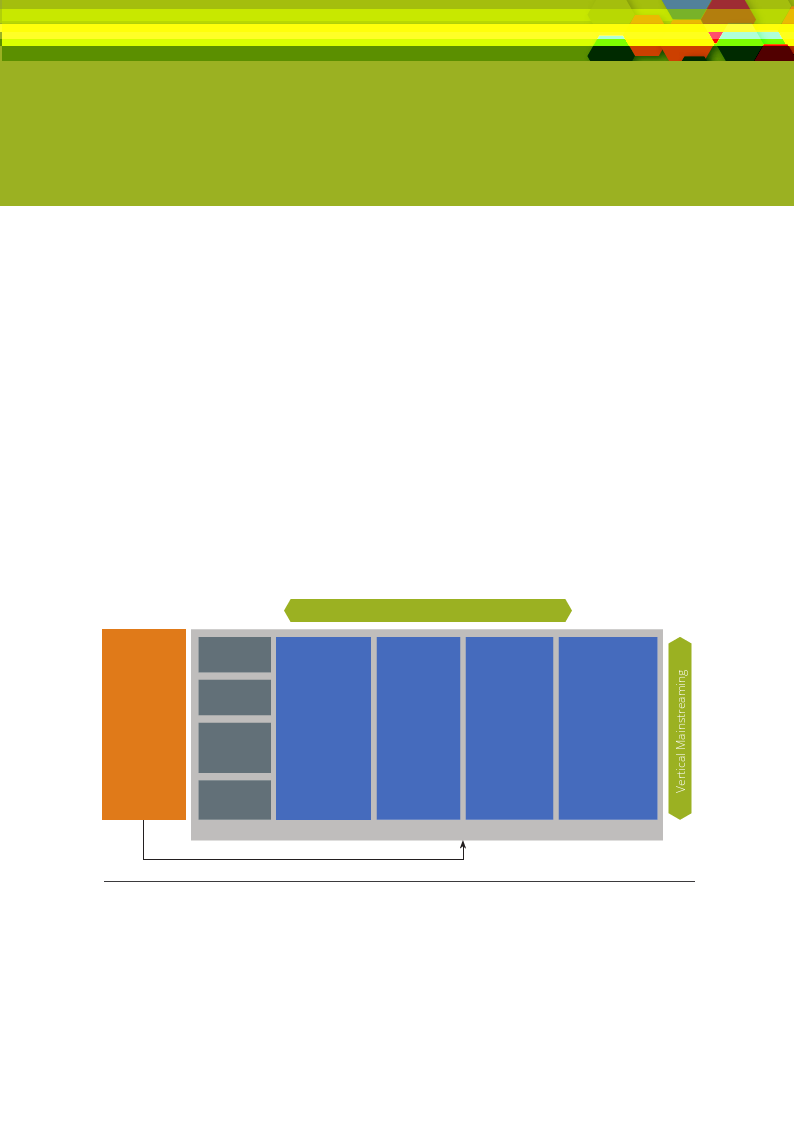
Part 2: Mainstreaming Disaster Risk
Management into Development
2.1 DRM Mainstreaming and its Significance in Resilience Building
Defining DRM Mainstreaming
The most all-encompassing definition argues that DRM mainstreaming means, “to
consider and address risks emanating from natural and anthropogenic hazards in
medium-term strategic development frameworks, in legislation and institutional
structures, in sectoral strategies and policies, in budgetary processes, in the design
and implementation of individual projects and in monitoring and evaluating all of the
above” (Benson, 2009; Benson and Twigg, 2007, p 5).
As illustrated in Figure 2.1, mainstreaming of DRM includes both risk assessment and
risk treatment elements. It can be defined as any actions, processes, and practices
that take into consideration and integrate risk factors and the possible effects of
disasters, and that identify and promote DRM as a key social, economic, environmental,
and developmental agenda priority. It thus seeks to integrate DRM into conceptual
and strategic frameworks, as well as institutional thinking. Furthermore, it seeks to
translate these into programs and activities from the national to local levels, and across
various development interventions (i.e., both vertically and horizontally).
Horizontal Mainstreaming
Disaster Risk
Management
(Risk
assessment &
risk treatment)
National
level
Regional &
zone level
Rural &
urban
Wereda
Development
policy & strategy,
comprehensive
development
plan
Institutional
structure &
mandates,
systems
Development
programs
& projects,
budgeting
Knowledge
& capacity
building for
implementation
Kebele
Development interventions
Figure 2.1 Conceptual Framework for Mainstreaming DRR into Development (Adapted from ADPC, 2014)
17
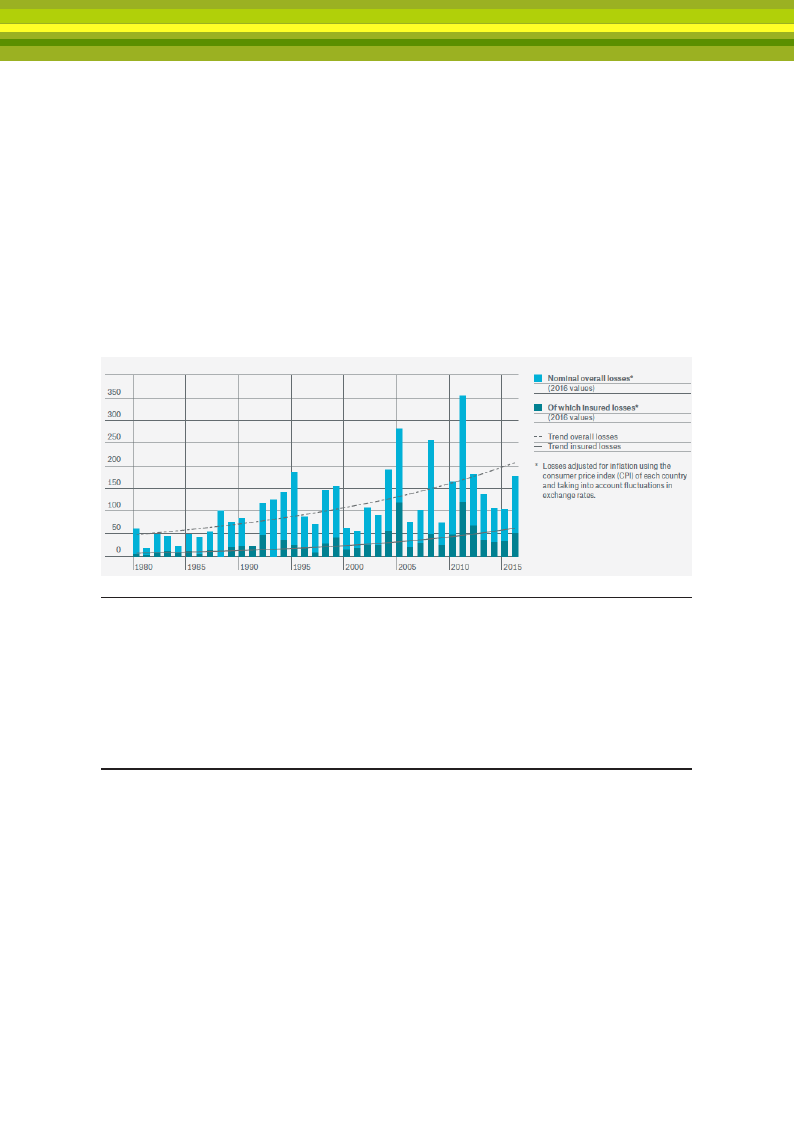
The above concept is successfully applied by countries through creating linkages
between the DRM processes and the existing development planning frameworks.
Essential elements include: 1) accessible, understandable, and recent risk information;
2) assessment of the costs and benefits of potential actions; and 3) development of
appropriate risk treatment measures.
The Importance of Mainstreaming DRM
Development has the potential to create new forms of vulnerability, and exacerbate
existing ones, resulting in the hampering of efforts to reduce poverty and promote
positive development growth. For instance, the frequency and severity of disasters
resulting from natural hazards are increasing (Figure 2.2). Therefore, it is essential that
the process of development planning is able to identify and analyze the underlying
causes of risk and their potential impacts, as well as understand how to develop
measures to reduce potential risk and overall losses (Figure 2.2).
Figure: 2.2 Overall and Insured Losses from the World Natural Catastrophes, 1980 to 2016 (Munich Re, 2017)
In 2016, the National Planning Commission of Ethiopia raised serious concerns over
the impacts of El Niño-caused drought on the country’s GDP 2015-16 (Box 2.1), which
resulted in slow economic growth.
Box 2.1 Ethiopia’s Economic Growth by Eight Percent
The National Planning Commission of Ethiopia reported that the country’s economy
grew by 8% in the 2008 Ethiopian fiscal year (2015-16). In a press briefing, Dr. Yinager
Dessie, Commissioner of the National Planning Commission said the projected target
had been 11% and the main reason for failing to achieve this figure was the worst ever
El Niño-caused drought, which the country faced during the previous fiscal year. The
drought led to failed harvests, and 95% of the country’s meher (main harvest) production
was affected. The economy experienced rapid growth in the manufacturing and service
sectors, but it still remained significantly reliant on agriculture. Inevitably, the El Niño
climate phenomenon hit Ethiopia’s economy hard, with record dry weather undermining
the all-important agricultural sector.
Source: Muktar, 2016
18

One way of protecting development gains and reducing disaster risk is to mainstream
DRM into the development planning from public policy making, to socioeconomic and
physical planning (at all levels and across all sectors), including the allocation of public
resources and staff dedicated for implementation of all development projects in hazard
prone locations. In theory, three key objectives of mainstreaming DRM are defined in
Box 2.2. In addition, mainstreaming is important because DRM is not a sector in itself,
but a process to protect development, reduce losses, and to support growth. It cuts
across sectors and governance spheres.
Box 2.2 Key Objectives of Mainstreaming DRM
• Trobe & Davies (2005) outlined three key objectives of mainstreaming DRM:
• To make certain that all national, sector, and local development programs and projects
are designed with evident consideration for potential disaster risk and to resist hazard
impact.
• To make certain that all national, sector, and local development programs and projects
do not inadvertently increase vulnerability to disaster in all sectors: technical, social,
financial, economic, and environmental.
• To make certain that all national, sector, and local development programs and projects
are designed to contribute to developmental aims and to reduce future disaster risk.
Source: (Trobe & Davies, 2005)
Over the past 10 years, and particularly since the introduction of the Hyogo Framework
for Action (HFA) in 2005 and the Sendai Framework for Disaster Risk Reduction (SFDRR)
in 2015-2030, there has been an increasing recognition of the need to mainstream
DRM into development (Table 2.1).
19

Table 2.1 Priorities for Actions for Mainstreaming DRM
Sendai Framework (2015-2030): Priorities Hyogo Framework for Action (2005 – 2015)
for Actions
Priorities for Actions
Priority 1: Understanding disaster risk
(Example: Promote the incorporation of di-
saster risk knowledge, including disaster
prevention,mitigation, preparedness,
response, recovery and rehabilitation, in formal
and non-formal
education)
Priority 1: Making disaster risk reduction a
priority
(Example: Assess and develop the institutional basis
disaster risk reduction, policy instruments and tools
to support national institutional and legal frame-
works, legal and regulatory)
Priority 2: Strengthening disaster risk gover-
nance to manage disaster risk
(Example: Mainstream and integrate disaster
risk reduction within and across all sectors)
Priority 2: Improving risk information and early
warning
(Example: Establish an initiative for community risk
assessment to combine with country assessment,
review the availability of risk related information
and capacities for data collection and use)
Priority 3: Investing in disaster risk reduc-
tion for resilience
(Example: Promote mechanisms for disaster
risk transfer and insurance, risk-sharing and
retention and financial protection, as
appropriate, for both public and private
investment)
Priority 3: Building a culture of safety and
resilience
(Example: Develop or utilize DRR training for key
sectors based on identified priorities, availability of
education material and relevant training on disas-
ter risk reduction)
Priority 4: Enhancing disaster preparedness
for effective response and to “Build Back
Better” in recovery, rehabilitation and recon-
struction
(Example: Promote the incorporation of disaster
risk management into post-disaster recovery
and rehabilitation processes, facilitate the link
between relief, rehabilitation and development)
Priority 4: Reducing the risks in key sectors
(Example: Environment - Incorporate DRR in
environmental management, Physical planning -
Establish measures to incorporate DRR in urban
and land use planning, Economic development -
Stimulate DRR activities in production and service
sectors)
Priority 5: Strengthen disaster preparedness
for effective response
(Example: Strengthen planning and programing for
disaster preparedness, promote the incorporation
of risk reduction into official post disaster recon-
struction plans and actions)
Source: (UNISDR, 2005, 2015)
Guided by these global frameworks, the Programme of Action for the Implementation
of the Sendai Framework for Disaster Risk Reduction 2015-2030 in Africa further
promotes actions for DRM mainstreaming in Africa, including Ethiopia (Table 2.2).
20

Table 2.2 Priorities for Actions for Mainstreaming DRM
Sendai Framework (2015-2030) Africa Regional Strategy for Disaster Risk Reduction
Priority for Actions
(Programme of Action (Phase I: 2016-2020)
Priority 1: Understanding disas-
ter risk
National: Institutionalize risk assessment and analysis for
risk-informed decision making in all sectors
Example: Integrate DRR in education and training systems,
with adequate resourcing and capacities
Sub-national/ local: Engage and sensitize communities
in risk profiling, monitoring, and assessment for decision
making
Example: Equip national and sub-national officials, CSOs
and local communities, including women and youth, with
knowledge and capacities, including training in participatory
risk assessment, for monitoring and analyzing risk
Priority 2: Strengthening disas-
ter risk governance to manage
disaster risk
National: Formulate, improve and sustain policies, strate-
gies, plans and legal frameworks for DRR and integrate
them into sustainable development strategies
Example: Formulate or reinforce regulations, standards and
codes to incorporate DRR and improve legal and regulatory en-
vironment for enhanced DRR appropriate for rural and urban
areas.
Sub-national/local: Decentralize powers and resources to
catalyse disaster risk reduction actions at the sub-national/
local level
Example: Develop the leadership and capacity of subnational/
local authorities to work with community structures, civil society
and other local partners to advance local DRM
Priority 3: Investing in disaster
risk reduction for resilience
National: Establish, and allocate adequate resources for,
disaster risk reduction investment plans and create an
enabling environment to induce increased investment in
DRR, including through integrating DRR measures in fiscal
and financial instruments and optimizing contribution of
response funds to DRR
Example: Develop risk management and resilience guidelines
on safety of schools, health facilities and critical infrastructure
Sub-national/local: Promote risk-reducing investments,
including implementing micro-insurance and social safety
net programs
Example: Promote integration of DRR in community infrastruc-
ture and livelihood investments
Priority 4: Enhancing disaster
preparedness for effective re-
sponse and to “Build back Better”
in recovery, rehabilitation and
reconstruction
National: Establish and strengthen emergency prepared-
ness, response and recovery support and coordination
mechanisms, capacities and facilities, including coordination
centers
Example: Develop national strategy for effective prepared-
ness and response that integrates gender-responsive DRR
measures and the “Build back Better”
Sub-national/local: Establish and strengthen multidisci-
plinary local disaster risk management mechanisms
Example: Promote decentralization of authority and budget of
national nodal institutions in DRR to sub-national/local levels
21
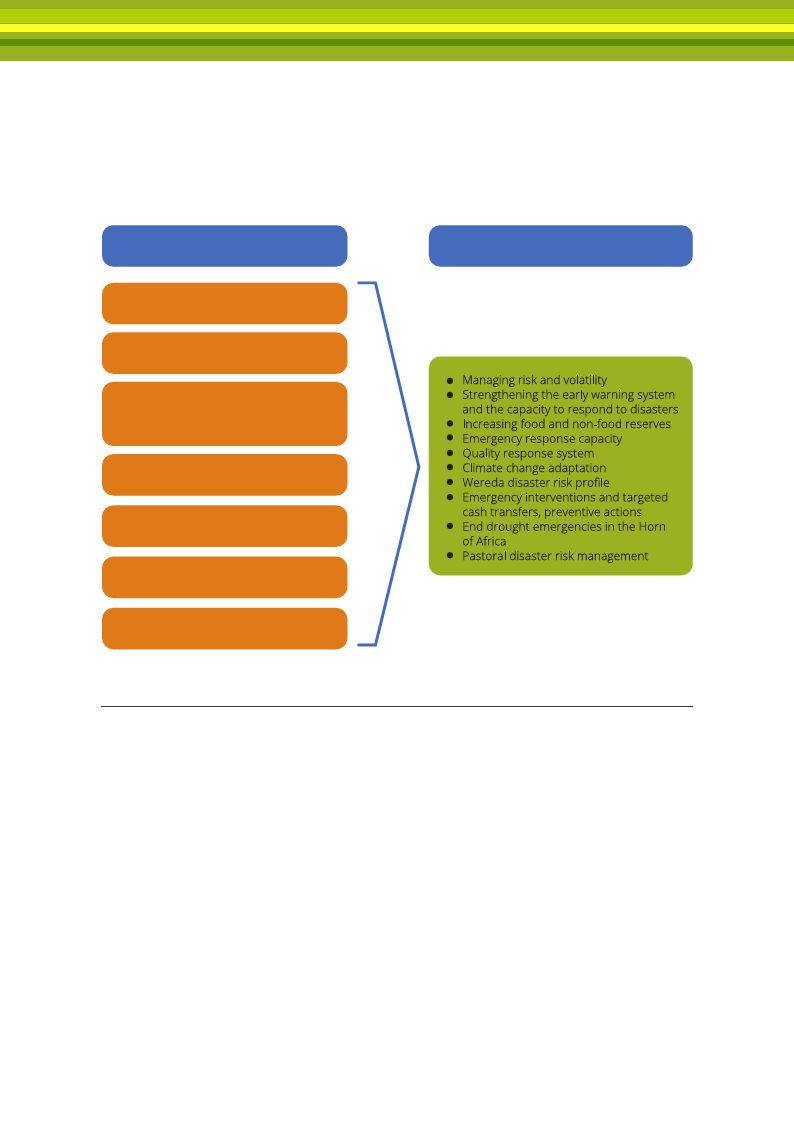
Mainstreaming DRM into Development: Ethiopia’s Current Situation and Needs
A series of government development strategies (e.g., PASDEP 2005-2009, and GTP-
1&2 2010-2015 and 2016-2019) have emphasized the importance of DRM. In addition,
there are other policies and strategies that pointed out the need to concentrate on
reducing, in the long and medium-term, drought vulnerabilities and vulnerabilities due
to other natural calamities in the region (Figure 2.3).
Policy & Strategies with
DRM Linkages
Agriculture Sector Policy and
Investment Framework (PIF) 2010 - 2020
Climate Resilient Green Economy
(CRGE) - 2011
Disaster Risk Management Strategic
Programme And investment Framework
DRM-SPIF - (2014)
DRM Considerations
GTP II (2015/16-2019/20)
National Social Protection Policy - (2012)
National Nutrition Strategy
Others*
* Food Security Strategy (under GTP – I, 2010); IGAD Drought Disaster Resilience and Sustainability Initiative (IDDRSI) Strategy
(2012); National Action Plan for Gender Equality (NAPGE)2006-2010; National Women’s Policy
Figure 2.3 Policies & Strategies in Ethiopia with DRM Linkages
Mainstreaming DRM into Development: Ethiopia’s Current Situation and Needs
A series of government development strategies (e.g., PASDEP 2005-2009, and GTP-
1&2 2010-2015 and 2016-2019) have emphasized the importance of DRM. In addition,
there are other policies and strategies that pointed out the need to concentrate on
reducing, in the long and medium-term, drought vulnerabilities and vulnerabilities due
to other natural calamities in the region (Figure 2.3).
Note: The above policies and DRM consideration are only illustrative and not exhaustive)
Although these policies and strategies emphasized the need for DRM mainstreaming, there
are gaps at the system, institutional, and DRM levels that need to be addressed (Table 1.1).
In order to enhance the effectiveness of DRM mainstreaming, DRM capacity building in the
country should aim to strengthen following external and internal linkages (DRMFSS, 2014):
22

External Linkages:
Policy level: Harmonize potential policy overlaps between climate change adaptation
and mitigation strategies (CRGE), social protection, and DRM, as well as work to jointly
mainstream the policies in one process
Institutional level: Develop clear coordination structures and through them elaborate
the roles and responsibilities of each institution to demonstrate the synergy required to
reach common GTP and CRGE objectives
Operational level: Develop common implementation systems with the aim to integrate
all aspects of the DRM cycle within a common set of instruments
Internal Linkages:
Information systems: Further harmonize the various DRMFSS approaches and
products with mandate areas and target objectives of development sectors so that
risk assessment, monitoring, and early warning is one continuum that informs decision
making throughout the DRM cycle
Contingency planning: Link contingency and DRR planning much more closely with the
regular development planning process and to the response through current and new
instruments
Response: Work to harmonize current emergency appeal system with risk financing
instruments under overall DRM framework
Funding modalities: Funding mechanisms along with contingency planning and
preparedness are all system level requirements and must work together. Funding
mechanisms must deliver resources to the point of need in the time frame available
for response and thus need to be streamlined and fully incorporated into the DRM
cycle rather than as a separate process.
Expected Outcomes of Mainstreaming DRM into Development in Ethiopia
In general, the effective integration of DRM into the development process results in risk-
sensitive development, which has two fundamental outcomes:
• First, DRM integration gradually leads to the protection of all existing and new public
assets against the impacts of hazard events. Over time, awareness of potential
hazard impacts leads to investment in the protection of existing assets. Similarly,
protective features gradually become part of the normal investment in any new
asset. The aim, for example, is that all highways and schools can withstand the
adverse effects of natural hazards to a reasonable degree.
• Second, integrating DRM seeks to avoid the creation of new forms of risk due to an
increase in the exposure or vulnerability of populations and assets. This means, for
example, that socio-economic policies will not increase the exposure of populations
or assets, like an agricultural policy that encourages farming settlements in an
inadequately protected flood plain. It also means that all new physical developments,
like rail lines and housing developments, are undertaken with consideration not only
of the potential hazard impacts on the asset itself, but also of the potential impacts
on the surrounding area. As such, these developments do not exacerbate existing
risks or create new ones for nearby communities or assets.
23
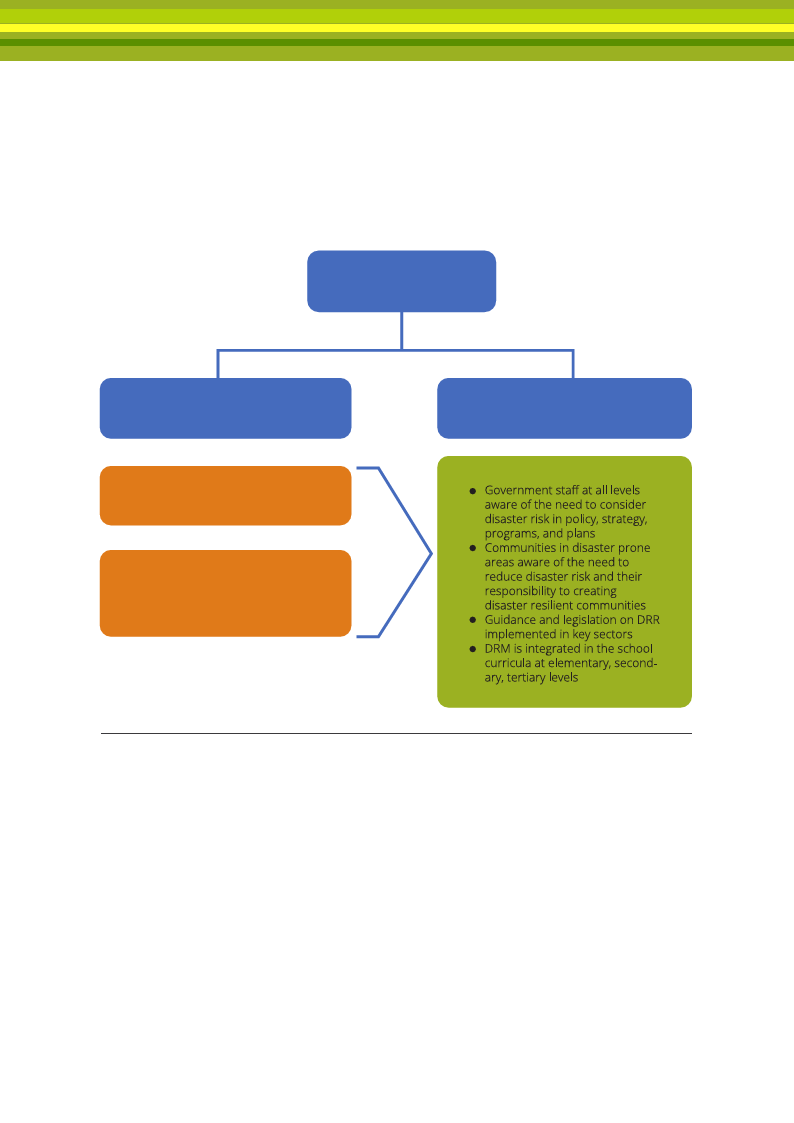
In Ethiopia, the expected outcomes of mainstreaming DRM into development are
clearly shown in Figure 2.4. The objectives and goals will be achieved through the
implementation of key activities highlighted in the DRM-SPIF document. A number
of priority areas for investment have been identified within the DRM cycle, including
information management systems support, DRR programming, climate change
adaptation (CCA)/DRR/social protection integration, DRM coordination, international
collaboration and engagement, capacity development, and DRM mainstreaming, DRM
volunteer scheme, among others).
Mainstreaming
DRM in Ethiopia
Objective & Goals
Goal: To contribute to Ethiopia’s
achievement of middle income
status by 2020.
Objective: Mainstream DRM into all
sectors, and ensure DRM is integrated
into regular development
programmes and implemented at
all levels.
Expected Outcome with
DRM Consideration
Figure 2.4 Expected Outcome of Mainstreaming DRM in Ethiopia (Authors’ compilation from DRM-SPIF)
24
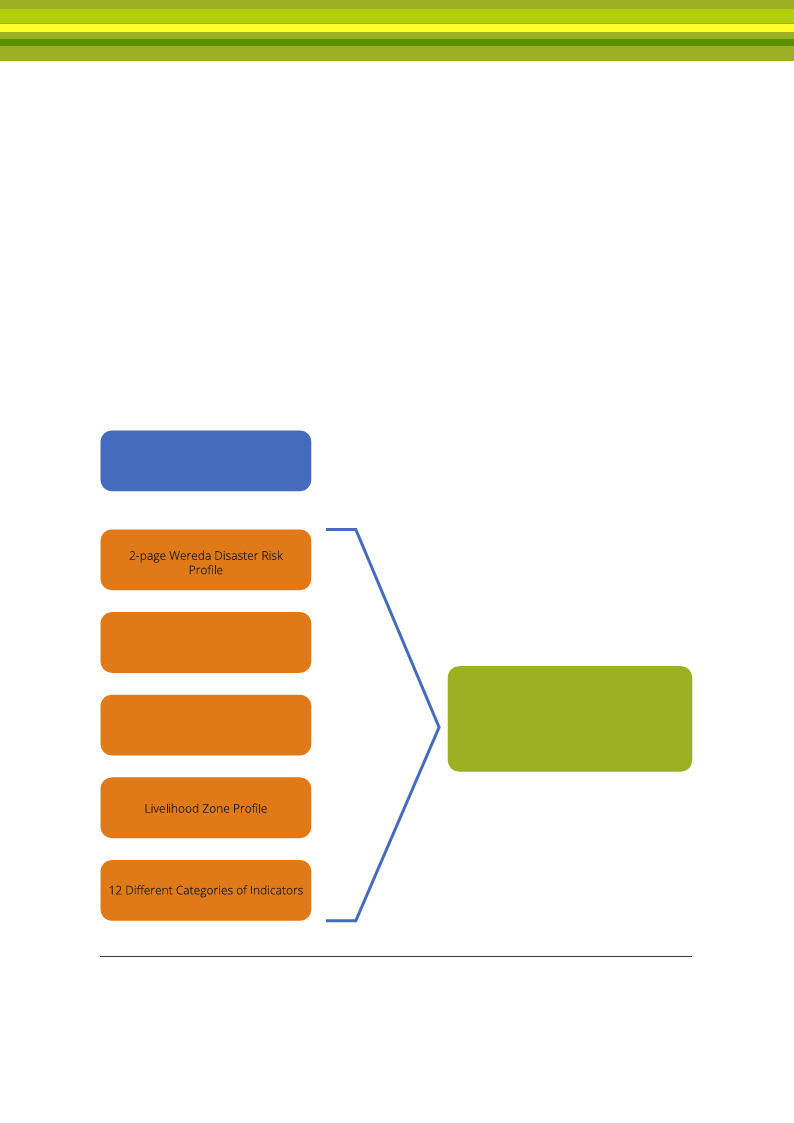
2.2 Existing Tools, Methods, Approaches and Policy Environment
Supporting DRM Mainstreaming in Ethiopia
2.2.1 Wereda (District) Disaster Risk Profile
The Wereda Disaster Risk Profile (WDRP) is a representation of information regarding
a population, place or system’s exposure, sensitivity, and resilience to given hazards
that can be applied to disaster risk management strategies (National Disaster Risk
Management Commission, n.d.). The tool adopted a conceptual framework as outlined
in the HFA, wherein vulnerability, hazards and capacity to cope are three basic
elements of DRM. The profiles are in the process of development stage for selected 35
rural districts (weredas) in the country.
The Wereda Disaster Risk Profiling Information Management System (WDRP-IMS) has
been established, which is a database of district/wereda disaster risk profiles that
consist of the hazard/disaster, vulnerability, and coping capacity characteristics of each
of these weredas. The WDRP database is a key component of the entire program, which
provides essential information for contingency and DRR planning as shown in Figure 2.5.
WDRP DATABASE
Key Components
Booklet of WDRP for the Selected
Wereda
Location Map of the Wereda
WDRP Information Management
System in Ethiopia
Figure 2.5 Key Components of the WDRP Database (Authors’ compilation from the WDRP IMS Flyer National
Disaster Risk Management Commission (NDRMC))
25
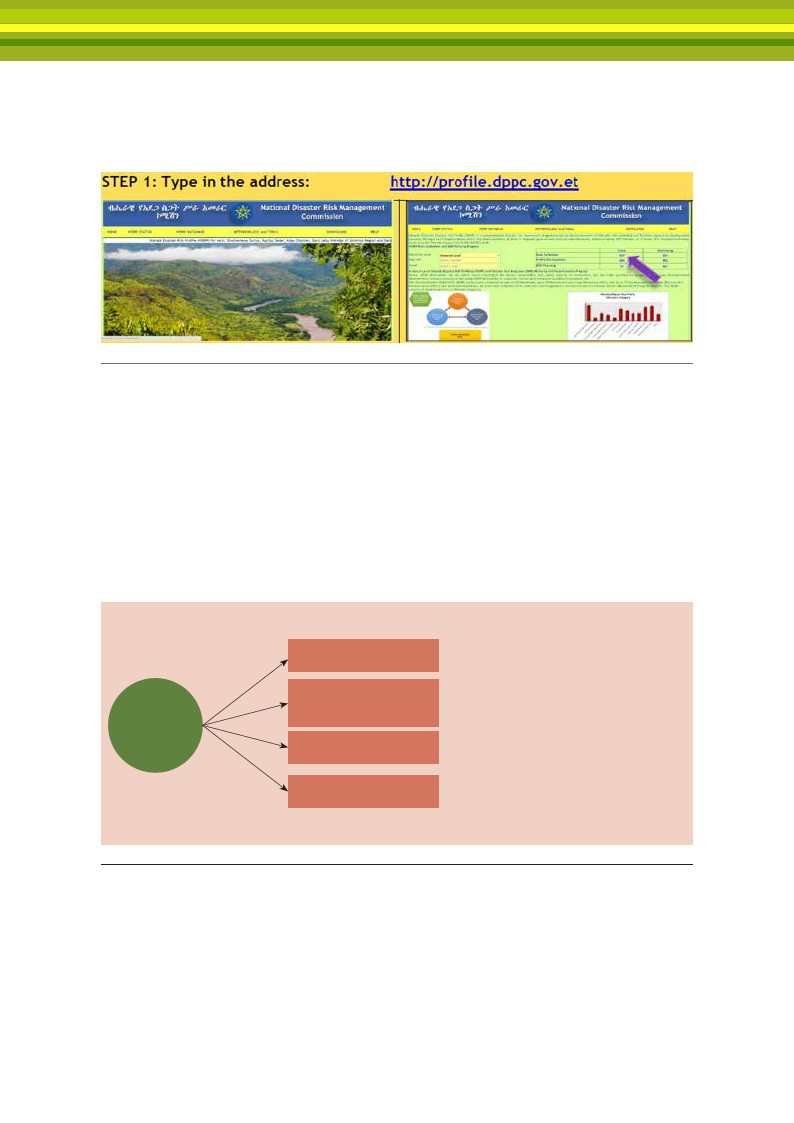
To date, WDRP data collection has been conducted for 400 out of more than 800
weredas that are expected to be covered by the WDRP program. The WDRP IMS website
(http://profile.dppc.gov.et) provides close to 300 WDRP from the nine regional states
and one city administration (Figure 2.6).
Figure 2.6 Webpage of Wereda (District) Disaster Risk Profiling Information Management System (NDRMC, n.d.)
Linking with DRM Mainstreaming Process
The WDRP information database provides detailed information about the hazard profile,
including types, frequencies, intensities, geographical coverage, etc. It can be extremely
useful for individual line agencies and local governments who require site-specific and
sector-specific hazard and vulnerability data to assist in design and implementation of
disaster resilient development projects. The data is essential for assessing the level of
disaster risk (for specific project location) as well as informing decisions on the project
design and implementation strategy. Figure 2.7 demonstrates the successful application of
WDRP for disaster risk reduction planning in wereda by the NDRMC of Ethiopia.
Wereda
disaster risk
profile
Information about
the disaster risk
factors
Early warning systems
Disaster risk mitigation/
adaptation planning
Contingency planning
Development activities
‣‣ Facilitates timely response at a wereda
‣‣ Monitoring hazard situation based on
comparing with baseline (WDRP)
‣‣ Location-specific EWS according to the
main risks of the area
‣‣ Management of factors of disasters
(from WDRP)
‣‣ Informing development plans/
programmes for disaster risk mitigation/
adaptation
‣‣ Improve preparedness for adverse
events
‣‣ To assign roles and responsibilities for
the wereda emergency response
Figure 2.7 Application of Wereda Disaster Risk Profile (NDRMC, n.d.)
The NDRMC of the Government of Ethiopia has developed 107 WDRP contingency plans
in collaboration with the regional and wereda sectoral experts and non-governmental
organizations in the weredas. The plans demonstrate the successful application of WDRP
data and information into wereda DRR plans.
26

2.2.2 National Policy and Strategy on Disaster Risk
Management, 2013
Linking with DRM Mainstreaming Process
The National Policy and Strategy on Disaster Risk Management (NPSDRM) clearly provides
direction and strategies for mainstreaming DRM into sectoral institutions (Box 2.3).
Box 2.3 Mainstreaming Disaster Risk Management into Sectoral Institutions
An effective disaster risk management system can only be achieved if disaster risk
management is mainstreamed into every sectoral development plan. Disaster risk
management is a cross cutting issue and the responsibility of multiple sectoral
institutions and thus concerned bodies must implement it by integrating it into their
regular development activities. Looking into the current context of the country, however,
attention has not been given to mainstreaming. Unless disaster risk management is
considered integral to development plans of sectoral institutions, it will be difficult to
ensure continued achievements in national development. Therefore, disaster
risk management shall be mainstreamed into development plans of government
institutions and private sector organizations. Moving towards achieving DRM
mainstreaming objectives, the process and practical implementation of DRM
mainstreaming needs to be piloted in 107 selected weredas, where contingency and
DRR plans are already in place.
Strategies
1. A mechanism shall be established for ensuring the mainstreaming of disaster risk
management into government development policies, strategies, plans, and
programs.
2. A proper structure shall be put in place in every designated lead sector
government institution to facilitate the implementation of sector specific disaster
risk management activities.
3. Disaster risk management shall be integrated into school curricula of learning
institutions from primary to higher level as well as into plans of research institutions.
4. It shall be ensured that disaster risk management is mainstreamed into operational
plan of the private sector.
Source: (Government of Ethiopia, 2013)
Further, the policy also assigned lead sector agencies responsible for every hazard at
federal, regional, zonal, wereda as well as at Addis Ababa and Dire Dawa City Administration
levels and they will be responsible for undertaking activities ranging from monitoring to
response (Table 2.3). There shall be a dedicated structure in those lead institutions to be
assigned for performing such tasks.
27

Table 2.3 Lead Sector Institutions Responsible for DRM in Ethiopia
Sr.no Lead Institutions
Hazard Type
1
Ministry of Agriculture and Natural Agriculture related hazards and associated
Resources
disasters such as crop pests and diseases as
well as regarding addressing disaster induced
shortages of crop seed supply
2
Ministry of Livestock and Fisheries Agriculture related hazards and associated
disasters such as livestock diseases as well as
regarding addressing disaster induced short-
ages of animal feed
3
Ministry of Environment, Forestry Forest and bush fire, climate change, environ-
and Climate Change
ment pollution related hazards and associated
disasters
4
Ministry of Health
Food shortage induced malnutrition affecting
children and mothers and also other human
epidemics associated with disasters
5
Ministry of Water, Irrigation and
Floods and other water supply, and water dams
Electricity
related hazards and associated disasters
6
Ministry of Federal and Pastoralist Conflict related hazards and associated disas-
Development Affairs
ters
7
Ministry of Transport
Transport service related hazards and associ-
ated disasters
8
Ministry of Mines
Geological hazards and related disasters, such
as seismic and volcanism (earthquakes and
volcanoes), landslides and slope failure
9
Ministry of National Defence
Search and rescue, maintaining order, and
providing support to emergency, recovery, and
rehabilitation interventions
10
Ministry of Urban Development, Urban infrastructure and building and other
Housing and Construction
constructions related hazards and associated
disasters and other urban disasters, including
fire
11
Ministry of Education
Measures before, during, after the disaster
period to prevent any hazards and related
disasters from interrupting the normal teaching
and learning process, mainstreaming DRM into
school curricula and integrating it into studies
and researches
12
Regional entities: Region, zone,
They shall assign lead institutions that will be re-
wereda, Addis Ababa and Dire
sponsible for undertaking activities ranging from
Dawa City Administration
monitoring to response with respect to hazards
and related disasters that are not under the re-
sponsibility of the Federal government as stated
under sub-section 5.3 of the National Policy and
Strategy on Disaster Risk Management, Ethiopia
Source: (Government of Ethiopia, 2013)
28

2.2.3 Disaster Risk Management: Strategic Programme and
Investment Framework (DRM-SPIF)
The DRM SPIF maps the required program components of a comprehensive DRM system
for Ethiopia. It presents clear investment options for partners desirous of supporting DRM
efforts and designs mechanism for efficient and harmonized fund allocation and utilization.
It is a tool that will enable the DRM sector in Ethiopia to fulfil its important role. The goal of
the SPIF is to contribute to Ethiopia’s achievement of middle income status by 2020. One
of specific objectives of the SPIF is “to mainstream DRM into all sectors, and ensure DRM is
integrated into regular development programmes and implemented at all levels” (DRMFSS,
2014).
Linking with DRM Mainstreaming Process
The activities specifically highlighted for mainstreaming DRM are:
• Assess key sectors areas of the country. Sectoral assessments of successful DRM
mainstreaming in public construction, urban land use planning, water management
and irrigation, including an analysis of climate change, where relevant.
• Produce and implement operational guidance on DRM mainstreaming.
Integration of DRM into the development policies legislation or mandatory guidance.
• Networking and influencing development organizations/institutions.
This includes the dissemination of operational guidance document(s) to all relevant
development actors, ensuring that relevant task forces conduct training for members
on the operational guidance documents, and ensuring that risk analysis and
implementation of the operational guidance document is established as criteria for all
newly funded projects.
29

References and Additional Reading:
Benson, C. (2009). Mainstreaming Disaster Risk Reduction into Development: Challenges and Experience in the Phil-
ippines. Geneva: ProVention Consortium. Retried from http://www.proventionconsortium.net/themes/default/
pdfs/mainstreaming_philippines.pdf
Benson, C. and Twigg, J. (2007). Tools for Mainstreaming Disaster Risk Reduction: Guidance Notes for Development
Organisations. Geneva: ProVention Consortium. Retrieved from http://www.preventionweb.net/files/1066_
toolsformainstreamingDRR.pdf
Disaster Risk Management and Food Security Sector (DRMFSS). (2014). Disaster Risk Management Strategic
Programme and Investment Framework. Ministry of Agriculture, Government of Ethiopia. Retrieved from http://
www.dppc.gov.et/downloadable/Documentation/DRM%20SPIF%202014%20-%20Final.pdf
Munich Re. (2017). Topics Geo 2016. Retrieved from https://www.munichre.com/site/touch-publications/get/
documents_E-271800065/mr/assetpool.shared/Documents/5_Touch/_Publications/TOPICS_GEO_2016-en.pdf
Muktar, A. (2016). Ethiopia’s National Planning Commission says economy has grown by eight percent. Retrieved
from http://www.ethiopianmission.ch/2016/12/09/ethiopias-national-planning-commission-says-economy-
has-grown-by-eight-percent/
UNISDR. (2005). Hyogo Framework for Action 2005-2015: Building the Resilience of Nations and Communities to
Disasters. Retrieved from http://www.unisdr.org/files/1037_hyogoframeworkforactionenglish.pdf
UNISDR. (2015). Sendai Framework for Disaster Risk Reduction. Retrieved from http://www.unisdr.org/
files/43291_sendaiframeworkfordrren.pdf
UNISDR. (n.d.). Ethiopia - Multi-hazard Profile. Retrieved from http://www.DesInventar.net/DesInventar/pro-
filetab.jsp?countrycode=eth
Government of Ethiopia. (2013). National Policy and Strategy on Disaster Risk Management. The Federal Demo-
cratic Republic of Ethiopia, Addis Ababa
National Disaster Risk Management Commission(NDRMC). (n.d.). The Wereda (District) Disaster Risk Profiling
Information Management System (WDRP IMS). Retrieved from http://profile.dppc.gov.et
UNISDR. (n.d.). UNISDR Monitoring and Evaluation Framework. Retrieved from www.unisdr.org
World Bank. (2015). Addis Ababa, Ethiopia Enhancing Urban Resilience. City Strength Resilient Cities Programme.
The World Bank Group: Washington, DC
World Bank. (2013). Ethiopia: Using a Social Safety Net to Deliver Disaster Insurance to the Poor. Case Study. The
World Bank Group
30
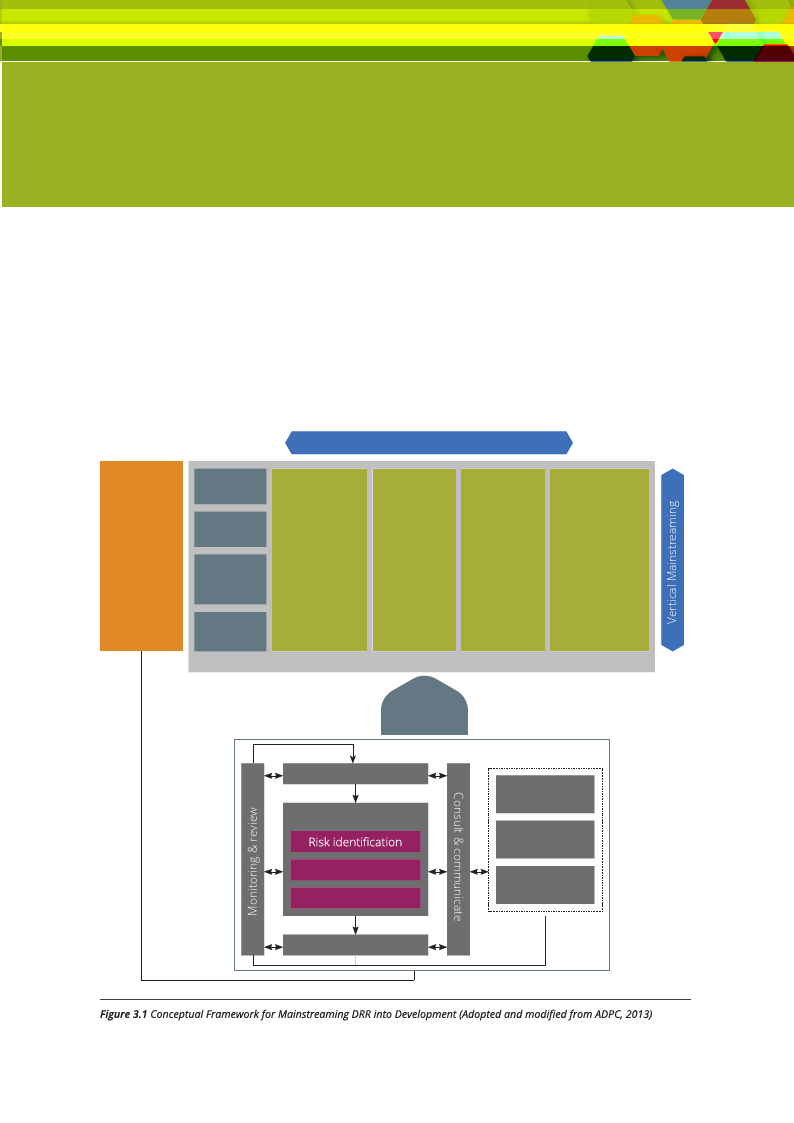
Part 3: Process of Disaster Risk
Management Mainstreaming
3.1 Conceptual Framwork
The development planning process provides the backdrop for mainstreaming DRM.
It covers planning, investment programming, budgeting, staff development,
implementation, monitoring and evaluation stages. Mainstreaming DRM is essential to
integrate disaster (including climate) risk consideration that is to embed DRM process
into each stage of development planning practices where relevant (Figure 3.1).
Horizontal Mainstreaming
National
level
Disaster Risk
Management
(Risk
assessment &
risk treatment)
Regional &
zone level
Rural &
urban
Wereda
Development
policy & strategy,
comprehensive
development
plan
Institutional
structure &
mandates,
systems
Development
programs
& projects,
budgeting
Knowledge
& capacity
building for
implementation
Kebele
Development interventions
Incorporate
DRM into
Establish context
Risk assessment
Risk analysis
Risk evaluation
Risk treatment
Mitigation
Preparedness
Response
31
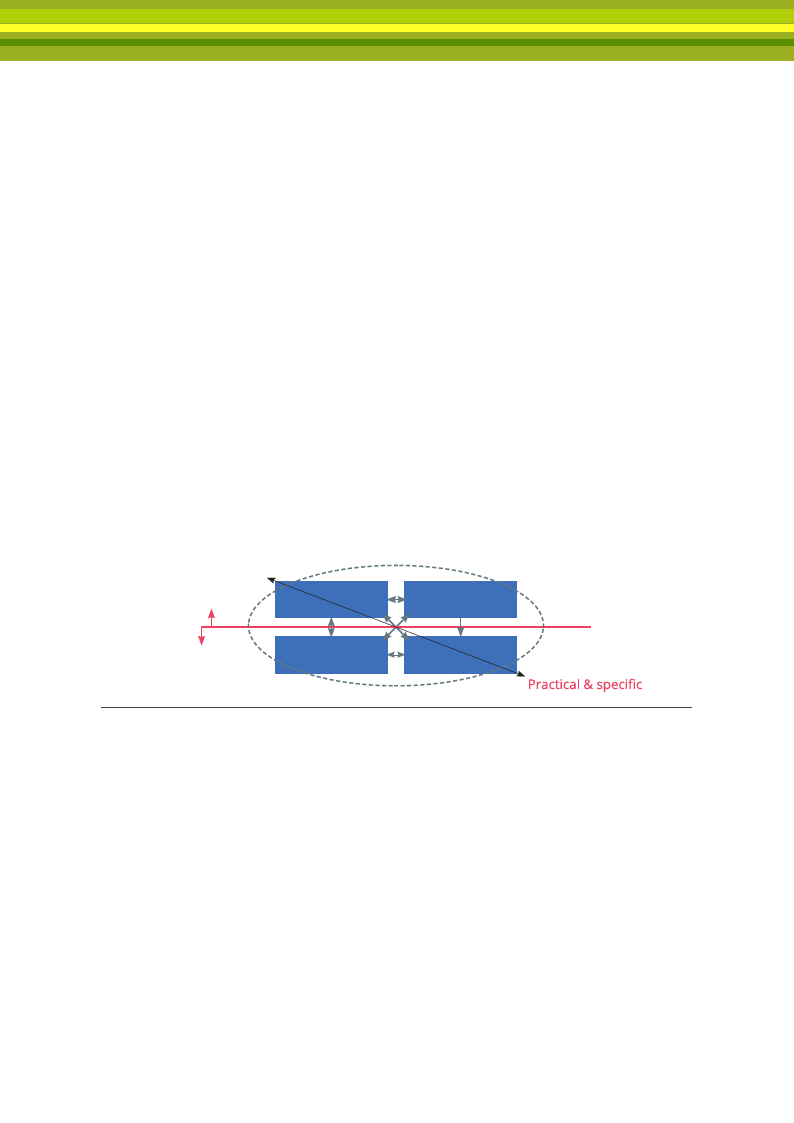
By doing so, DRM will become an essential part of usual practice in formulating
development policies and strategies, including long, medium and annual planning; and
designing, implementing, monitoring, and evaluating programs/projects in the context of
disasters. This will take the following fundamental points of view:
• If development goals and interventions (policies, plans, programs, and projects) are
affected by disaster(s), which effective DRR measures should be implemented to
avoid or minimize the negative impacts?
• If development interventions increase the likelihood of a disaster or increase the
potential for damaging effects of a disaster (exposure and vulnerability to hazard
increased), what are the doable and effective measures to ensure exposure and
vulnerability will be avoided or limited?
• Development project approvals are typically completed on the basis of
recommendations shown in the ESIA document, however, project design and
subsequent implementation in several cases are not in line with anticipated risk
consideration. In the context of Ethiopia, the possible option to incorporate DRR
measures is to engage NDRMC for project approval in regards to risk consideration.
3.1.1 Managing Development: The Process
Development frameworks are complex and multi-faceted, encompassing a wide range
of process and tools that make up development as a whole. Development is not a
linear process. It is achieved through a range of interlocking and overlapping cyclical
process (Figure 3.2). A solid framework for mainstreaming will seek to integrate DRR
into each area of the development framework.
Strategic & broad
Medium to long term
Policy
M&E
Planning
Short to medium term
Budgeting
Implementation
Figure 3.2 Development Framework Process (ADPC, 2013)
The development framework can be split into four areas: policymaking, planning,
budgeting, and implementation. Policymaking and development planning have a
medium to long-term scope, anywhere from 3 to 30 years. Budgeting and project
implementation, on the other hand, have much shorter recurrence periods, often
occurring annually.
Within each of these areas, there are a number of different kinds of tools and
instruments that may be utilized. Each tool typically follows a particular procedure for
its development and implementation.
3.2 Mainstreaming DRM into Policy Making
Establishing a risk sensitive policy environment supports effective integration of DRM
into the broader development process. Government policy is a primary instrument used
by governments to officially address societal problems and steer the development of
32

a country. While government policy is an intrinsically fluid and broad term that refers
to all government decisions about public management, formal public policies are
frequently long-term, overarching frameworks that set the goals, objectives and guiding
principles for public action. Public policy development is the principal method used
by governments to highlight priority issues and direct resources towards them. Key
considerations in public policy and DRM mainstreaming in policy development are as
follows:
•
A government policy, often formalized as legislation, is developed by government
officials and agencies, and typically affects considerable numbers of people
(Anderson, 2003).
•
A single government policy can either address an issue related to a specific sector
(e.g., health care policy), or it can span several sectors (e.g., natural resource
management policy, which affects agriculture, fish, environmental management,
forestry, mining, etc.).
•
Government policies are not restricted to national levels; depending on the size and
level of decentralization in a country, relevant policies may be designed at subnational
levels.
•
Public sector development policies are a prime tool for managing disaster risk. A
policy environment that includes active consideration and response to disaster risk is
fundamental in setting the stage for risk resilient socio-economic development.
•
The integration of DRM into the policy making process facilitates the systemati
consideration and adoption of risk resilient policy options or alternatives. When
effectively implemented, the risk resilient objectives are translated into sector-
specific policy responses, budgets and, ultimately, actions.
Goals of DRM mainstreaming into policy
•
Goals and targets that will not be potentially thwarted by natural hazard events
are adopted in sector policies and responsibilities to ensure implementation are
assigned; and
•
DRM is institutionalized in the policy making process via a prescribed inclusion in
formal government policy making regulatory mechanisms.
Roles of development/DRM practitioners
•
Support the technical aspects of public policy making in the assessment of risk
information and development of risk resilient policy options; and
•
Provide robust up-to-date information of the impacts of disasters on sector
development, the impacts of development policies on disaster risk, and the benefits
of incorporating risk reduction into policies in order to inform policy formulation.
Mainstreaming the DRM process into policy making is presented briefly in Figure 3.3 and
general guidance on detailed tasks/activities/roles for DRM mainstreaming into the policy
process has been explained briefly in Table 3.1.
Getting started in mainstreaming DRM into policy making:
• Analyze which sectors are most vulnerable to disaster impacts. The analysis could be
in terms of direct financial losses and services interruption caused. Analysis may
identify those sector activities that contribute to disaster risk;
• Determine which sectors and policy issues to focus efforts and prioritize for DRM
integration;
• Pre-identify important areas and then keep abreast of the latest news on planned
reviews and determine on a case-by-case basis when to get involved;
• A comprehensive risk assessment can be undertaken to identify priority sectors in
which to engage with;
• A national dialogue can be undertaken, engaging key stakeholders such as sector
agencies, civil society, private sector and, where possible, local populations, to ensure
that their viewpoints and concerns are incorporated. To guide this dialogue, the
33
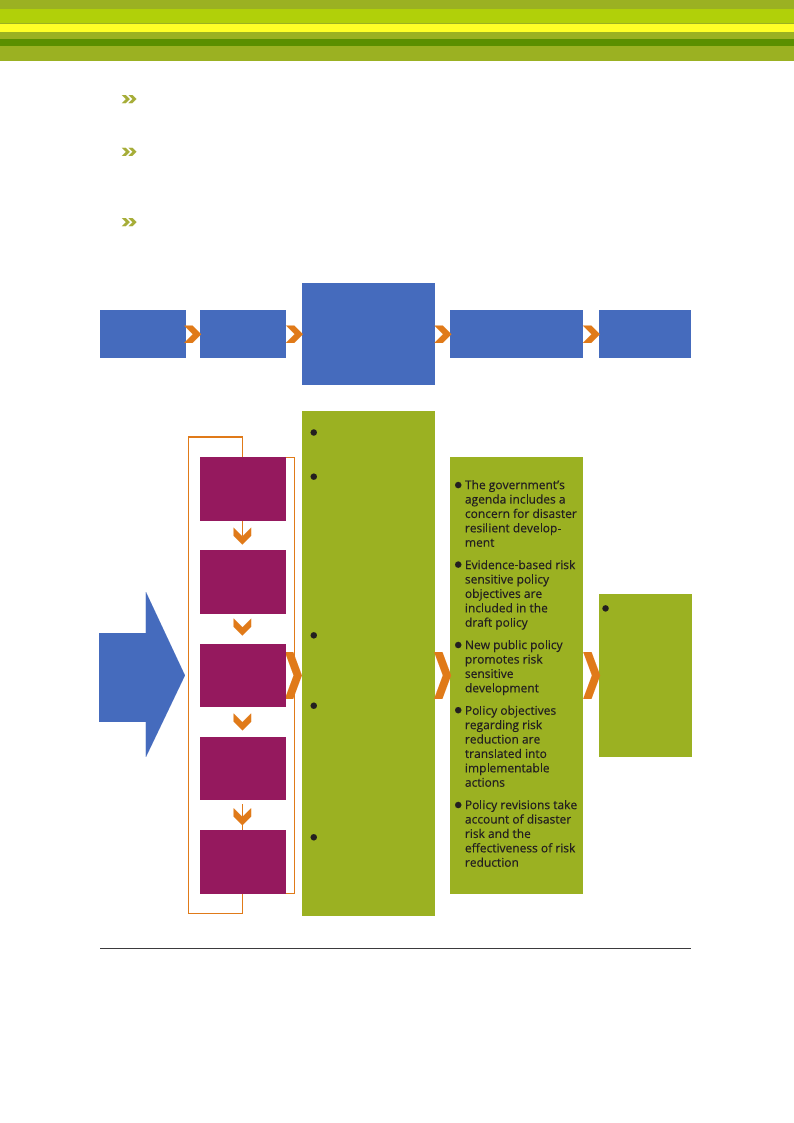
following questions could be asked:
How have disasters impacted key development goals of the country? How have
current development patterns impacted disaster risks? What may happen in the
future?
Which sectors, population groups, and regions are most vulnerable to the
potential consequences of climate and disaster risks? What are the underlying
causes for their vulnerability (e.g., poverty, degraded natural resources, poor
standards of physical development)?
What has been done, if anything, to reduce disaster risks? Has it been effective?
If not, why?
Getting
Started
Process
Potential Activity
/Action/Role
for DRM
Mainstreaming
into Policy
Outcome
Going
Further
Determine
priority
sectors
for DRM
integration
Agenda
Setting
Policy
Formulation
Policy
Adoption
Policy
Implemen-
tation
Evaluation
and
Feedback
Raise awareness
of disaster risk
Obtain and assess
hazard,
vulnerability and
exposure data
relevant to the
sector and policy
issue Provide
examples of risk
sensitive policy
options
Advocate for the
adoption of risk
sensitive policy
alternatives
Support the
determination of
disaster resilient
measures and
targets within
policy
implementation
guidelines
Assist in the
assessment of a
policy’s DRM
successes and
shortcomings
Include DRM
related
directives in
regulatory
templates,
guidelines
and
screening
tools for
policymaking
Figure 3.3 Mainstreaming the DRM Process into Policy Making
34

• In generating information for the policy making process, the following questions may
be asked:
Who has the overall mandate to coordinate policy design (e.g., national planning
agency, national budget and finance agency), and are they normally involved in
sector level planning processes and multi-sector policy making?
What are the overarching policy priorities that the government is committed to
(e.g., poverty reduction, economic growth, etc.)? How can an argument be made
that this requires integrating DRM into sectors?
What are the individual mandates, structures, and decision-making processes in
key sectors? (i.e., individual sectors may be structured quite differently and have
different levels of decentralization)
What policies exist in key sectors? Are there relevant policy initiatives underway?
• Support DRM information and knowledge requirements, such as the international
DRM and CCA agreements, UNFCCC conventions HFA 2005-2015, Sendai 2015-2030,
national DRM and CCA legislation and policy, etc.
Table 3.1 Process of Mainstreaming DRM into Policy Making: General
Guidance
Process Potential Activities/Action/Role for DRM
Mainstreaming
Outcome
Agenda
Setting
The policy making process begins with the identifica-
tion of public problems. Societal conditions convert into
problems when the public deems the condition to be
unacceptable and believes that the government can rem-
edy the situation. The government decides which issues
to formally address, prioritizing from among the many
demands for public attention.
The government’s
agenda includes a
concern for disaster
resilient development
Potential activities for agenda setting include:
• Collating disaster risk information and making it read-
ily available for dissemination
• Public awareness raising, for example through the
celebration of a national disaster day
• Focus on how development can intensify exposure
and vulnerability and how disasters have the poten-
tial to offset development gains, emphasizing factors
such as climate change and rapid urbanization that
may influence changes in disaster risk in the future
Policy
Formula-
tion
Policy formulation is the process of deciding on the aims
and objectives for addressing the broad goals that gov-
ernment has placed on the policy agenda. In this stage,
the government creates, identifies or borrows proposed
courses of action, often called alternatives or options, for
resolving or ameliorating public problems.
Evidence-based risk
sensitive policy objec-
tives are included in
the draft policy
Potential activities for policy formation include:
• Forming a committee of legislators and other public
officials to guide the policy formulation process
• Create a committee that is responsible for hearing
relevant testimonies and making decisions based on
the evidence
35

Process
Policy
Imple-
menta-
tion
Evalua-
tion and
Feed-
back
Potential Activities/Action/Role for DRM
Mainstreaming
• Call upon a DRM practitioner to testify about disaster
risk facing the particular policy issue, including impact
of disasters and the importance of DRM
• Performing a sector risk assessment of the current
and estimated future impacts of natural hazards on
the particular sector, or any post disaster assess-
ments of hazard impacts on the sector should be
presented to showcase how disasters are affecting
development in particular policy areas
• Evidence-based measures for risk reduction: An
information base will allow the DRM practitioner to
suggest possible evidence-based measures for risk
reduction. Use, if available, economic cost-benefit
analysis of investments in disaster risk reduction
• The potential for climate change to affect the sector’s
risk profile should be presented, including sophisti-
cated and complex modelling and analysis
• Local pilot demonstration projects that test the ef-
fectiveness of DRM measures in specific sectors can
foster interest and commitment at both the subna-
tional and national levels
• Research the kinds of risk sensitive policy options
used in similar policies in other sectors or geographi-
cal locations, in order to provide the committee with
examples of policy options that serve to reduce
disaster risk
• Review the policy options under considerations and
offer views and comments from a disaster risk per-
spective, including potential entry points for strength-
ening resilience
This stage of the process encompasses the actions that
government takes to put a law into effect to achieve its
goals.
Potential activities for policy implementation include:
• Consideration for DRM is included in guidelines and
procedures for policy implementation
• Review guidelines before they are adopted to ensure
proper DRM integration
Activities for appraising the achievements, outcomes and
consequences of a policy are part of policy evaluation.
Some policies have a review schedule that includes mid-
term reviews, used by implementing agencies to identify
and adjust problems in implementation. Often, policy
evaluation takes place when the policy issue resurfaces
for revision on the public agenda.
Outcome
Policy objectives
regarding risk reduc-
tion are translated into
implementable actions
Policy revisions take
account of disaster risk
and the effectiveness
of risk reduction
Potential activities for evaluation and feedback include:
• Preparing study reports of disaster events that oc-
curred during policy implementation to help deter-
mine whether the policy’s programs were successful
in reducing disaster impacts
• Communicating the findings to the body responsible
for policy evaluation to help government make the
necessary changes in the policy provisions or pro-
gram implementation, or both
36

Going further in mainstreaming DRM into policy making
• Adopt various tools in an attempt to facilitate a standardized and transparent policy
making process;
• Develop policy formulation guidelines and templates: National agency foreplaning
(in Ethiopia’s context, National Planning Commission) may include a requirement to
reflect on the disaster risk affecting the policy issue and to consider DRM options
when drafting the policy proposal; and
• Adapt policy screening tools such as the Strategic Environmental and Social
Assessment (SESA) to consider how policy objectives can be affected by disasters and
how policies can influence exposure and vulnerability to disasters.
3.3 Mainstreaming DRM into Development Planning
Development plans that fully consider and address disaster risk are a crucial element
of sustainable development. While government policies strategically guide public
management on specific issues, development plans broadly determine what needs
to be achieved in a country over a certain time period. These plans provide an
overarching strategic framework, where long-term goals for the country are
established, and the objectives, strategies, and targets to move the country towards
those goals are detailed.
Development planning is a continuous and cyclical process of analyzing the context
and setting objectives, formulating, adopting, and implementing the plan, as well as
evaluating the implementation. After evaluation, it is back to analyzing the present
context, identifying new objectives, and so on. Depending on the level of inclusion in
the process, identifying objectives and setting the strategies can involve consultations
with a whole range of actors from government line agencies to decentralized
government bodies, from civil society and the private sector to international partners.
Goals of DRM mainstreaming into the development planning process
• Increase awareness of the disaster risk affecting the country and particular priority
sectors is recognized as a development challenge, potentially threatening the
sustained achievement of plan goals and objectives; and
• Create development plans to lay out clear overarching goals, objectives, and
strategies for enhancing resilience, and integrate them as relevant into sector
specific strategies, initiatives, and programs.
Roles of development/DRM practitioners
• Support the national planning agency to take account of disaster risk through the
provision of information to identify disaster risk and understand how reducing risk
enhances development; and
• Work with line ministries and subnational governments to incorporate disaster
resilience as an integral part of sector development strategies and initiatives.
Mainstreaming the DRM process into development planning process is presented
briefly in Figure 3.4 and general guidance on detailed tasks, activities, and roles for DRM
mainstreaming into the development planning process has been explained in Table 3.2.
Getting started in mainstreaming DRM into the development planning process
• Which body has the overall mandate to coordinate development planning?
• What are the basic stages in the planning process and what is the timeline? Who is
consulted (e.g., sector agencies, communities, CSOs, development partners, private
sector, etc.) and when?
• Are there working groups or committees? What is their composition and function?
Determine which sectors should be prioritized for DRM integration. Given limits in time and
resources, prioritizing sectors will help focus advocacy efforts later on.
37
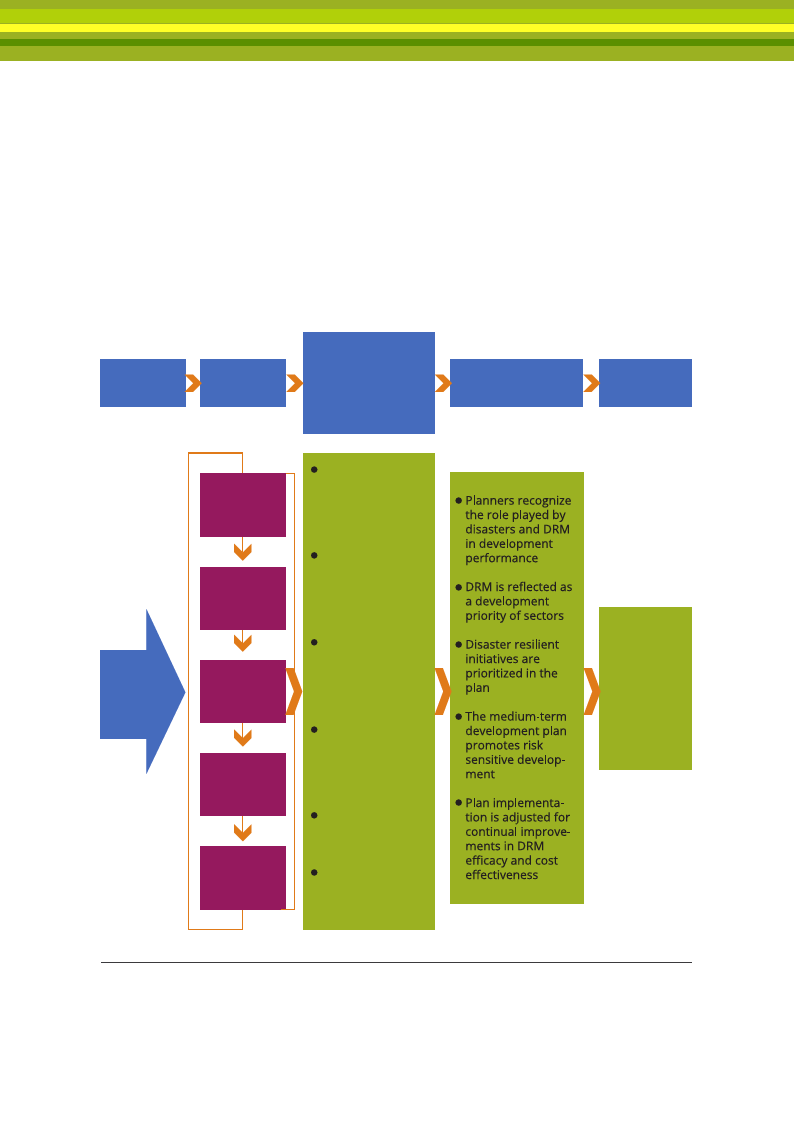
Before planning:
• Conduct a risk assessment and cross-sector dialogue to analyze the sectors that are
most vulnerable to disaster impacts and determining priorities;
• Analyze the direct financial losses and service interruption caused by disasters as
well as the extent to which funds were channeled away from development activities
to disaster response and recovery;
• Identify those sector activities that most contribute to an increase in exposure and
vulnerability of populations and assets to natural hazards;
• Encourage the national planning agency to include DRM expertise in all relevant
technical committees; and
• Support DRM information and knowledge requirements, such as relevant
commitments to reduce disaster risk, quantitative and qualitative risk assessments, etc.
Getting
Started
Process
Potential Activity
/Action/Role
for DRM
Mainstreaming
into Planing
Assessment
of Development
Achievements
and Challenges
Goal and
Objective
Setting
Determine
priority sectors
& promote
DRM expertise
in technical
working group
or committee
Plan
Formulation
Plan
Adoption
Implementation,
Evaluation
and Feedback
Encourage
analysis of
disaster impacts
on development
performance
Support the
incorporation of
DRM into the
objectives of
priority sectors
Push for the plan’s
formulation
guidelines to
mandate disaster
risk consideration
Identify indicators
to monitor
disaster impacts
and DRM on plan
performance
Advocate for the
adoption of a risk
sensitive plan
Highlight disaster
impacts on plan
performance
Outcome
Going
Further
Continually
raise aware-
ness of
planners,
Initiate
large-scale
data
collection
mechanisms
Figure 3.4 Mainstreaming the DRM Process into Development Planning Process
38

Table 3.2 Process of Mainstreaming DRM into the Development Planning
Process: General Guidance
Process
Potential Activities/Action/Role for DRM
Mainstreaming
Outcome
Assessment
of Devel-
opment
Achieve-
ments and
Challenges
• Assessment and analysis of past achievements and Planners recognize
challenges, as well as the impacts of disasters
the role played by
• Determine how disasters resulted in shortfalls in
disasters and DRM
targets, directly and indirectly
in development
• Emphasize both the intense impacts of any large
performance
disaster that hit in the duration of the past plan, and
the cumulative impacts of small disasters
• Make the connection between DRM and develop-
ment targets, such as poverty reduction
• Undertake disaster risk analysis as part of sector as-
sessments
• Provide relevant background material for undertaking
the assessment (Table 3.3)
• Initiate short-term studies, background papers or
focus group discussions among experts on national
trends that may have affected previous development,
such as changes in migration patterns
• Include studies on urbanization, climate change, and
disaster trends and their impacts
Goal and
Objective
Setting
Once an analysis of the current situation is complete,
goals for the country’s development and sector objectives
for the coming plan period are set. This is usually done by
the national planning agency, in consultation with other
government agencies.
DRM is reflected
as a development
priority of sectors
Potential activities for goal and objective setting include:
• Reference of international agreements, national
frameworks, and post-disaster and risk assessments
to guide the responsible agencies in establishing
specific DRM goals
• Integrate disaster risk as a cross-cutting issue
• Establish specific goals and objectives for DRM
• Ensure that the goals relate to the key disaster risk
issues identified in the assessment of development
challenges, and to objectives in any national legisla-
tion, policies, or action plans for DRM or climate
change adaptation. For example, frequent flooding
may be identified as a development challenge. Pro-
tecting communities in flood prone areas could be a
goal from which strategies and targets are created
• Incorporate DRM into sector goals and objectives.
For example, poverty reduction goals commonly ap-
pear in development plans and their achievement is
strongly linked to disaster risk. Post-disaster assess-
ments, poverty analyses and risk assessments stress
planners to know how:
- Disasters impact human development and
reinforce the poverty cycle;
- Risk reduction efforts can help populations escape
the poverty trap; and
- Efforts to reduce income poverty and improve basic
social conditions can improve disaster resilience.
39

Process
Plan Formu-
lation
Potential Activities/Action/Role for DRM
Mainstreaming
Outcome
Formulation of the plan involves identifying the strategies,
initiatives, and responsible parties to achieve the objec-
tives and goals. In this stage, targets and indicators to
monitor the plan’s effective implementation are identi-
fied. Formulation is often a consultative process, where
development of the plan at subnational and local levels
feed into national sector level initiatives and vice versa. At
the end of the process a final draft of the national socio-
economic plan is complete.
Disaster resilient
initiatives are pri-
oritized in the plan
Potential activities prior to plan formulation include:
• Push for the inclusion of DRM-related principles and
priorities in the guidelines so that there is a mandate
to consider and address disaster risk throughout
priority development sectors
• Encourage the use of a risk assessment as part of the
planning process
• Require that development strategies be based on the
results of the risk assessment
• Require the inclusion of specific DRM targets and
indicators for monitoring purposes
• For subnational plans, encourage inter-district or
inter-state considerations for effective DRM
• Develop monitoring and evaluation indicators, drawn
from DRM frameworks and utilized internationally
such as those found in UNISDR’s HFA (use the latest
SENDI) monitor, or the Making Cities Resilient: Local
Government Self-Assessment Tool
Potential activities after plan formulation include (ap-
proval criteria):
• Establish DRM as a required criterion for approval.
The following questions can be incorporated:
- Does the plan adequately consider sector, district,
provincial, or state hazards?
- Does the plan include necessary structural,
non-structural, and environmental measures to
reduce the risk of disaster?
- Does the plan encourage disaster resilient sector
growth in safe locations using resilient practices?
• Advocate and raise awareness of the link between
disasters and development at national and local
levels
• Focus attention on protecting local infrastructure and
development clusters when approving local develop-
ment plans
40

Process
Plan Adop-
tion
Implemen-
tation,
Evaluation,
and Feed-
back
Potential Activities/Action/Role for DRM
Mainstreaming
Once the draft is finalized, the plan undergoes a final
review or national approval process by government and
civil society representatives. For implementation to begin,
the government must endorse the plan.
Potential activities for plan adoption include:
• Raise awareness on the role of disaster risk in devel-
opment and advocate for the adoption of risk sensi-
tive goals and targets (results of the initial analysis
regarding the effects of disasters on the previous
plan can be used)
• Incorporate findings from the risk assessments and
cost-benefit analyses to bolster the argument
Development plans are implemented by the sector agen-
cies through projects that are programed into annual
or multi annual budgets. The plan will usually have a
review schedule, which calls for one or multiple mid-term
reviews to assess implementation and effectiveness, and
identify the challenges impeding achievement of goals
and objectives. The results of this review feedback to
influence implementation.
Outcome
The medium-term
development plan
promotes risk
sensitive develop-
ment
Plan implementa-
tion is adjusted for
continual improve-
ments in DRM
efficacy and cost
effectiveness
Potential activities for implementation, evaluation, and
feedback include:
• Review the plan to highlight any disaster impacts on
performance and to emphasize the importance of
DRM
• Highlight both direct and indirect impacts of disas-
ters, such as, reallocation of funds for relief and re-
construction making it financially difficult to build the
number of schools required to meet the goal
41

Information
National socio-economic performance in
relation to disasters, (i.e., reductions in GDP,
missed employment targets). Focus on
underlying drivers.
Sector performance, for example:
• Damage to housing
• Agricultural productivity in flood and
drought affected areas
• Reduced tourism revenues after flight
cancellations
• Production losses in manufacturing sector
due to power outages
• Livelihood setbacks due to damaged facili-
ties and equipment of small, medium and
micro enterprises
Public infrastructure damage and the
implication on public spending, for example:
• Roads, bridges, water supply, drainage
facilities, public schools, and hospitals
Protential Source
MDG reports, HFA, SENDAI, other regional
reports (i.e., The Pacific Plan)
Post-disaster needs assessment
Reviews of economic performance
Disaster-related and early warning reports
from national and local disaster coordinating
councils, NGOs, development and humanitar-
ian aid agency
Business community releases
Reports from appropriate government
agencies such as public works and highways
Source: (ADPC, 2013)
Going further in mainstreaming DRM into the development planning process
Facilitate DRM institutionalization through:
• Continuous awareness raising initiatives – National planning agency or national
DRM agency (in Ethiopia’s context, NPC for planning and NDRMC for DRM) can
allocate regular resources for DRM trainings, orientations, and capacity development
initiatives across all levels of government and sectors.
• Large scale data collection mechanisms – In order to monitor hazard frequency
and intensity, exposure levels, and vulnerabilities on an ongoing basis, an integrat-
ed national disaster information management system should be established, where
assigned institutions (national, sector, local) regularly collect, update, monitor, and
maintain nationwide hazard and vulnerability data.
• Assist or encourage the national data collection agency – Support the National
Bureau of Statistics (in Ethiopia’s context, Central Statistical Agency) to explore the
feasibility of collecting time series household data that incorporates information on
hazard impacts.
3.4 Mainstreaming DRM into Bugetary Process and Resouce
Allocations
Effective integration of DRM into the broader development process does not end with
the establishment of disaster resilient development visions, goals, targets, and
strategies. The execution of public policies and plans requires funding. Governments
typically prepare budgets each year, allocating resources for the forthcoming fiscal
year. These budgets are based on forecasts of both governmental expenditures and
revenues. National government revenues primarily take the form of income, corporation
and sales taxes. Expenditure covers both recurrent expenditure (such as public sector
wages, operational and maintenance costs, and social transfers), and individual capital
investment initiatives.
42

Effective DRM requires three basic forms of disaster risk financing:
• Financing for dedicated disaster risk reduction and preparedness initiatives (e.g., flood
mitigation, hazard monitoring, early warning systems);
• Financing to ensure that other new development investments (e.g., schools, health
clinics, roads, bridges) are disaster resilient; and
• Financing for disaster response, recovery, and reconstruction/rehabilitation.
In addition, adequate maintenance budgets can play a key role in minimizing loss of life
and property in the event of a natural hazard.
Goals of DRM mainstreaming into budgetary and resource allocation processes:
• Public expenditures on disaster risk reduction, both in total and as a proportion of
expenditureon any individual development investment, are sufficient relative to the
level and nature of disaster risk, the expected social and economic returns, and the
reasonable responsibilities and obligations of government in reducing risk;
• Ensure satisfactory financing arrangements are in place to manage the remaining
risk that could not be reduced. In other words, provide resources for response, early
recovery, and reconstruction/rehabilitation without disrupting existing public
investment plans; and
• Use fiscal instruments to encourage private sector and household investment in
disaster risk reduction and transfer, reducing the government’s contingent liability
(Benson, 2009; Benson and Mahul, forthcoming).
Roles of development/DRM practitioners:
• Support technical aspects of public budgeting for DRM; and
• Ensure that political deliberations are based on knowledge of the potential fiscal,
macroec nomic, and social consequences of disasters, and the net returns to
investments in DRM.
DRM mainstreaming into budgetary and resource allocation process is presented
briefly in Figure 3.5 and general guidance on detailed tasks, activities, and roles for DRM
mainstreaming into budgetary and resource allocation processes has been explained
briefly in Table 3.4.
Getting started in mainstreaming DRM into budgetary processes:
• Understand basic stages in the preparation of the budget, covering the determination
of resource availability and allocation, as well as the time schedule for annual budget
preparation to ensure timeliness of inputs;
• Understand working groups and committees, including their composition and function;
• Understand the processes underlying multi-year budgeting and investment progra
ming, where applied;
• Identify potential allies and plan collaborative efforts at this preliminary stage;
• Advocate for the inclusion of experts on the economics of disasters in budget
committee or technical working group to ensure that disaster risk is adequately
reflected in revenue projections and resource allocations;
• Support DRM information and knowledge requirements, such as contingent liability in
the event of a disaster and specific DRM investment requirements, and quantitative
assessment of disaster related contingent liability;
• Maintain comprehensive databases on historical losses, covering high frequency, low
impact localized events as well as major ones and by collating existing hazard and
disaster risk assessments;
• Review contingent liability estimates on a regular basis;
43
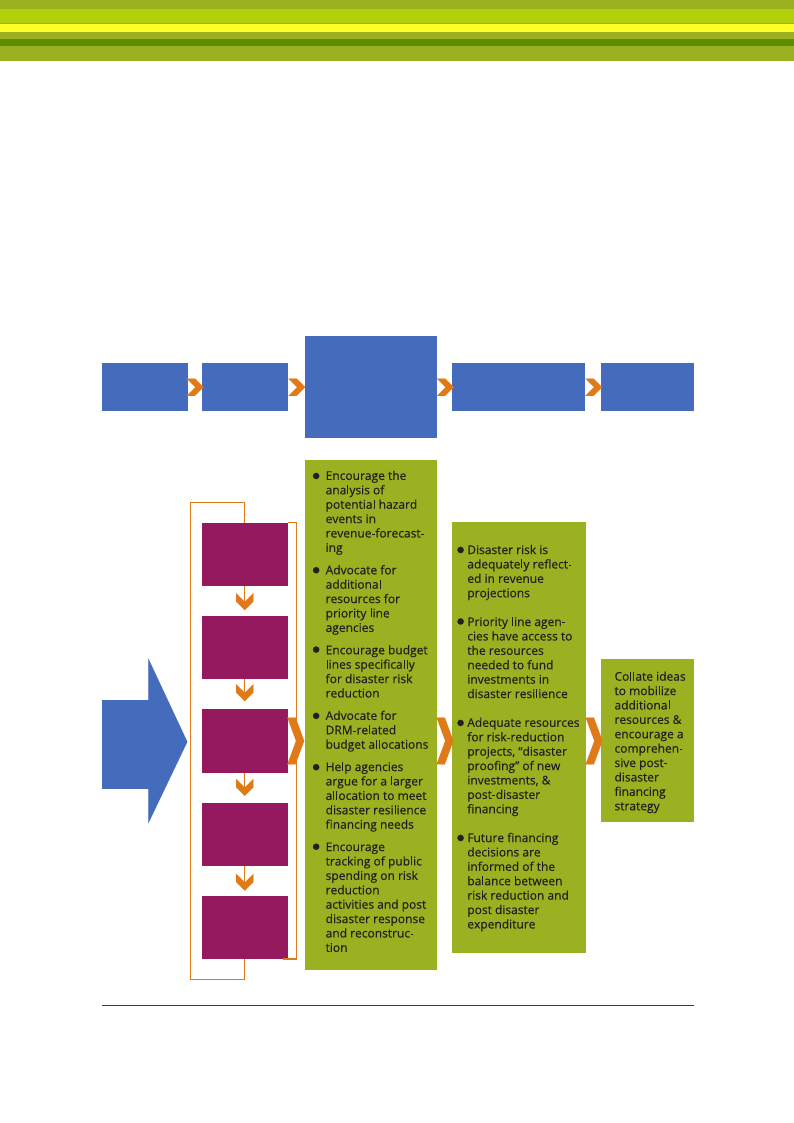
• Collect site-specific hazard and vulnerability data. Individual line agencies and local
governments require site-specific hazard data to assess the levels of disaster risk
associated with their existing investments and to ensure that new investments are
disaster resilient;
• Determine the level of resilience of existing investments to help determine any
retrofitting needs and maintenance budget requirements, since a considerable element
of disaster risk may be created through poor upkeep;
• Support individual line agencies and local governments in accessing available hazard and
disaster risk data for proposed and existing investment localities;
• Proactively alert relevant line agencies and local governments to areas of high risk and
to particularly vulnerable infrastructure, as well as support the creation of risk-sensitive
land use plans; and
• In Ethiopia’s context, obtain site/local specific hazard data set from wereda profile.
Getting
Started
Process
Potential Activity
/Action/Role
for DRM
Mainstreaming
into Budgetary
Process
Outcome
Going
Further
Resource
Availability
Assessment
Initial
Resource
Allocations
Advocate for
the inclusion
of DRM
expertise in
technical
working
groups
Budget
Requests
Budget
Finalization
and Approval
Budget
Implemen-
tation
Figure 3.5 Mainstreaming the DRM Process into Budgetary Processes
44

Table 3.4 Process of Mainstreaming the DRM into Budgetary Processes:
General Guidance
Process
Protential Activities/Action/Role for DRM
Mainstreaming
Outcome
Resource
Availability
Assessment
The budgetary process begins with an assessment of
resource availability, focusing on the year ahead. Under
a medium-term budgetary framework the assess-
ment may require a longer period of time. The avail-
able resources may be determined using a complex
econometric forecasting model, a qualitative analysis
of macro-fiscal trends, or some combination of qualita-
tive and quantitative techniques. It takes into account
the potential collection of tax and non-tax revenue,
borrowing capacity and availability of loans, and the aid
committed to support budget programs and projects
(World Bank, 2013).
Potential activities in resources availability assessment
include:
• Encourage the budget or finance agency, the na-
tional planning agency, the Central Bank, and other
key agencies engaged in revenue forecasting to
take potential hazard events into account in their
analysis, if they do not already do so
• Undertake risk-sensitive revenue projections by
examining the implications of a range of moderate
and extreme disaster scenarios for the availability
of public resources
• Provide advice on reasonable disaster scenarios,
including key types of direct losses. Impacts should
include consequences for sector output, imports
and exports, and other macroeconomic aggre-
gates; and implications for public revenue
Disaster risk is ad-
equately reflected in
revenue projections
Initial
Resource
Allocations
Governments often make initial resource allocations
for individual spending agencies over the forthcom-
ing budgetary period based on past spending, new
priorities and policies, and relevant guidance provided
by the cabinet, council of ministers, or a similar body
(World Bank, 2013).
Potential activities in initial resource allocations include:
• Advocate for additional resources for those line
agencies that have adopted new DRM priorities
and policies, or for those who have performed
poorly with regard to DRM in the past due to fund-
ing constraints
• Conduct cost-benefit analyses on the potential net
return to investments in resilience
• Highlight the realized benefits of past DRM spend-
ing by establishing and maintaining a collection
of success stories, covering both local and larger-
scale actions to strengthen resilience of both public
and private initiatives
• Develop evidence on the costs incurred by ignoring
disaster risk, as manifested in subsequent loss of
public infrastructure and related loss of human life
45

Process
Budget
Requests
Protential Activities/Action/Role for DRM
Mainstreaming
Based on preliminary instructions from the Ministry of
Finance, including specified information on initial re-
source allocations, spending agencies prepare detailed
annual or multiyear budget requests. These requests
reflect sector strategies and the estimated costs of
continuing and new activities. They include specific
items of planned recurrent and capital expenditure
over the budget period.
Outcome
Adequate resources
for: risk-reduction
projects, “disaster
proofing” of new
investments,
post-disaster
financing
Potential activities for budget requests include:
Budget
Finalization
and
Approval
• Make the case for investment in resilience on the
findings of benefit-cost analyses, on evidence on
the realized benefits of past DRM spending, and on
evidence of the costs incurred by ignoring disaster
risk
• DRM-related budget allocations must include:
• Ongoing and newly approved dedicated disaster
risk reduction initiatives;
• Incremental costs incurred in making other on-
going and new development investments resilient;
and
• Potential post-disaster relief, early recovery, and
reconstruction spending requirements.
• Provide helpful technical advice on the additional
costs of strengthening development investments
against natural hazards.
Budget requests of each spending agency are re-
viewed, taking into account sector strategies and the
availability of resources. Following further dialogue
with spending agencies, additional cabinet guidance
and consideration of the required trade-offs, proposed
budget allocations are finalized. The proposed budget
is endorsed by the cabinet and then submitted for
legislative approval. Spending agencies subsequently
finalize their sector strategies and spending plans
(World Bank, 2013).
Potential activities in budget finalization and approval
include:
• Advocate for adequate allocations for DRM where
necessary, supported by a sound analysis of short-
falls in the current proposal
46

Process
Protential Activities/Action/Role for DRM
Mainstreaming
Outcome
Budget
Implementa-
tion
Once the budget is enacted and spending agency plans
are finalized, the disbursement of funds begins.
Potential activities in budget implementation include:
• Track public spending on both risk reduction and
post-disaster response from all sources of funding
over the course of budget implementation
• Monitor progress in implementation of DRM ac-
tions
• Avoid deviations in project design, scope and cov-
erage of particular development investments that
would lessen disaster resilience
• Inform future structured, evidence-based decision-
making around the appropriate balance and com-
position of risk reduction and disaster relief, early
recovery and reconstruction expenditure (Benson,
2011)
• Categorize all development initiatives according to
one of the following:
• Explicit disaster risk reduction expenditure (e.g.,
construction of sea dykes, research on flood-resis-
tant crops, etc.);
• Spending that incorporates disaster risk reduction
features at some cost, in effect disaster-resilient
development (e.g., construction of seismically
strengthened schools);
• Spending that contributes to disaster risk reduc-
tion at no additional cost (e.g., irrigation); or other
spending (Benson, Gyanwaly & Regmi, 2009).
Future financing de-
cisions are informed
of the balance be-
tween risk reduction
and post disaster
expenditure
Going further in mainstreaming DRM into budgetary processes:
• Mobilizing additional resources for DRM – Public resources are limited and
additional resources therefore need to be secured to help meet the cost in
strengthening resilience. Thus, considerable efforts are required to help identify
additional sources of financing and to support local authorities in accessing these
resources. For example, some of the efforts include:
Advocating for the use of discretionary budget resources under the jurisdiction of
legislative representatives for local risk reduction actions and support the
identification of potential initiatives;
Encouraging local authorities to take disaster resilience needs into account in
determining the use of development partner social funds;
Encouraging local government to offer financial grants, subsidized loans and tax
breaks to stimulate investment in resilience, thereby leveraging increased private
investment in DRM and reducing public contingent liability;
Together with local government, exploring the scope for financing investments in
resilience through user fees, tariffs or benefit-related taxes, focusing in particular
on keyresilience strengthening needs;
Establishing partnerships with local companies to run risk reduction awarness
and capacity building campaigns, focusing on both the business sector and at-risk
households, again reducing public contingent liability;
With support from national DRM practitioners, exploring potential options for
pooling local government disaster contingency funds; and
Advocating for the passage of legislation permitting the transfer of unutilized local
government disaster relief, early recovery, and reconstruction appropriations for
disaster risk reduction at the end of the fiscal year.
47
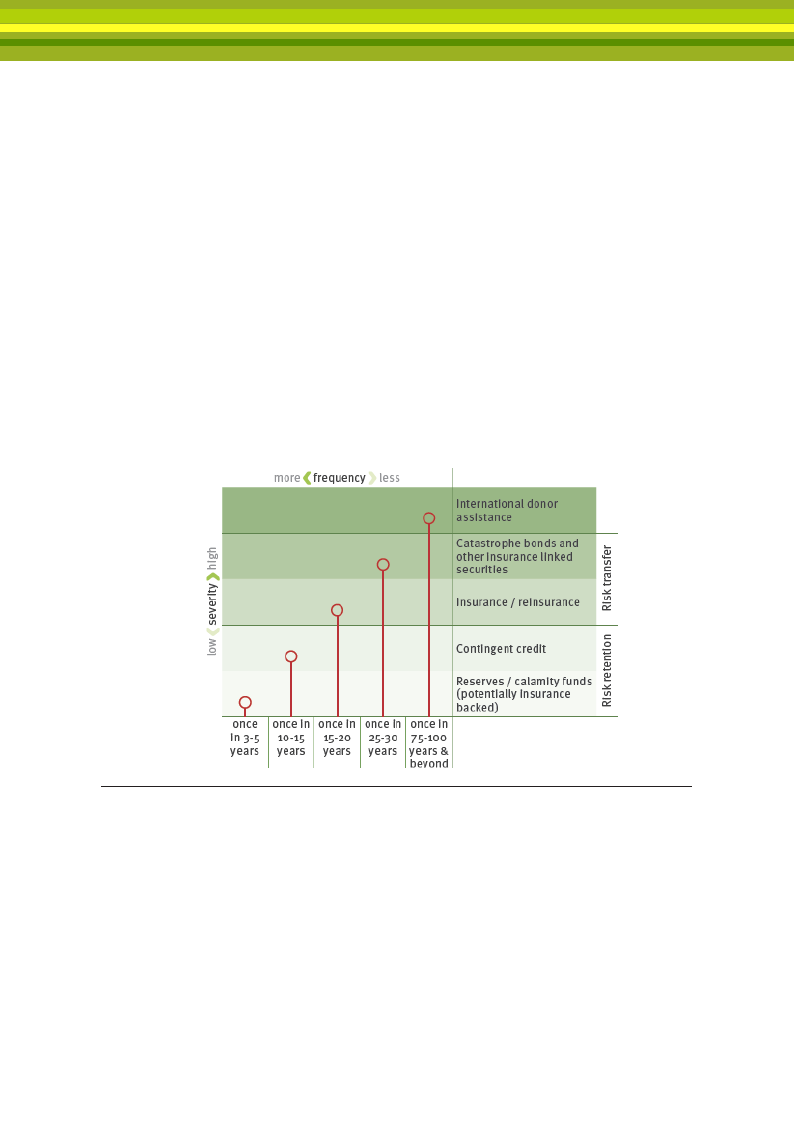
• Post-disaster response, early recovery and reconstruction/rehabilitation
financing –Timely and adequate resources for post-disaster response play a key role
in supporting rapid recovery and reconstruction/rehabilitation of a country following
a disaster, and in minimizing indirect impacts and secondary effects incurred as a
consequence of the direct physical losses. These resources can be provided through
ex-ante financing arrangements such as indemnity and parametric insurance and
catastrophe bonds, contingent loans and disaster reserves, each entailing some
element of forward planning, and related budgetary allocation in anticipation of a
disaster.
A layered approach is widely advocated, combining an array of financing instruments to
meet the remaining risk variously associated with low-impact/high frequency, medium-im-
pact/medium-frequency, and high-impact/low-frequency events (Figure 3.6), and including
some instruments that can be activated rapidly.
Encourage the agency responsible for budgeting and finance and other concerned agen-
cies to develop comprehensive financing strategies, building on the analysis of contingent
liability and of the potential fiscal impacts of disasters to determine how they would meet
the liability associated with hazard events of varying severity.
Figure 3.6 Risk Layering and the Application of Financial Instruments (ADB, 2013; Cummins and Mahul, 2009)
48

3.5 Mainstreaming DRM into Development Projects
Projects are the chief implementation mechanism by which governments use resources
to realize policy goals, action plans, and budgets as tangible outputs. Public investment
projects have specific objectives to achieve within a defined time period and using a
defined budget. As such, many governments use established project management
cycles to guide project-related decision-making. Governments often establish a series of
guidance tools to provide instruction on how to proceed at each stage of the process.
Effective risk-sensitive decision-making requires the integration of disaster risk
assessment and treatment throughout the project management cycle. When disaster
risk is effectively managed, the risk that natural hazards will impede the achievement of
project outcomes is substantially reduced, and the project’s implementation does not
exacerbate the vulnerability and exposure of communities in and around the project
area. This can be done by involve incorporating the following activities:
• Obtaining and understanding the significance of disaster risk information within the
context of the project and make sure it is well identified in ESIA document;
• Incorporating disaster risk considerations into project appraisal; and
• Identifying risk reducing or managing activities for inclusion in project implementation.
Goals of mainstreaming DRM into development projects:
• Ensure that the tools and procedures that guide project management include
directives requiring the consideration, evaluation, and treatment of disaster risk
within the relevant stage of the project management process; and
• Ensure that DRM is incorporated into existing mechanisms for training on public
project management and implementation.
Roles of development/DRM practitioners:
• Advocate for the incorporation of risk information into project concept template;
• Encourage a risk sensitive project appraisal mechanism;
• Support the risk treatment measures and indicators; and
• Encourage risk sensitive project evaluation criteria.
DRM mainstreaming into project cycle management is presented briefly in Figure 3.7 and
general guidance on detailed tasks, activities, and roles for DRM mainstreaming into project
cycle management is explained briefly in Table 3.5.
Getting started in mainstreaming DRM into development projects:
• Understand and critically review the procedures for project formulation and approval
and the responsible agencies;
• Understand and critically review legal requirements for project design (e.g., mandatory
environmental and social assessments);
• Understand and critically review standardized templates or checklists for project
proposals, project planning frameworks, project implementation, monitoring and
evaluation, etc.;
• Follow up with sector planning departments, as sector specific guidelines may be
available;
• Advocate for the inclusion of DRM in project management regulations. The DRM
practitioner can show examples of projects that have been negatively impacted by
recent hazard events, as well as describe how current and future disaster risk
concerns can be addressed using project management tools;
• Support DRM information and knowledge requirements, such as site and sector-
specific hazard and vulnerability data to assist in the design and implementation of
disaster resilient projects;
49
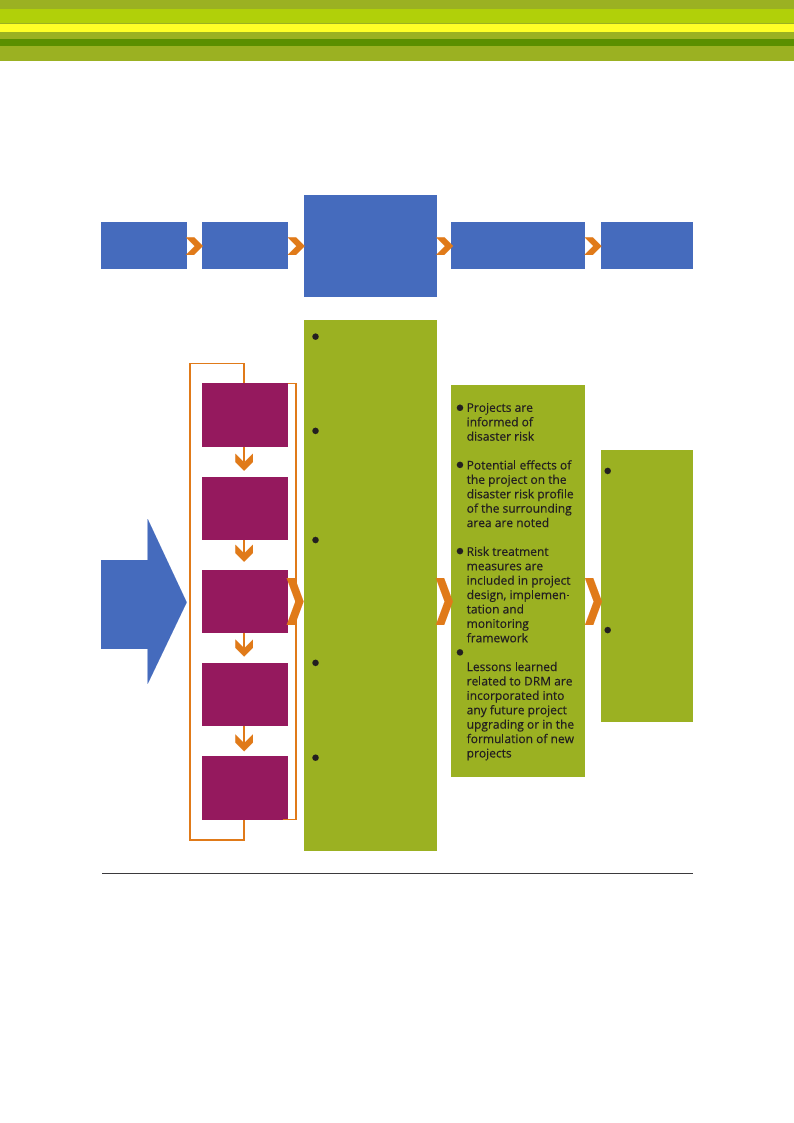
• Access relevant disaster risk information. DRM practitioners can support individual
line agencies and local governments in accessing available hazard and disaster risk
data for proposed development projects; and
• Access sector-specific disaster risk information. Where possible, the DRM practitioner
can work to make sure sector-specific risk information is also easily available.
Getting
Started
Process
Potential Activity
/Action/Role
for DRM
Mainstreaming
into Project
Management Cycle
Outcome
Going
Further
Resource
Availability
Assessment
Initial
Resource
Allocations
Encourage
DRM
expertise in
project
management
teams
Budget
Requests
Budget
Finalization
and Approval
Budget
Implemen-
tation
Advocate for the
inclusion of
disaster risk
information in the
project concept
template
Encourage the
incorporation of
disaster risk
concerns in
existing project
appraisal mecha-
nisms
Support the
adoption of risk
treatment
measures and
indicators via
inclusion in
formulation
guidelines
Encourage the
inclusion of
disaster risk and
DRM consider-
ations in project
evaluation criteria
Aware the inclu-
sion of disaster
risk elements in
ESIA Review ESIA
for its consider-
ation on DRM
Raise
awareness of
DRM
integrated
project
management
regulations
among
government
contractors
Integrate
DRM into
project
management
training
mechanisms
Figure 3.7 Mainstreaming DRM into Development Projects
50

Table 3.5 Process of Mainstreaming DRM into Development Projects:
General Guidance
Process
Protential Activities/Action/Role for DRM
Mainstreaming
Outcome
Identifica-
tion
Project identification often overlaps with the planning
and budgeting phases of the development process.
Governments usually identify development projects
based on an assessment of the problems, needs, and
interests of national stakeholders. These potential
projects are screened and prioritizedd based on the
targets and indicators outlined in national develop-
ment plans. The aim of this identification process is to
determine projects eligible for public funding.
Potential activities in identification:
• Include the rationale of the project, details of the
project site, and a baseline assessment of potential
environmental impacts; and
• Develop a template (often the responsibility of the
national agency managing the project such as the
national planning or budget agency), which may
include the following:
• Hazards that affect the project site and the poten-
tial risk they pose to the completion of the project
and accomplishment of its objectives;
• A directive to examine how potential hazard events
are likely to interact with changes brought about by
the project to communities (especially community
livelihoods), environment, and infrastructure; and
• DRM measures that could be integrated into the
project to manage the identified risks.
Projects are in-
formed of disaster
risk
Appraisal
Following project identification, all significant aspects
of the project concept are studied, taking into account
stakeholders’ views, relevance to national development
objectives, feasibility and other issues. The outcome
is a decision on whether or not to take the project
forward.
Potential activities in project appraisal:
• Use project appraisal tools to analyze economic,
social, environmental feasibility, and impact that
provide an important entry point to gather and
assess detailed information on disaster risk (e.g.,
Technical Analysis, Financial Analysis, Economic
Analysis, Social Impact Assessment (SIA), Environ-
mental Assessment, etc.)
• Consider using the environmental assessment as
a logical entry point for incorporating DRM, as it al-
ready concerns itself with the relationship between
the project and its surrounding environment.
• Within the environmental assessment, there are
two main ways to integrate DRM. One is within the
screening process for determining what level of
assessment is required for individual projects, and
the other is within the assessment itself.
• Once the level of screening has been identified, the
scope of the assessment is defined. The guidelines
for environmental assessment should include
hazard assessment for incorporating DRM consid-
eration.
Potential effects of
the project on the
disaster risk profile of
the surrounding area
are noted
51

Process
Protential Activities/Action/Role for DRM
Mainstreaming
Outcome
• Climate change should be also taken into consid-
eration, such as extreme weather events that may
require higher drainage capacity, sea level rise that
may affect road siting, etc.
Formulation
Once a project is approved for implementation, de-
tailed design and planning is undertaken. Work plans,
logical frameworks, and schedules for implementation
are developed, and the required resources (e.g., hu-
man and financial) are calculated.
Potential activities for project formulation:
• Develop clear and measurable objectives for haz-
ard safety. Critically review the objectives.Use tools
to guide project formulation, which may differ from
project to project. Utilize guidelines for project for-
mulation for DRM integration (e.g., inclusion of risk
treatment measures in project design based on the
results of project appraisal).
• As different types of measures will be necessary for
different types of projects, ensure that these mea-
sures aim to both reduce disaster risk as well as
manage the remaining risk that cannot be reduced.
• Ensure that project budgets include the potential
extra costs of material, skilled labor, etc., to under-
take the DRM measures.
• During project formulation, ensure that disaster
risk-related targets, indicators, means of verifica-
tion, and assumptions in the project’s manage-
ment system or logical framework from the DRM
perspective are well established as per the project
objectives.
• Ensure that project monitoring is established with
a DRM perspective by including the procedures list-
ed below in the relevant section of any guidelines
describing how to set up a logical or results based
framework for project monitoring (UNDP, 2008).
• Include targets and indicators to monitor any DRM
related project components.
• Consider potential hazard impacts when identifying
critical risks and assumptions.
• Include a consideration of natural hazards when
developing the project’s risk management plan and
establishing risk indicators.
• Monitor and assess project performance in terms
of any DRM components and in terms of the
impact of any disaster event on the project and
its surrounding environment. Where necessary,
modify project activities, targets, and objectives
accordingly.
• Promote the establishment of sector-specific DRM
related targets and indicators to use for future
projects.
Risk treatment mea-
sures are included
in project design,
implementation, and
monitoring frame-
work
52

Process
Protential Activities/Action/Role for DRM
Mainstreaming
• Establish a list of potentially appropriate DRM
indicators by sector or theme that can be referred
to in setting indicators during the design of future
projects.
Implemen-
tation
During the implementation phase, resources to carry
out the planned project activities are agreed upon in
order to achieve project objectives. Progress is as-
sessed through monitoring to enable adjustment to
changing circumstances.
Outcome
Potential activities for project implementation:
• Ensure routine appointment of an independent
monitoring agent or team to be responsible for
tracking and ensuring the project’s compliance with
DRM-specific targets and indicators.
Evaluation
and Feed-
back
The assessment of the project’s relevance and success
is based upon an examination of the efficiency, effec-
tiveness, impact, and sustainability of the project mea-
sured against the project objectives. The conclusions of
this evaluation are taken into account when planning
and implementing similar projects in the future.
Potential activities for project evaluation and feedback:
• Ensure sector and planning agencies include disas-
ter risk and DRM in project evaluation criteria.
• Ensure that standard set of project evaluation
criteria to assess project relevance, effectiveness,
efficiency, impact, and sustainability include DRM
components.
Lessons learned
related to DRM are
incorporated into
any future project
upgrading or in the
formulation of new
projects
Going further for mainstreaming DRM into development projects: Key tasks
• Support actual implementation by raising awareness of government and private
sector contractors and project managers.
• Acquire a list of companies usually contracted by the various sector agencies and
send them information regarding the changes in project requirements with respect
to DRM.
• Contact national organizations responsible for training civil servants on project
management and suggest integrating information regarding the new regulations into
course curriculum.
53

References and Additional Reading:
Anderson, J.E. (2003). Public Policy-Making: An Introduction. Boston: Houghton Mifflin.
Asian Development Bank (ADB). (2013). Investing in Resilience: Ensuring a Disaster-Resistant Future. Mandaluyong
City, Philippines: Asian Development Bank, 2013.
Asian Disaster Preparedness Center (ADPC). (2013). Integrating Disaster Risk Management into the Development
Process. Disaster Risk Management Practitioner’s Handbook Series. Bangkok.
Benson, C. (2009). Mainstreaming Disaster Risk Reduction into Development: Challenges and Experience in the Phil-
ippines. Geneva: ProVention Consortium.
Benson, C. (2011). Integrating Disaster Risk Reduction into National Development Policy and Practice, in J. C. Gail-
lard, Ilan Kelman and Ben Wisner, eds. The Routledge Handbook of Hazards and Disaster Risk Reduction and
Management. London: Routledge.
Benson, C., R. P. Gyanwaly, and H. P. Regmi. (2009). Economic and Financial Decision Making in Disaster Risk
Reduction: Nepal Case Study. Geneva: United Nations Development Programme.
Cummins, J. D., and O. Mahul. (2009). Catastrophe Risk Financing in Developing Countries: Principles for Public
Intervention—Overview. Washington, DC: World Bank.
UNDP. (2008). Mainstreaming Disaster Risk Management into Sub-National Development and Physical Planning
– A Case Study from the Philippines. Bureau of Conflict Prevention and Recovery, United Nations Development
Programme.
World Bank. (2013). Beyond the Annual Budget: Global Experience with Medium-Term Expenditure Frameworks.
Washington, DC.
54

Part 4: Guidelines for Mainstreaming
Disaster Risk Management into
Policy and Planning in Ethiopia
4.1 Development Planning Process in Ethiopia3
The Government of Ethiopia has had a planned approach to development since
1952-1953. In 1955, the National Economic Council (NEC) (as administrative machinery)
was established for formulating development plans. The NEC consisted of a planning
board and a secretariat, which was specifically charged with the task of establishing
development plans. Ethiopia’s First Five Year Development Plan (1957-61) and its
Second Five Year Plan (1962-67) were prepared under this arrangement.
3 Getachew 2015
55
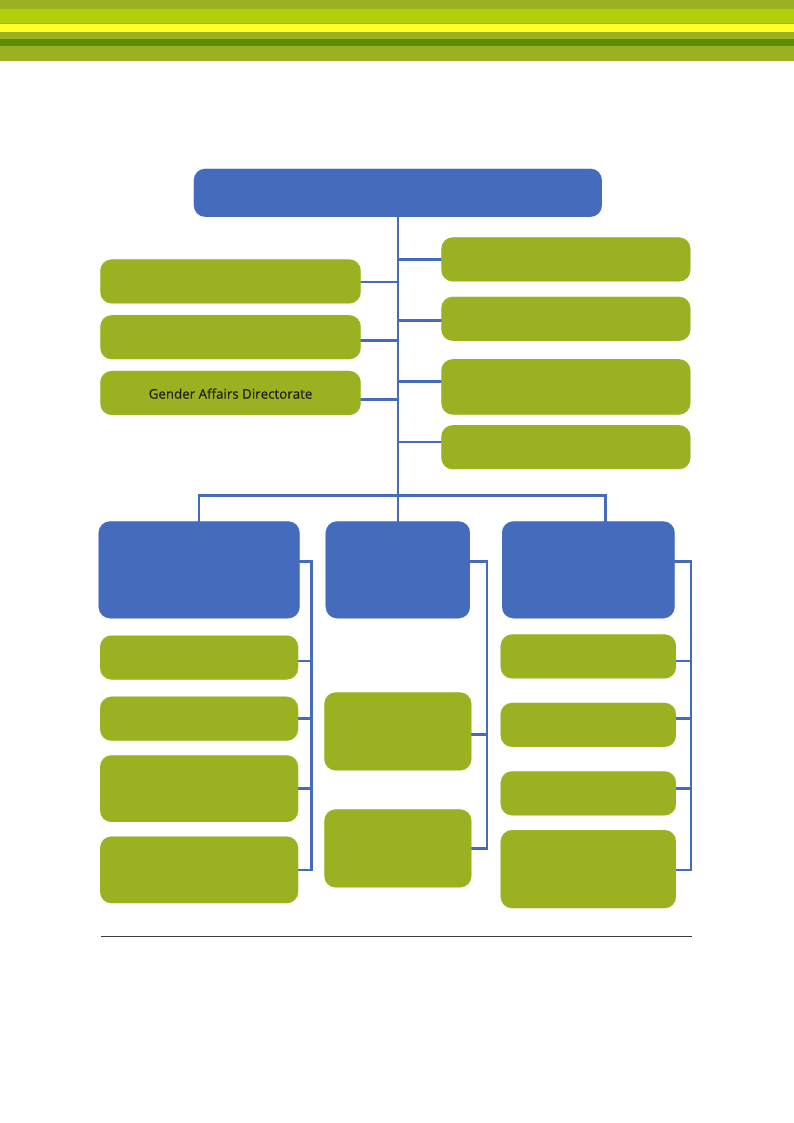
National Planning Commission Commissioner
Internal Audit Service Directorate
Corporate Communication
Directorate
Planning and Finance Directorate
Reform and Human Resource
Management Directorate
Information Technology and
Knowledge Management
Center Directorate
Corporate Supply Service
Directorate
Macro Plan
Preparation and
Management Deputy
Commissioner
Macro Plan Preparation
and Processing
Development
Projects Directorate
Population and
Development
Directorate
Perspective Plan
Preparation and
Research Directorate
Monitoring
and
Evaluation
Bureau
Development Projects
Performance
Monitoring
Directorate
Plan Implementation
Monitoring and
Evaluation
Directorate
Sectoral Plan
Preparation
Deputy
Commissioner
Productive Sector Plan
Directorate
Economic Services Plan
Directorate
Infrastructure Plan
Directorate
Human Resource
Development and
Employment Directorate
Figure 4.1 Organizational Structure of the National Planning Commission in Ethiopia (Authors’ compitation form Getachew, 2015)
56

Under a new institutional framework, the National Planning Council and National
Planning Commission (NPC) were founded by the Council of Ministers Regulation
no. 281/2013 (Figure 4.1). The NPC is accountable to the prime minister who
is a chairperson of the National Planning Council in Ethiopia (Figure 4.1). The
Council consists of the prime minister (as a chairperson), cabinet ministers
(as members), chief executives of regional states (as members), deputy chief
executives of regional states (as members), Governor of the National Bank
of Ethiopia (as a member), and other organs to be designated by the prime
minister. Powers and duties of the National Planning Council include: 1) setting
overall long-term perspective and five years’ medium-term growth targets; 2)
providing general guidance for planning and development priorities; 3) approving
the plan; and 4) reviewing the periodic evaluation results.
The NPC is accountable to the National Planning Council and has the following
power and duties:
• Serves as the secretariat of the National Planning Council and provides
support as needed;
• Prepares long-term and medium-term development plans and strategies;
• Conducts research and development;
• Conducts monitoring and evaluation; and
• Consults and provides capacity building expertise.
Preparation of National Development Plans and Institution
While preparing the national development plans, the following aspects are
generally considered:
• The Constitution of the Federal Democratic Republic of Ethiopia provides
power to the federal government to formulate and implement national
policies, strategies, and plans with respect to overall economic, social, and
development matters;
• Accordingly, the federal government is responsible for designing and
implementing vertically coherent and horizontally consistent national
development plans, which are based on national development needs and
priorities;
• The national development plan in Ethiopia is internally driven with strong
sense of full ownership and political commitment of the government;
• Sectoral polices and proclamations determine mandates and provide
power to exercise the mandates; and
• To enhance the sectoral integration, four clusters have been established
under the Prime Minister’s Office: 1) Macro Economy Cluster; 2) Finance
and Economy Cluster; 3) Good Governance and Civil Service Reform Cluster;
and 4) Social Issues Cluster.
Key Institutions and Stakeholders
Within the national development plan preparation process, the following clusters,
institutions, and councils have major roles:
• National Macro Economy Cluster
NPC, MoFEC, National Bank of Ethiopia Revenues, and Customs
Authority are the major members
Develop macroeconomic framework based on the government
priority, policy, country vision development priority, global and
regional agreement, trends, etc.
57

Provide general guidelines and direction
• National Planning Commission
Formulate macro-economic targets and framework
Provide generic guidelines for clusters
Provide technical support to clusters
Ensure the global and regional agenda of mainstreaming
Prepare draft national plan
Consultation and discussion on the draft plan
Preparation and submission of the final national plan to the National
Planning Council and the House of People Representative (HoPR)
• Finance and Economy Cluster, Good Governance, Civil Service Reform
Cluster, and Social Issues Cluster:
Each cluster coordinates and prepares respective line ministry’s plan
based on generic guideline
Mainstream global and regional goals in their plan
Submit respective cluster plans to NPC
• Council of Ministers/National Planning Council
Approve the plan(s)
Provide direction and recommendations
• House of People Representative (HoPR)
Endorse development plan document
Make it a legally binding development plan document for the next
five years
Stages of the Planning Process4
The stages of the planning process in Ethiopia pass through a series of iterative
stages:
Preliminary Stage
• In this initial stage, the state and government, consisting of Council of
Representatives or Council of Ministers, provide guidelines on the
economic, social, and political tasks, which serve as the starting point for
the planning institution to initiate the planning process.
Analytical Stage
• At this stage, evaluations of the socio-economic conditions and the
international economic situation in the country are conducted, as well
as an analysis of the state of the economy at the beginning of the plan
period, assessment of the plan implementation, identification of socio-
economic issues, and identification of development constraints. The
analysis is the foundation for developing goals and objectives for the
development plan. The rates and main proportions of development
needed to attain the set objectives are calculated by:
-
Preparing alternative growth scenarios that could bring about the
achievement of the specified objectives under various assumptions;
-
Analyzing the strengths and weaknesses for each scenario and
selecting the best growth scenarios; and
-
Integrating the above processes to serve as the macro-framework
(guidelines), which contains mainly:
4 The stages of planning process represent the theoretical aspect of planning process and provide options for DRM
mainstreaming. In practice, it is subjected to government structure arrangement in the country.
58

The analysis of current economic situation;
Overall objectives, goals, and strategies;
GDP and sectoral growth variants;
Investment ceilings (sectoral and global);
The budget frame; and
Balance of payments projection.
Adjustment and Directive Stage
• This stage selects the most appropriate course of development
requirements at various levels with the available resources. This stage
transmits the plan guidelines to sectoral agencies and regional planning
offices with instructions to prepare and submit their own plan proposals
according to a specific time schedule.
Plan Elaboration Stage
• The step involves the process of preparing a draft plan that will be sent to
the highest authority. The sectoral plans will then be further elaborated
and submitted to respective corporations to examine and adjust the
proposals then re-submit to the respective sectoral ministries.
• The ministries will adjust and re-examine the sectoral plan and submit
the consolidated plan to the respective sectoral department planning
institution.
• Sectoral departments of the planning office will examine the plan in-terms
of efficiency and consistency with the objectives, production, service, and
investment targets. This stage would require active interaction with the
respective ministries.
Plan Adoption Stage
• In this stage, the planning office submits the draft plan to the Council of
Ministers of consideration, and the Council of Ministers will make necessary
corrections and adjustments and submit the draft plan to the Council of
Representatives for final approval.
Plan Implementation Stage
• At this stage, the plan approved by the highest organ of state in the
country is distributed by the planning institution to sector ministries,
commissions, regions, etc. Upon receiving the approved plan, sector
ministries, corporations, regions, enterprises, and commissions prepare
action plans based on their respective approved plans and start
implementing it. This stage also involves follow-up and reporting activities
of the implementation phase of the approved plan.
DRM mainstreaming into the development planning process in Ethiopia is
presented briefly in Table 4.1 and general guidance on detailed tasks/activities/roles
for DRM mainstreaming has been explained briefly in Table 4.2.
59
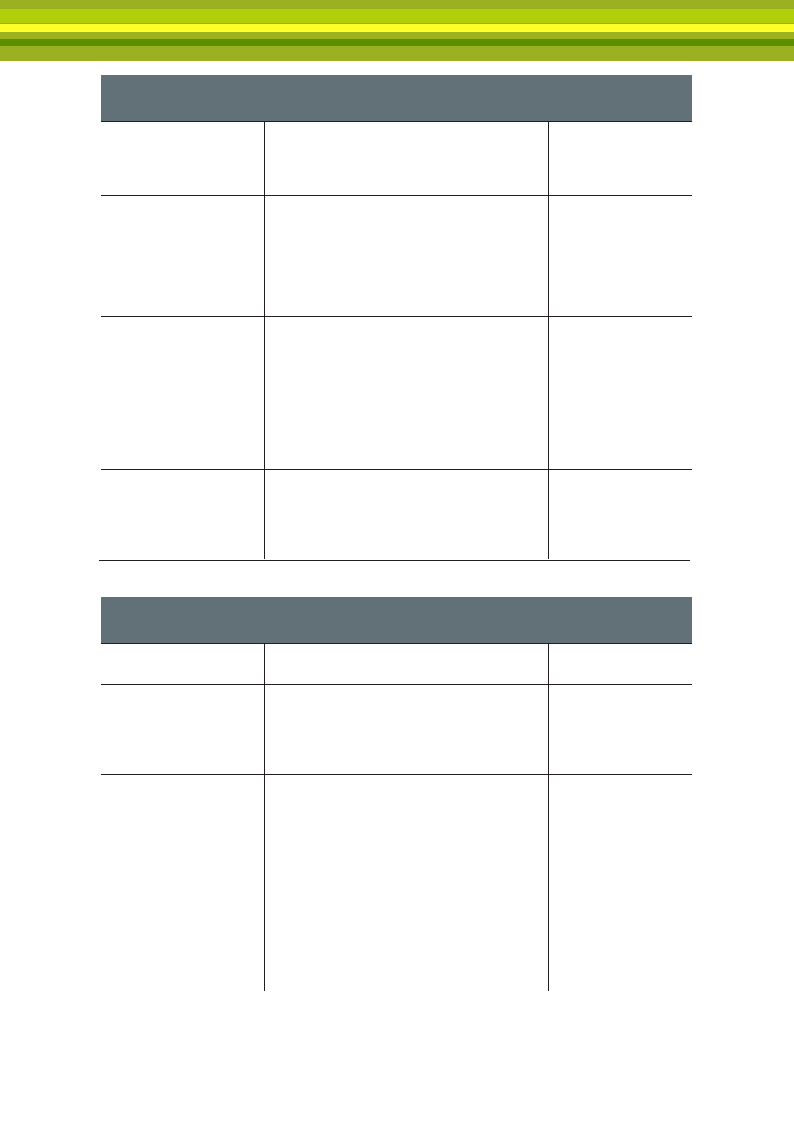
Table 4.1 Getting Started in Mainstreaming DRM into the Development
Planning Process in Ethiopia: Key Tasks
Mainstreaming DRM
into Development
Planning: General
Guidance
Key Tasks
Remark
Risk assessment and
cross-sector dialogue
are vital for analyzing
the sectors that are
most vulnerable to
disaster impacts and
determining priorities
• Refer to WDRP, reports, analysis, and
Sector is identified as
minutes of sectoral task forces, and Dis- most vulnerable
invetar system for analyzing sectors that
are most vulnerable and priorities
Analyze direct financial •
losses and service inter-
ruption caused by disas-
ters as well as the extent
to which funds were
•
channeled away from
development activities
to disaster response
and recovery
Refer to Disinvetar system for Ethiopia to
gather data on direct financial losses and
service interruption from major recent
disasters
Refer to documents of Ministry Finance
and Economic Development for under-
standing the funds channeled away from
development activities to response and
recovery
Encourage the national
planning agency to
include DRM expertise
in all relevant technical
committees
• Develop or strengthen mechanism or
process to include DRM expertise in all
relevant technical committees respon-
sible for GTP
Where relevant, each
committee of GTP
consists DRM expert
Table 4.2 Guidance for Mainstreaming DRM into the Development
Planning Process in Ethiopia
Process
Potential Activities/Action/Role for DRM Outcome
Mainstreaming - Steps
Preliminary Stage
Summary: Initial stage where guideline on
the economic, social, and political tasks are
given, which serves as the starting point for
the planning institution to initiate the plan-
ning process in the country.
Sector is identified as
most vulnerable
Analytical Stage
Summary: Evaluation of socio-economic
conditions in the country as well as the inter-
national economic situation, analysis of the
state of the economy at the beginning of the
plan period, etc.
It also includes the development of the
macro-framework guideline, which consists
of analysis of current economic situation,
overall objectives, goals and strategies, GDP
and sectoral growth variants, investment
ceilings (sectoral and global), the budget
frame, and balance of payments projection.
60

Process
Potential Activities/Action/Role for DRM Main-
streaming - Steps
Outcome
Suggestions:
• Assessment and analysis of past achievements and
challenges to also consider the impacts of disasters
in Ethiopia
Note: Refer to WDRP, reports, analysis and minutes of the
sectoral task forces, and Disinvetar system for analyzing
the challenges related to disasters in Ethiopia
• Determine how disasters resulted in shortfalls in
targets directly or indirectly
• Emphasize both the impacts of any large disaster
that hit during the past plan, and the cumulative
impacts of small disasters
• Make the connection between DRM and develop-
ment targets, such as poverty reduction
• Undertake disaster risk analysis as part of the sec-
tor assessment
Note: Refer to the documents of Ministry Finance and
Economic Development for understanding the funds chan-
neled away from development activities to response and
recovery
• Provide relevant background material for undertak-
ing the assessment
Note: Refer to the training and user manual and reports of
the WDRP
• Initiate short-term studies, background papers, or
focus group discussions among experts on nation-
al trends that may have affected previous develop-
ment, such as changes in migration patterns
Note: Refer the risk treatment measures – City Strength:
Resilient Cities Program
• Include a study on urbanization, climate change,
and disaster trends and their impacts
• Note: Refer the risk treatment measures – City
Strength: Resilient Cities Program
Once an analysis of the current situation is complete,
set goals for the country’s development and sector
objectives for the coming plan period. This is usually
done by the national planning agency, in consultation
with other government agencies.
Suggestions:
• Reference international agreements, national
frameworks, and post-disaster and risk assess-
ments to guide the responsible agencies in estab-
lishing specific DRM goals
Note: Refer to the DRM-SPIF, Programme of Action (PoA)
for the Implementation of the Sendai Framework for Disas-
ter Risk Reduction 2015-2030 in Africa
• Integrate disaster risk as a cross-cutting issue
• Establish specific goals and objectives for DRM
Note: Refer to the DRM-SPIF
61

Process
Adjustment
and Direc-
tive Stage
Potential Activities/Action/Role for DRM Main-
streaming - Steps
Outcome
• Ensure that goals relate to the key disaster risk
issues identified in the assessment of development
challenges, and to objectives in any national legisla-
tion, policies or action plans for DRM or climate
change adaptation. For example, frequent flood-
ing may be identified as a development challenge.
Protecting communities in flood prone areas could
be a goal from which strategies and targets are
created.
• Incorporate DRM into sector goals and objectives.
For example, GTP and CRGE goals commonly ap-
pear in development plans and their achievement
is strongly linked to disaster risk.
• Develop post-disaster assessments, poverty analy-
ses, and risk assessments to stress to planners the
ways in which:
- Disasters impact human development and
reinforce the poverty cycle
- Risk reduction efforts can help populations
escape the poverty trap
- Efforts to reduce income poverty and improve
basic social conditions can improve disaster
resilience
Summary: This stage transmits the plan guidelines
to sectoral agencies and regional planning offices with
instruction to prepare and submit their own plan pro-
posals according to a specific time schedule.
Suggestions:
The planning guidelines
• Push for the inclusion of DRM-related principles
and priorities in the guidelines so that there is a
mandate to consider and address disaster risk
throughout priority development sectors
• The guidelines should: 1) encourage the use of a
risk assessment as part of the planning process; 2)
require that development strategies be based on
the results of disaster risk assessment and ESIA;
3) require the inclusion of specific DRM targets
and indicators for monitoring purposes; and 4) for
subnational plans, encourage inter-district or inter-
state considerations for effective
• Monitoring and evaluation indicators and their
means of verification can be drawn from DRM
frameworks utilized internationally such as those
found in UNISDR’s HFA monitor, or the Making
Cities Resilient: Local Government Self-Assessment
Tool
Ensure that the
guidelines include
section on ‘where’
and ‘how to’ incor-
porate DRM into
development plan
preparation
62

Process
Plan Elabo-
ration Stage
Plan Adop-
tion Stage
Potential Activities/Action/Role for DRM Main-
streaming - Steps
Outcome
Summary: This stage addresses the preparation of
the draft plan and examination and re-examination of
draft plan by the planning office of the sector ministry.
Suggestions:
• DRM is a required criterion for approval by plan-
ning office. The following questions can be incorpo-
rated:
- Does the plan take adequate consideration of
sector, district, provincial, or state hazards?
- Does the plan include necessary structural,
non-structural, and environmental measures to
reduce the risk of disaster?
- Does the plan encourage disaster resilient sector
growth in safe locations using resilient practices?
Note: The planning office should be aware of the DRM is-
sues and ways in which DRM can be incorporated into the
development plan.
• DRM practitioners can advocate and raise aware-
ness of the sector planning office about the link
between disasters and development at national
and local levels.
• In the case of approving local development plans,
national planning agency can be encouraged to
focus attention on protecting local infrastructure
and development clusters
Note: DRM practitioners can share best practices or case
studies with NPC on resilient infrastructure in the planning
region and how that infrastructure able protect lives of the
people from natural hazards.
Disaster resilient
initiatives are priori-
tized in the plan
Summary: In this stage, the planning office submits
the draft plan to the Council of Ministers for consider-
ation, and they will make necessary corrections and ad-
justments and submit the draft plan for to the Council
of Representatives for final approval.
The socio-economic
development plan
promotes risk sensi-
tive development
Suggestions:
• Raise awareness of the role of disaster risk in
development and advocate for the adoption of risk
sensitive goals and targets.
• For raising awareness, the results of the initial
analysis regarding the effects of disasters on the
previous plan can be used.
• Use the findings from the risk assessments and
cost-benefit analyses to bolster the argument.
Note: Incorporate WDRP, other risk assessments, DRM-
SPIF goals and targets into final approved plan by the
NPC.
63

Process
Plan Imple-
mentation
Stage
Potential Activities/Action/Role for DRM Main-
streaming - Steps
Summary: During this stage, the plan approval is
completed by the highest organ of state in the country
and is distributed by the planning institution to sector
ministries, commissions, regions, etc., for implementa-
tion. It also deals with follow-up and reporting activities
of the implementation phase of the approved plan.
Outcome
Disaster resilient
initiatives are priori-
tized in the plan
Suggestions:
• Review the plan to highlight any disaster impacts
on performance and to emphasize the importance
of DRM
• Both direct and indirect impacts of disasters can be
highlighted, such as reallocation of funds for relief
and reconstruction making it financially difficult to
build the number of schools required to meet the
goal
Note: Incorporate monitoring and reporting of DRM mea-
sures in Ethiopia within the follow-up and reporting activi-
ties of the implementation phase of the approved plan.
References and Additional Reading:
Getachew, H. (2015). The Ethiopian New Institutional Framework. Presentation. 17-18 Nov 2015.Incheon, South
Korea.
64

Part 5: Guidelines for Developing
Risk-Sensitive Sectoral
Investment Plans
This part deals with mainstreaming DRM into risk-sensitive sectoral investment
plans. It particularly targets sector plans that are developed under the National
Development Plan of Ethiopia (i.e., GTP – II). For mainstreaming DRM, eight key
sectors/sub-sectors are prioritized and selected through several consultation and
meetings with NDRMC, Ethiopia. They are: (1) Agricultural and rural transformation sector,
(2) Environment and climate resilient green economy, (3) Health sector development,
(4) Potable water supply and irrigation development sector, (5) Integrated transport and
logistics services, (6) Urban development and housing, (7) Education and training, and
(8) Social welfare and security (safety net) (National Planning Commission, 2016a; National
Planning Commission 2016b). The Ministry of Finance and Economic Corporation
(MoFECC) is also considered the key agency for mainstreaming DRM, with particular
consideration budget and resource allocation for mainstreaming activities.
Sector specific mainstreaming of DRM is based on the six steps shown in the Figure 5.1,
and a brief description of each step is presented in Table 5.1. Figure 5.1 presents a
systematic process of mainstreaming DRM into sectors and the outcome of this process
will lead to the establishment of a conceptual framework for sectoral DRM (Figure 5.2).
Table 5.2 provides brief description of the conceptual framework for sectoral DRM.
65
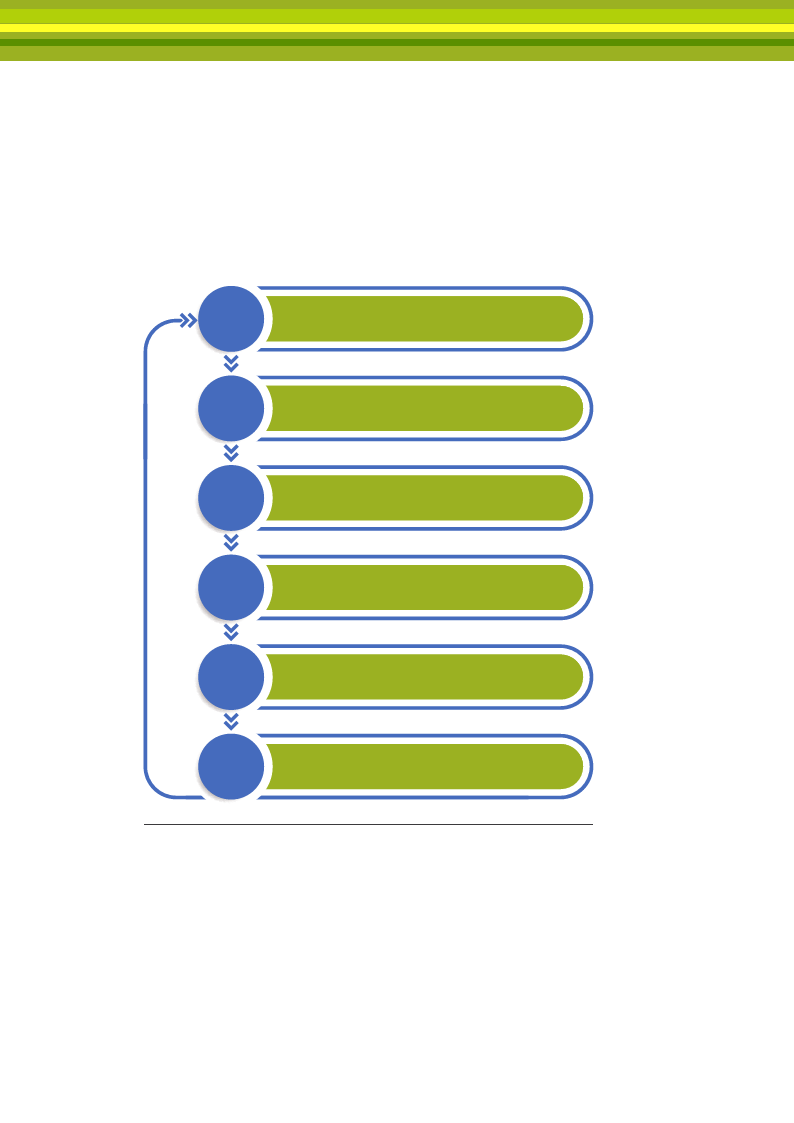
Step
1
Planning for Engagement
Step
2
Situation Analysis
Step
3
Mainstreaming Action
DevelopmentProcess
Step
4
Costing of Actions &
Development of Implementation Plan
Step
5
Approval Process
Step
6
Implementation, Monitoring
and Evaluation
Figure 5.1 Steps for Mainstreaming DRM into Sector (Illustration from authors)
66

Table 5.1 Broad Mainstreaming Steps & Descriptions
Mainstreaming
Step
Brief Description
Agency
Step 1: Planning
for Engagement
The objective of step 1 is to generate a high •
level of advocacy with the sector agency to
promote the need to mainstream DRM into •
the sector. The outcome of this step should
lead to the development of sectoral team
that is assigned to conduct a situation analy- •
sis for the specific sector.
•
•
Note: NDRMC and National Development
Planning Commission, specific sectoral agencies •
can start with deluges. This can also include
economic benefit of DRM investment into devel- •
opment plans.
All lead sector agen-
cies/focal points5
National Disaster Risk
Management Commis-
sion
National Planning
Commission
Development and hu-
manitarian partners
Private public partner-
ships
Other organizations
(CBOs/NGOs)
Step 2: Situation
Analysis
Step 2 deals with information collection,
•
identification of key problems (hazards
context, risk and vulnerability context,
•
institutional arrangements and policies,
stakeholders’ analysis, existing programs/
projects, donor analysis etc.,), review legisla- •
tion, review sectoral strategies to address
disaster risk, review sectoral instruments,
•
review sectoral risks, review coordination
and information sharing, etc.
•
Note: Each sector development planning office •
under the National Planning Commission of
Ethiopia can make use of available resources to
complete a situation analysis, such as wereda
risk profiles, DesInventar data management
system, etc.
All lead sector agen-
cies/focal points5
National Disaster Risk
Management Commis-
sion
National Planning
Commission
Development and hu-
manitarian partners
Private public partner-
ships
Other organizations
(CBOs/NGOs)
Step 3: Main-
streaming Action
Development
Process
Step 3 deals with the problem validation
process, problem prioritization process,
problem-solution tree analysis, and action
matrix development. It prioritizes actions in
line with GTP-II actions.
Note: For guidance refer to “Programme of
Action for the Implementation of the Sendai
Framework for Disaster Risk Reduction 2015-
2030 in Africa”, GTP II and DRM SPIF, while
developing actions for mainstreaming DRM.
• All lead sector agen-
cies/focal points5
• National Disaster Risk
Management Commis-
sion
• National Planning
Commission
• Development and hu-
manitarian partners
• Private public partner-
ships
• Other organizations
(CBOs/NGOs)
67

Mainstreaming
Step
Step 4: Costing
of Actions and
Development of
Implementation
Plan
Step 5: Approval
Process
Step 6: Imple-
mentation,
Monitoring, and
Evaluation
Brief Description
Agency
Stage 4 deals with identifying and developing •
a financial strategy, implementation strategy,
communication strategy, and a monitoring •
and evaluation plan. These strategies should
be developed in line with GTP – II strategies.
•
Note: For guidance, refer to the process of
developing GTP – II – finance, implementation, •
communication, monitoring and evaluation
strategies.
•
•
Step 5 deals with obtaining political support •
for risk sensitive development; strong na-
tional leadership on DRM from key sectors; •
mechanisms to enforce DRM policies; high
levels of public awareness about risks and
risk reduction; adequate technical capac-
•
ity to undertake risk-reduction actions; and
incentives that create strong political interest •
in risk-informed planning.
•
Note: Refer to national and sectoral approval
process for GTP – II for guidance and follow
•
procedures for approving mainstreaming DRM
actions for each sector.
Step 6 deals with implementation, monitor- •
ing, and evaluation of mainstreaming DRM
action for each sector. Refer to UNISDR
•
monitoring and evaluation framework for
guidance.
•
Note: Refer to the implementation, monitor-
ing, and evaluation process of GTP-II and
•
aligned monitoring and evaluation frame-
work of UNISDR.
•
•
All lead sector agen-
cies/focal points5
National Disaster Risk
Management Commis-
sion
National Planning
Commission
Development and hu-
manitarian partners
Private public partner-
ships
Other organizations
(CBOs/NGOs)
All lead sector agen-
cies/focal points5
National Disaster Risk
Management Commis-
sion
National Planning
Commission
Development and hu-
manitarian partners
Private public partner-
ships
Other organizations
(CBOs/NGOs)
All lead sector agen-
cies/focal points5
National Disaster Risk
Management Commis-
sion
National Planning
Commission
Development and hu-
manitarian partners
Private public partner-
ships
Other organizations
(CBOs/NGOs)
Source: Authors’ compilation from mainstreaming DRM resources
* Information presented on agency in above table is illustrative and not exhaustive. It is subject to government structure ar-
rangement in the country.
5 Identified in the National Policy and Strategy on Disaster Risk Management, the Federal Democratic Republic of Ethiopia
68
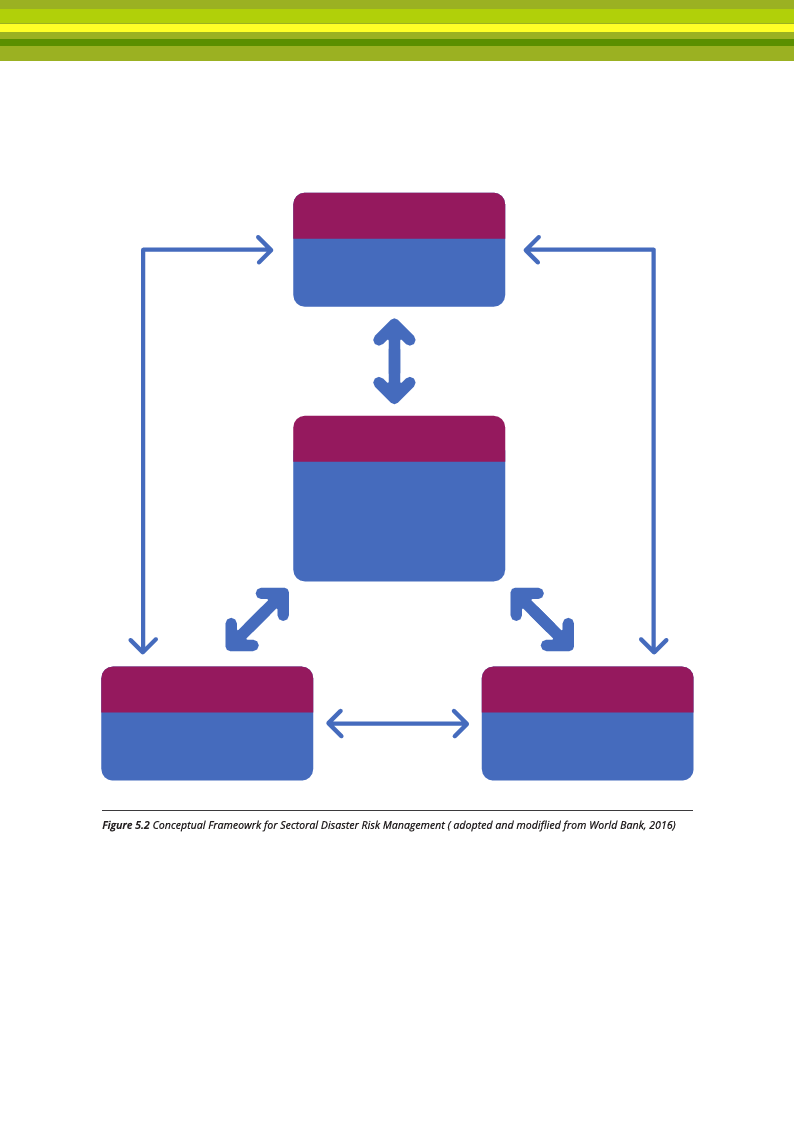
The implementation of these six steps for mainstreaming DRM will lead to the
establishment of a conceptual framework for sectoral disaster risk management
(Figure 5.2). The sectoral DRM framework in Figure 5.2 presents two-ways linkages
between sectoral risks, sectoral instruments, and sectoral strategies and Table 5.2
provides description of the key elements and sub-elements.
Sectoral Instruments
Policy Plan
Programme/Projects
Stakeholders
Local Community,
Private Sector,
Development Partners
Public Sector,
Planners, Policy Makers,
Practitioners, etc.
Sectoral Risks
Hazard,
Vulnerability,
Exposure, Capacity
Sectoral Strategies
Mitigate
Transfer
Cope
69

Table 5.2 Explanation of Conceptual Framework for Sectoral DRM
Elements
Description
Sectoral Risks
Risks faced by any sectors can be classified and assessed through hazard,
vulnerability, exposure, and capacity elements. For instance, for the agri-
culture sector, they can be classified as production risks, market risks, and
enabling environment risks.
Note: This information can be useful for the formulation of risk sensitive sec-
toral instruments to inform stakeholders about the risks, and to designed the
sectoral strategies.
Stakeholders
Stakeholders affected by disasters can be classified into different catego-
ries: Local communities living in hazard prone areas; public and private
sector institutions; government; development partners; donors; commer-
cial stakeholders; etc. For instance, for the agriculture sector, the primary
stakeholders include producers, commercial sector stakeholders, and the
public sector.
Note: The stakeholders can play an important role in developing sectoral risk
assessments, sectoral DRM strategies, and risk sensitive sectoral instruments.
Sectoral
Strategies
Sectoral strategies consist of three types of risk management strategies:
mitigation, risk transfer, and coping.
Risk mitigation (ex ante): Risk mitigation strategies are actions taken
prior to a risk event to reduce the likelihood of risk. Examples include
adoption of improved agronomic practices such as soil drainage and
mulching, and conservation farming.
Risk transfer (ex ante): As not all effects of realized risks can be miti-
gated, risk transfer tools and mechanisms transfer the potential financial
consequences of particular risks from one party to a willing third party,
usually for a fee or premium (for example, purchasing insurance, reinsur-
ance, and financial hedging tools).
Sectoral
Instruments
Risk coping (ex post): Some risks cannot be mitigated or transferred, so
risk coping strategies are required to help stakeholders better absorb and
recover from their impacts. Examples include some form of compensation
(cash or in-kind), social safety net programs, buffer funds, savings, strategic
reserves, and livelihood recovery programs.
There are three major types of instruments used to implement the risk
management strategies.
Policy: Improved risk management often entails policy reforms. For ex-
ample, legal or regulatory reforms to improve access to agricultural inputs.
Investment plan: Although policy reforms mainly require political will,
other risk mitigation measures can be costly. Examples are financial in-
vestments in irrigation infrastructure, research into drought- and disease
resistant and pest-tolerant cultivars.
Program/projects: Technical assistance (TA): TA is geared toward build-
ing local stakeholders’ capacity. For example, training in price risk manage-
ment; feasibility studies for various instruments; flood risk modelling work,
etc.
Source: (World Bank, 2016)
70
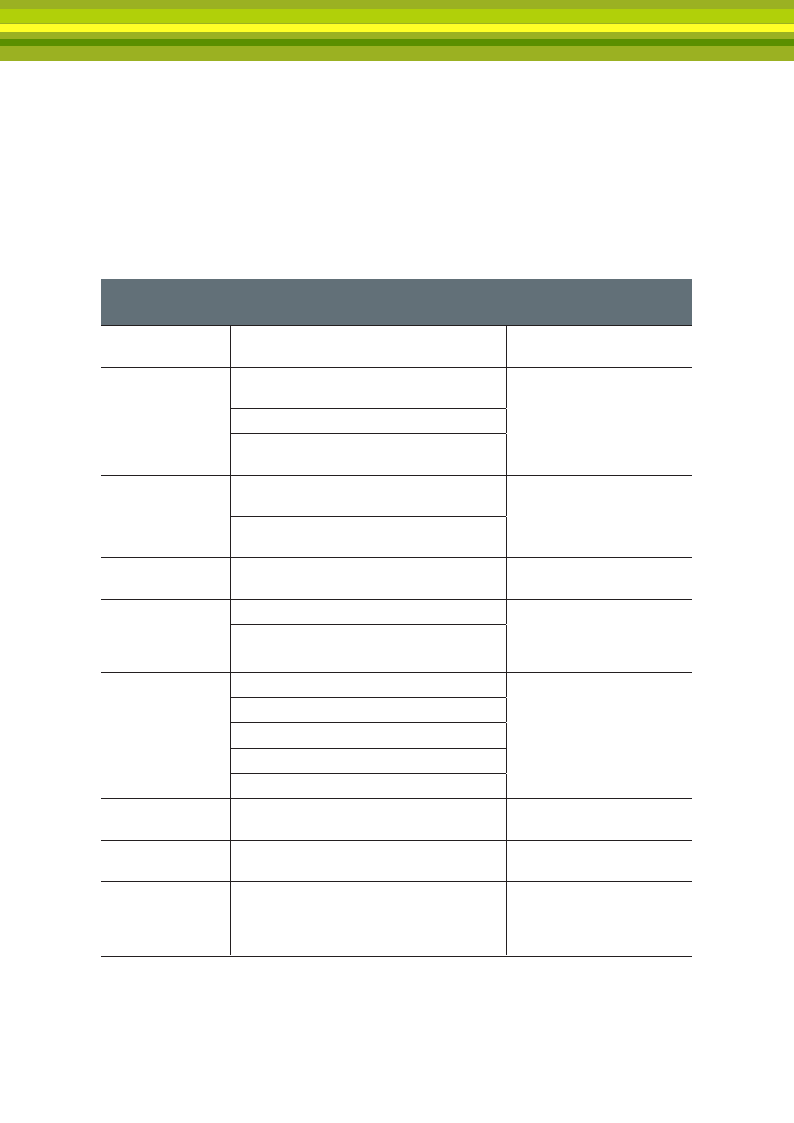
Selected sector and lead sector agencies for DRM mainstreaming
As mentioned earlier, in consultation with NDRMC, eight sectors are selected for
developing the guidance on DRM mainstreaming. For each sector, lead sector
agencies are identified in Table 5.3. While doing DRM mainstreaming, the sec-
tor lead agencies may utilize data and resources available with NDRMC, such as,
WDRP. Where the data is not efficient, the NDRMC and lead sector agencies
may work together for enhancing the data/sources for DRM mainstreaming for
the selected sector. The relevant data for DRM mainstreaming is supposed to
be provided by the relevant lead sector agencies or are subject for assessment
in collaboration with NDRMC and the respective lead sector agencies (Table 5.3).
Table 5.3 Selected Sector and Lead Sector Agencies for DRM
Mainstreaming
Sector/
Sub-sector
Lead Sector Agencies
Data/Source for Sectoral
Risk Analysis
Agricultural and
rural transforma-
tion sector
Ministry of Agriculture and Natural Re-
sources
Ministry of Livestock Fishery
Available from WDRP
http://profile.dppc.gov.et
Ministry of Environment, Forest and Cli-
mate Change
Environment and
climate resilient
green economy
Ministry of Environment, Forest and Cli-
mate Change
Available from WDRP
http://profile.dppc.gov.et
Ministry of Finance and Economic Coopera-
tion
Health sector de-
velopment
Ministry of Health
Available from WDRP
http://profile.dppc.gov.et
Potable water
supply and irriga-
tion development
sector
Ministry of Water, Irrigation and Electricity
Ministry of Health
Available from WDRP
http://profile.dppc.gov.et
Integrated trans-
port and logistics
services
Ministry of Transport
Ethiopian Rail Ways Corporation
Ethiopian Civil Aviation Authority
Lead sector agencies
Ethiopian Road Authority
Ethiopian Shipping Agency
Urban develop-
Ministry of Urban Development and Hous- Lead sector agencies
ment and housing ing
Education and
training
Ministry of Education
Available from WDRP
http://profile.dppc.gov.et
Social welfare and
security (safety
net)
Ministry of Labour and Social Affairs
Some information available
related to the sector from
WDRP/not a full package
http://profile.dppc.gov.et
*Information presented in above table (i.e., sector/ sub-sector, lead sector agencies, and data sources) is illustrative and not exhaustive. It is
subject to government structure arrangement in the country.
71

References and Additional Reading:
National Planning Commission. (2016a). Growth and Transformation Plan II (GTP II) (2015/16-2019/20). Vol 1:
Main Text. Federal Democratic Republic of Ethiopia.
National Planning Commission. (2016b). Growth and Transformation Plan II (GTP II) (2015/16-2019/20). Volume
II: Policy Matrix. Federal Democratic Republic of Ethiopia.
World Bank. (2016). Agricultural Sector Risk Assessment: Methodological Guidance for Practitioners. Agriculture
Global Practice Discussion Paper 10. The World Bank, 1818 H Street NW, Washington.
72

Guidance Note 1:
Agriculture and Rural
Transformation Sector
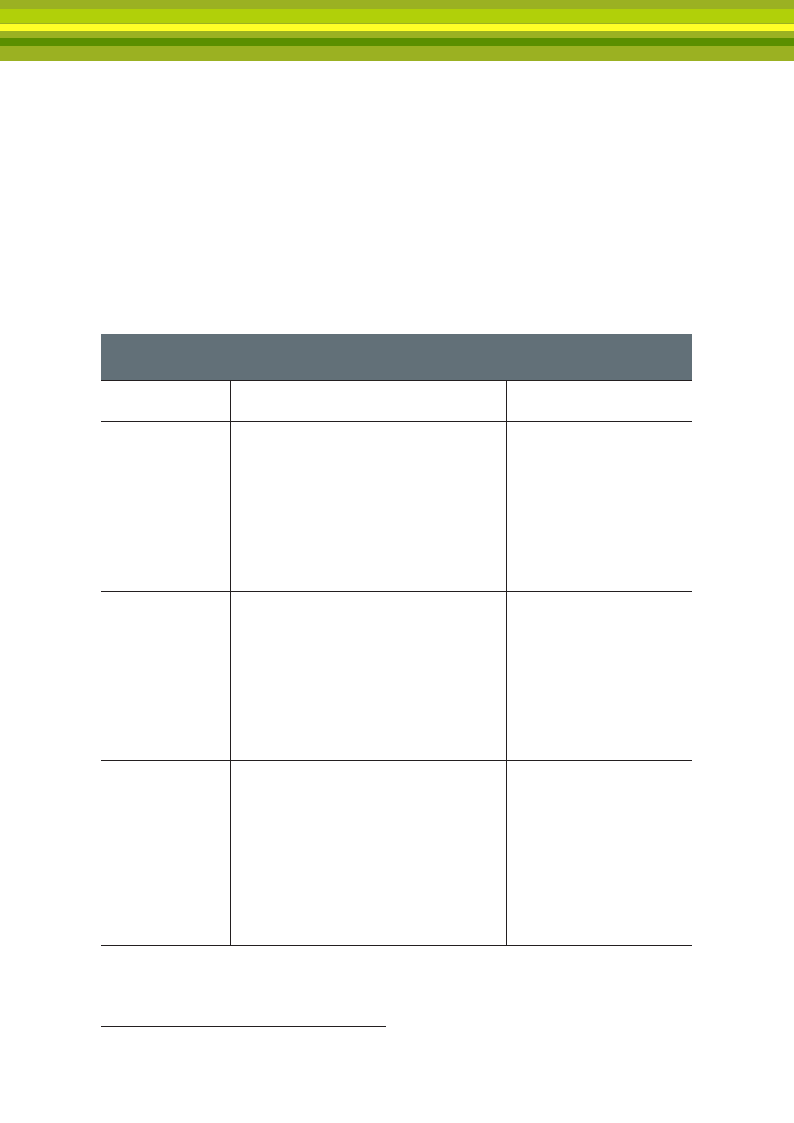
Agriculture and rural transformation is one of the key sectors/sub-sectors that
contributes to the economic development sector plan in the Second Growth and
Transformation Plan (GTP – II), and was developed as an outcome of national
development planning process in Ethiopia. The sector is represented by three
key line ministries: 1) Ministry of Agriculture and Natural Resources (MoANR), 2)
Ministry of Livestock and Fisheries, and 3) Ministry of Environment, Forest and
Climate Change. In addition, these ministries take the lead in regards to
implementation of climate resilient green economy strategy, which also includes disaster
risks management towards building resilient community in Ethiopia.
The roles and responsibilities in the national development planning and
implementation of national development plan6 and DRM are defined in Table 5.4.
Table 5.4 Lead Agencies Roles and Key Programs on DRM:
Agriculture and Rural Transformation*
Lead Agency/
Ministry
Roles & Responsibilities
Key Programs on DRM
(Example)
Ministry of
• Responsible for implementing specific Regional Pastoral Liveli-
Agriculture and
objectives related to agriculture and
hoods Resilience Project
Natural Resources
natural resources in the national
(RPLRP)
development plan (Table 5.5).
Accountable for monitoring, evaluating
and reporting of progress and
achievements of implementation.
• Lead institution with respect to
agriculture related hazards and
associated disasters.
Ministry of
Livestock and
Fisheries
• Responsible for implementing
the specific objectives related to
livestock and fisheries in the national
development plan (Table 5.5).
Accountable for monitoring, evaluating
and reporting of progress and
achievements of implementation.
• Lead institution with respect to
livestock and fisheries related hazards
and associated disasters.
Ministry of
• Responsible for implementing
National Adaptation Plan of
Environment,
the specific objectives related to
Action (NAPA)
Forest and Climate
environment, forest and climate
Change
change in the national development
plan (Table 5.5). Accountable for
monitoring, evaluating and reporting
of progress and achievements of
implementation.
• Lead institution with respect to forest,
bush fire, climate change, environment
pollution related hazards and disasters.
6 National development plan is also referred to as the Growth and Transformation Plan II.
74

Lead Agency/
Ministry
National Disaster
Risk Management
Commission
(NDRMC)
Roles & Responsibilities
Provides key information about:
• Hazards that damage crops, livestock,
and environmental problems and
issues
• Major disasters in identified in each
kebele, including period and year of
occurrence, root causes, and effects
• Livestock diseases
• Economic vulnerability, including status
of agriculture and crops grown
• Agriculture, livestock, and
environmental situations
Key Programs on DRM
(Example)
WDRP
Objectives
There are three key objectives of this sector: 1) bring about accelerated and sustained
growth of agriculture within the framework of the CRGE strategy that equitably benefits
people at all levels and that realizes structural transformation of the sector and the overall
economy; 2) bring about a significant shift in agricultural productivity, build productive
capacity and thereby enhance the contribution of the sector to the economy and stabilizing
the macro economy and; 3) enable women, youth, and other stakeholders to participate
in a structured and organized manner to contribute their part and benefit from the
development outcomes (National Planning Commission, 2016a). The specific objectives
and lead agencies are briefly described in Table 5.5.
Table 5.5 Objectives of Agriculture and Rural Transformation
Specific Objectives
Lead/Responsible Agency
• Ensure food security by increasing crop productivity
Ministry of Agriculture and
• Increase the productivity of crop
Natural Resources
• Increase the access of agriculture extension service
• Increase agricultural inputs utilization
• Expand agricultural mechanization
• Cooperative development and capacity building
• Increase horticultural investment
• Expand medium and large scale commercial farms and
increase their production and productivity
• Plant protection and quality improvement
• Promote climate-resilience agriculture through
implementation of best agricultural practices
• Establish rural land administration use and coverage
system
• Build capacity on rural land administration and utilization
• Sustain agricultural development by expanding watershed
management practices
• Improve water resource management and utilization
• Implement integrated soil fertility management system
• Strengthen disaster preparedness and response system
• Ensure food security and increase foreign exchange
earnings contribution of the sector by strengthening the
agricultural marketing system
75

Specific Objectives
• Enhance the contribution of livestock in food security
by sustainably increasing the sector’s production and
productivity
• Increase investment in livestock sector
• Genetically improve local livestock breeds
• Improve supply of livestock feed
• Improve biodiversity conservation and sustainable
utilization based on equitable benefit
Lead/Responsible Agency
Ministry of Livestock and
Fisheries
Ministry of Environment, Forest
and Climate Change
Implementation Strategy
The objectives will be implemented through an implementation strategy developed for
three specific areas: 1) crop productivity and production, 2) livestock productivity and
production, and 3) natural resources conservation and utilization. The details of each
strategy are briefly described in Table 5.6.
Table 5.6 Implementation Strategy for Agriculture and Rural
Transformation
Improved Crop Productiv- Improved Livestock Productiv- Natural Resources Consa-
ity and Production
ity and Production
vation and Utilization
• Strengthen agricultural
marketing and
cooperatives
• Improve agricultural
inputs supply and
utilization (fertilizer
supply, seed supply,
agro mechanization
inputs supply)
• Expand agricultural
extension system
• Enhance agricultural
investment
• Livestock genetic
improvement
• Improve livestock health
coverage
• Improve livestock feed
production
• Integrate implementation
of livestock value chain
efficiency
• Community- based
watershed development
activities should
continue
• Efficient use of rain
water (in moisture rich
areas)
• Water harvesting,
small scale irrigation
development, and soil
and water conservation
works (in moisture
stressed areas)
• Integrate livestock
development with
natural resource
development
• Build climate resilient
green economy
• Develop climate
change mitigation and
adaptation strategies
(capacity building
training)
Source: (National Planning Commission, 2016a)
76

Challenges
Two of the key challenges related to agriculture and rural transformation sector are
natural hazard risks and climate change. Although line ministries and DRM programs
(Table 5.4) deal with disaster and climate risks, in the recent years disasters have
brought barriers in fully achieving the objectives in the national development plan. For
example, the case study on New Drought Affected Southeastern Regions (2015/2016)
(see Box. 1.1) discusses drought impacts on agriculture and other related sectors.
Similarly, the impact of all hazards on agriculture and related sectors, including
rural development is clearly highlighted in the DesInventar – Disaster Information
Management System for Ethiopia. For example, Table 5.7 highlights some of the major
impacts of drought, floods, and plague in Ethiopia.
Table 5.7 Major Impacts of Disasters on Agriculture and Livestock in
Ethiopia
Event (1899 – 2013)
Elements Affected
Impacts (in number)
Drought
Damages in crops
265,527 hectare
Lost cattle
2,553,647
Flood
Damages in crops
537,113 hectare
Lost cattle
357,974
Plague
Damages in crops
5,305,816 hectare
Lost cattle
24
Source: (National Planning Commission, 2016a)
In addition to drought, flood, and plague events, there are other events that have
severely affected the crops and livestock production in Ethiopia, such as, biological,
conflicts, landslide, rain, storm events, etc., recorded by the disaster information
management system for Ethiopia. Key biological hazards in Ethiopia include crop pests,
animal diseases (endemic and epidemic), human epidemics/common diseases, and main
hazards perceived by community (DRMFSS, n.d.). Forest fires are commonly occurring
in areas where wood lands and forests are concentrated to pasture and farm land.
The other elements that may have affected Ethiopia from 1899 – 2013 were market
failure (i.e., domestic price volatility, international price volatility, exchange rate risk,
input price volatility for fertilizer and diesel, counterparty risk, etc.); and enabling
environment failure (e.g., political unrest and violent conflict, infrastructure disruption,
etc.). It is of upmost importance that elements related to agriculture and rural
transformation in Ethiopia are protected against the risk of natural hazards.
77

Steps For Mainstreaming DRM into Agriculture and Rural
Transformation
Mainstreaming DRM into agriculture and rural transformation will broadly use the six
steps presented in Table 5.8 (see Figure 5.1).
Table 5.8 Key Steps and Activities for Mainstreaming DRM into
Agriculture and Rural Transformation
Step
Potential Activities/Action/Role for
DRM Mainstreaming
Outcome(s)
Step 1: Planning
for Engagement
• Summary: In this initial stage, the
objective is to generate advocacy
for DRM mainstreaming with key
stakeholders who have key roles or
responsibilities in implementation
of national development plan for
agriculture and rural transformation
sector. Key stakeholders may
include:
- Ministry of Agriculture and
Natural Resources
- Ministry of Livestock
Development and Fisheries
- Ministry of Environment, Forest
and Climate Change
- Ministry of Federal and
Pastoralist Development Affairs
- Ethiopian Grain Trade Enterprise
- Regional Implementing Partners
- Wereda offices
- Development partners
- UN agencies
- National Metrological Agency
- National Planning Commission
- Ministry of Finance and
Economic Cooperation
- Central Statistics Agency
- Ethiopian Mapping Agency
The outcome of this step would lead to
agreement and establishing team for
conducting situation analysis.
Key stakeholders recognise
the need for mainstreaming
DRM into agriculture and
rural transformation
Guidance on conducting
situation analysis
Weather data
Suggestions:
• Conduct meetings to facilitate
partnership with the key
stakeholders
• Establish team for undertaking
situation analysis (Step 2) and
share findings and reports with
the key stakeholders
78

Step
Step 2: Situation
Analysis
Potential Activities/Action/Role for
DRM Mainstreaming
Summary: This step deals with
information collection, identification
of key risks related to agriculture,
and rural transformation. Risks faced
by agricultural stakeholders can be
classified primarily into three categories:
production, market, and enabling
environment risks. In addition, the
analysis can also include assessment of
key stakeholders affected by agricultural
risks, such as producers, commercial
sector stakeholders, and the public
sector.
Outcome(s)
Agriculture and rural
transformation briefing
notes
Problem statement
Identification of key problems (hazards
context, risk and vulnerability context,
institutional arrangements and
policies, stakeholders’ analysis, existing
programs/projects, donor analysis,
etc.) occurs at this stage. This may
include assessing the capacity of local
departments or institutions under
the MoANR and MoLF. Review and
performance of food security programs
and other development program
performance and identifying the gaps.
Review of development policies, such as
rural development policy and strategies,
development and poverty in Ethiopia,
etc.
Suggestions:
• Use wereda risk profile
information system as baseline
to understand issues related to
agriculture and rural
development
• Conduct vulnerability and risk
assessment for agriculture
sector and evaluate the impact
of natural hazards to the
agriculture, livelihood, and rural
development
• Undertake detailed risk
assessment on crop productivity,
livestock productivity, and
natural resources; include
climate change impact on
agriculture risk analyses related
studies, reports, etc.
79

Step
Step 3:
Mainstreaming
Action
Development
Process
Potential Activities/Action/Role for
DRM Mainstreaming
• Review flagship programs and
document best practices.
Flagship programs, such as,
PSNP, agriculture growth
programs, sustainable land
management programs
• Use desk-based review,
stakeholder engagement,
preliminary root-cause analysis
for information collection
• Use sector briefing notes,
preliminary root-cause analysis,
DRM frameworks (e.g., the
regional framework),
prioritization exercise for the
identification of the key
problems related to agriculture
and rural development sector
Summary: Step 3 deals with the
problem validation process, problem
prioritization process, problem-
solution tree analysis, and action matrix
development. It prioritizes actions in line
with GTP-II actions.
Outcome(s)
Problem tree
Root-causes
Mainstreaming DRM action
matrix for agriculture and
rural transformation sectors
Suggestions:
• Use line ministries’ guidelines
for mainstreaming action
development process
• Use GTP-II methodology for
problem validation process,
problem prioritization process,
problem-solution tree analysis,
action matrix development,
prioritizing actions
• Use prioritization process for the
validation of issues and
problems
• Use working group sessions
with stakeholders using a range
of tools (problem-solution tree
analysis, guiding questions) to
identify root causes and effects
relating to key problems
• Identify root causes and
solutions
• Follow the assessment of risks
and analysis of stakeholder
vulnerability to propose risk
management strategies
80

Step
Step 4: Costing
of Actions and
Development of
Implementation
Plan
Potential Activities/Action/Role for
DRM Mainstreaming
Outcome(s)
• Develop appropriate DRM
strategy and program to address
specific vulnerability level within
the context of the agriculture
and rural development
• Identify solutions by classifying
possible risk management
strategies into three categories:
mitigation, risk transfer, and
coping (See Case Study 1; Box
5.1)
Summary: Stage 4 deals with identifying
and developing a financial strategy,
implementation strategy, communication
strategy, and monitoring and evaluation
strategy for mainstreaming actions for
agriculture and rural transformation.
Disaster resilient initiatives
are prioritizedd in the
agriculture and rural
transformation plan
Suggestions:
• Determine cost of
mainstreaming actions, including
incremental cost (gaps) and
developing a financial strategy
along with actions/activities of
implementing line ministries.
• Create institutional
arrangements such as the
creation of an implementation
unit along with the
implementation unit for
each activity of line ministries of
the agriculture and rural
transformation sectors.
• Develop communication
strategies for mainstreaming
actions under the line
ministries of the agricultural and
rural transformation actions
activities under GTP – II.
• Develop monitoring and
evaluation strategies for
mainstreaming actions under
the lead ministries of the
agriculture and rural
transformation actions/activities
under the GTP – II.
• Appoint dedicated staff or DRM
representative at implementing
lead ministries.
81

Step
Step 5: National
Approval Process
Step 6:
Implementation,
Monitoring and
Evaluation
Potential Activities/Action/Role for
DRM Mainstreaming
Summary: This step deals with
obtaining political support for risk
sensitive development of agriculture and
rural transformation plans.
Outcome(s)
The agriculture and rural
transformation plan
promotes risk sensitive
development
Suggestions:
• Provide evidence of the costs of
such short-term decisions in
agriculture and rural
transformation sector over the
short, medium and long-term.
• Promote legislation change to
incorporative climate,
environment and disaster risk.
Suitable legislation often
promotes incentives for
agriculture and rural
transformation sector. For
example, legislation is required
for the food production, climate
change adaptation and
mitigation.
• Set appropriate monitoring
systems, performance, and
enabling strategies at the
planning, execution, and
evaluation stages of agriculture
and transformation plan.
Summary: This step deals with
implementation and tracking progress
towards achieving the activities as per
the action plan developed in Step 4.
Suggestions:
• Monitoring and evaluation of
DRM mainstreaming actions
should be carried out within
the GTP- II monitoring and
evaluation strategies.
• Technical guidance will be
provided for compiling and
analyzing the collected
information and data. Currently,
a biennial report is submitted
using the planned Sendai
framework for monitoring and
evaluation.
• The gaps, challenges or issues
identified in this step will be
used to adjust for continual
improvements in the Plan
implementation and for DRM
efficacy and cost effectiveness. In
addition, issues or gaps not
adjusted are taken up in Step 1
for discussion.
Plan implementation is
adjusted for continual
improvements in
DRM efficacy and cost
effectiveness
82

Case study 1:
Accelerated Livestock Marketing to Boost Household Income of
Pastoralists During Drought: Commercial Livestock Destocking as
a Drought Response
Source: Unisdr (2009)
Summary
Recurrent droughts have had a major impact on the vulnerability of Ethiopian pastoralists.
Drought typically results in large livestock losses, reduced market prices, and decreased
household food security. A severe drought hit Ethiopia in 2006, during the first six
months of which cattle prices decreased from 138 to 50 US dollars per head. The
cattle prices were expected to continue falling as their conditions worsened. Many
cattle were also likely to die from lack of pasture and water. Save the Children/US, an
international NGO, rapidly launched an accelerated livestock marketing initiative in the
southern district of Moyale, near the Ethiopia-Kenya border. The initiative, also known
as commercial destocking, enabled pastoralists to receive cash in exchange for some
of their animals, many of which were likely to die as drought conditions worsened.
The pastoralists then used this money to purchase food for their families and hay and
feed for their remaining livestock. An estimated 20,000 cattle valued at 1.01 million US
dollars were sold. Some 5,400 households – about 30,000 people - participated in
the initiative. Each household received, on average, 184 US dollars from the sale of cattle.
What is presented?: Pastoralist Livelihoods Initiative (PLI)
Program: PLI, a 2-year program aimed to lessen the impact of drought, funded by
USAID
Location: Southern District of Moyale, near Ethiopia-Kenya Boarder
Goal: To mitigate the impact of drought and other shocks for pastoralists in Ethiopia
through improved livestock-based relief and development
Methodology - Develop and implement the destocking initiative to mitigate
drought impact on livestock
Save the Children/US worked alongside the Ethiopian Ministry of Agriculture
and Rural Development and livestock traders to develop and implement the
destocking initiative. To raise awareness about the initiative among livestock traders,
the Ministry’s Marketing Department held a meeting for traders involved in supplying
livestock to local and export markets. The meeting was held in the capital, Addis
Ababa, and was attended by over 40 traders. The Marketing Department and Save
the Children/US also organized a familiarization trip so the traders could visit
drought-affected areas.
83

Result: Only two traders decided to purchase the cattle. After purchasing over
6,000 cattle, each trader became eligible for an interest-free loan of 25,000 US
dollars to help bridge a short-term gap in capital flow during the drought. Between
5 -25 February, the traders purchased 6,292 male cattle. Many of the purchased
cattle were highly emaciated. The two traders also influenced other commercial
livestock traders to buy animals from the area. An additional 3,778 cattle were sold as
a result, bringing total cattle purchases in February and March 2006 to 10,915. In total,
some 20,000 livestock were removed from Moyale District during the 2006 drought.
What was achieved? – Impact and Results
• Destocking provided more than 50% of household income during the drought. This
income was used in rational ways, mainly to meet immediate household needs and
to protect assets and services. This highlights the resulting support given to
local markets, which is required for post-drought recovery.
• Destocking was considered to be the most useful intervention by participants.
• A benefit-cost estimation comparing the cash benefits to pastoral households to the
costs incurred by the implementing agency showed a benefit-cost ratio of 41:1.
• All of the people who participated in the destocking initiative were able to buy their
own food with the money obtained from destocking. They no longer had to wait for
food aid, as they did during previous droughts.
• Participants saw clear advantages of destocking over food aid. They explained that
money from destocking could be used to buy other things besides food, such as
medicines and clothes.
What are the challenges?
• Poor infrastructure in pastoralist areas hinders market-led development
• Frequent customs and taxation points exist along the roads between drought-
affected areas and holding areas for the animals. These fees added extra costs to
the initiative.
• Finally, the limited number of holding grounds proved to be a constraint. In some
cases, livestock in Moyale District become too thin and unfit for transport.
Is this case promoting mainstreaming DRR or providing opportunity to
mainstream DRR?
• Awareness raising among the livestock traders about the drought impacts
on livestock by the Marketing Department of the Ministry of Agriculture and
Rural Development was a crucial step taken to change the mind-set of the livestock
traders and allow them to carry out destocking in the drought affected areas.
For mainstreaming DRR, this step should be taken earlier before drought period so
that traders take proactive steps to prevent situation where some livestock become
too thin and unfit for transport.
84

• An interest-free loan of 25,000 US dollars to livestock traders: Although
out of 40 traders, only two traders decided to purchase the cattle, such incentives
can be effective if they introduced at the right time and place. The traders were
able to purchase nearly 10,915 cattle. For mainstreaming DRR, this kind incentive
scheme should be promoted in drought prone areas before the start of the drought
period.
• Prevented the cattle loss and reduced the negative impact on the GTP
planned targets and progress for livestock sector: There was no data or
estimation or forecasting on likely cattle loss with or without destocking. Nevertheless,
commercial destocking appeared to be an effective practice because it provided
pastoralists with cash from animals that were likely to die if left in the herd. For
mainstreaming DRR, it is important that proper estimation of likely cattle loss is
carried in drought prone areas under different drought scenarios so that
commercial destocking can be planned at the right time and right place.
Way forward: Operational steps for mainstreaming DRR into the agricultural sector:
• Planning destocking in early phases of drought: Destocking should be
considered at the earliest possible time, even before the official declaration of a
drought. Destocking in early phases can provides pastorals twice the amount if
destocking take place late. The ministry can plan destocking in early phases of
drought by using the wereda risk profile information and access key information
about the livestock situation, including status of livestock disease, veterinary
facility, livestock diversity, livestock ownership and changes, and pasture and
water availability.
• Build or raise comprehensive understanding about the livestock drought
risk among key stakeholders: Comprehensive understanding about the livestock
natural hazard risk should be properly shared for the planning and i
mplementation commercial destocking early drought phase among the private
livestock traders as well as pastoral traders’ associations. The Ministry of Livestock
and Fishery Development should make use of wereda risk profile information for
marketing commercial destocking among traders where it is mostly needed.
• Develop incentives and schemes for livestock traders as well as pastoral
community for promoting destocking in selected areas: The schemes and
incentives should be designed in the early phases of drought. Therefore, a certain
budget amount should be allocated for developing incentives and schemes for
livestock traders as well as for pastoral community.
• Infrastructure development for destocking: Without proper infrastructure
support, destocking cannot take place, for instance, the appalling conditions of
the roads in some districts reduced the coverage of destocking after 2006 drought.
Line sectors, such as the road department, should carefully understand the needs
for roads from hazard risk, vulnerability, and exposure before selection and
implementation of road development projects.
• Promote the schemes for restocking of livestock in drought recovery:
The ministry should also provide incentives that help pastoral community to restock
livestock during disaster recovery as well as provide supply of improved livestock feed.
85

• Increase the supply of improved livestock feed in the severely drought
prone areas: As mentioned earlier, the wereda risk profile provides key information
about the situation of livestock feed in various wereda. This information can help
the ministry in planning the supply of improved livestock feed in areas that requires
urgent attention.
Box 5.1 Natural Resource Management (NRM): Good Practice Checklist
• Integrate NRM initiatives with other risk management components, such as early
warning systems, awareness-raising, and, in some cases, with physical infrastructural
interventions through large or small-scale mitigation works;
• Raise awareness in rural communities about the importance of natural resources;
their protection and conservation needs, and their role as managers.
• Support government authorities at different levels to produce and overlay maps
of known hazards and the projected effects on climate change on large and small-
scale maps of natural resources, to indicate current and potential exposure, and
support communities to do the same, at the lowest possible scale.
• Use participatory methods with at-risk populations to identify how current
and traditional practices in the use of natural resources affect exposure and
vulnerability to hazards and the projected effects of climate change; use the same
methods to identify existing practices, knowledge and skills within at-risk populations
for protecting natural resources.
• Undertake a power analysis to understand different stakeholder interests
with respect to key natural resources, particularly in the case of major development/
infrastructure projects that will exploit or affect them and communities that depend
on them.
• Strengthen/support the establishment of NRM committees at local levels to
monitor and analyze local issues and to represent local interests at other levels.
• Undertake vulnerability monitoring as an early warning mechanism for slow
onset disasters.
• Use participatory and culturally sensitive approaches to capture the knowledge
of local and indigenous people, particularly older generations, of how natural
resources have changed over time and how people have adapted to those changes.
• Provide training and material inputs to at-risk populations to contribute
to building a resilient natural environment through protecting, maintaining,
restoring and enhancing natural resources (e.g., mangroves, water pans, fragile soil
systems, river banks).
• Provide legal and technical information to populations likely to be affected by
projects that use or may have an effect on key natural resources and support them
in accessing information on how such projects may affect their vulnerability and
exposure to hazards and effects of climate change.
• Contribute to strengthening institutional linkages between government
departments for NRM, climate change and disaster management by engaging
representatives from each in risk assessment processes, national platforms and
forums for sharing good practices.
• Harness external technical expertise to conduct in-depth studies of particular
natural resources, and to present potential resilience-building options.
• Foster innovation by providing communities and organizations that have
demonstrated effective NRM with access to technical and scientific advice on
adaptation, and closely monitor and document the results.
• Identify indicators of sustainability in natural resources and establish monitoring
systems to track changes.
Source: (Government of Ethiopia, 2013)
86

Guidance Note 2:
Environtment and Climate
Resilient Green Economy Sector

Environment and climate resilient green economy is one of the key sectors/sub-
sectors that addresses cross-cutting issues during the Second Growth and
Transformation Plan (GTP – II), and was developed as an outcome of national
development planning process in Ethiopia. The technical management part of the
sector is represented by the Ministry of Environment, Forestry and Climate Change,
while the financial management falls under MoFEC. The roles and responsibilities in the
national development planning and implementation of national development plan8 and
DRM are defined in Table 5.9.
Table 5.9 Lead Agencies Roles and Key Programs on DRM: Environment
and Climate Resilient Green Economy*
Lead Agency/
Ministry
Roles & Responsibilities
Key Programs on DRM
(Example)
Ministry of
Environment,
Forestry and
Climate Change
• Responsible for implementing
National Adaptation
specific objectives related to
Programme of Action
environment and climate
(NAPA)/MEFCC
resilient green economy in the
national development plan. The
ministry is also accountable for
monitoring, evaluating and
reporting of progress and
achievements of implementation
• Lead institution with respect to
forest development and bush
forest fire management as well as
climate change mitigation and
adaptation as well as environmental
pollution related hazards and
associated disasters
• Environmental Situation: Rainfall and
temperature
• Environmental Situation:
Deforestation
• Environmental Situation: Reasons
for environmental changes
National Disaster
Risk Management
Commission
(NDRMC)
Provides key information about:
• Environmental Situation: Major
environmental problems by kebele
• Environmental Situation: Natural
resources availability
• Environmental Situation: Land-use
other than crop production
• Environmental Situation: General
land quality
• Environmental Situation: Changes in
landscape
• Environmental Situation: Soil erosion
• Loss and damage associated with
climate change
• Budgetary and logistic support,
including technical staff
WDRP/ MEFCC
MoFEC
Provides approval and disbursement of
budget allocation
* Information presented in above table is illustrative and not exhaustive. It is subjected to government structure arrangement
in the country.
88

Objectives
The main objectives of the sector for the national development plan are, 1) ensuring
environmental safety in the course of rapid and sustainable economic growth (vision
to become a lower middle-income country by 2025); 2) ensuring CRGE strategy is
implemented in all sectors to increase socioeconomic and ecological benefits of forests
through improved forestry development; and 3) conservation and utilization (National
Planning Commission, 2016a). The specific objectives are described in Table 5.10.
Table 5.10 Lead Agencies Roles and Key Programs on DRM: Environment
and Climate Resilient Green Economy*
Specific Objectives
Lead/Responsible Agency
• Strengthen climate resilient green economy
Ministry of Environment,
• Establish a system where environmental safety rights, Forestry and Climate Change
forest development, protection, and use rights are
respected and implemented
• Enable citizens to live in clean and healthy
environments by cleaning and greening cities
• Increase forest coverage through identification,
demarcation, registration, and protection of forest
lands
• Increase ecological benefits of forest through
sustainable forest protection and conservation
For strengthening the DRM, the ministry developed NAPA to
enable Ethiopia to address urgent and immediate adaptation
needs caused by climate change and extreme weather events.
The specific objectives are:
• Identify a list of priority activities
• Formulate priority adaptation options
• Build capacity
• Raise public awareness on the urgency to adapt to the
adverse effects of extreme weather events
Source: (National Planning Commission 2016b; Ministry of Water Resources and Meteorological Agency, 2007)
Implementation Strategy
To achieve the above objectives and annual targets, the implementation strategies for
environment and climate resilient green economy consist of three key pillars as shown
in the Table 5.11. It is equally important that these strategies also give adequate attention
to natural hazards, especially those regions who have experienced severe loss and
damages to the physical environment.
89

Table 5.11 Implementation Strategy of Environment and Climate
Resilient Green Economy
Implementation Capacity Building Climate Resilient
Building Program
Green Economy
Forestry Development
• Strengthen capacity of • Enable each sector to
• Strengthen forestry
relevant institutions in
implement Green House Gas
development,
planning, implementing,
(GHG) emission reduction
conservation, and
monitoring, and
programs
utilisation at all levels
evaluation of the sector • Support the preparation of • Develop effective
• Establish environment
action plans and monitoring
systems and strong
and forestry structures
activities by including
collaboration with
across all regions,
sufficient budget and
institutions that provide
organizations, and
capacity building assistance
education, training,
administrative levels
to each sector, mainly, in the
and research with a
• Support to effectively
context of attaining emission
particular focus on
implement CRGE down
reduction targets
executive agencies
to the grassroots
• Formulate and implement
• Promote and
level for all sectors or
effective strategies for
disseminate knowledge
agencies
participation, plan integration,
and technology
• Identify regional capacity
harmonization, and
generated from need-
gaps and technical
development to mitigate
based research through
limitations through
climate change impacts
demonstration and
needs assessment
• Conduct follow-up activities
extension
studies
on 20 nationally agreed
• Prepare participatory
climate change adaptation
and decentralised
tasks
systems of
environmental and
forestry development,
conservation, utilization
and safety measures
• Implement awareness
raising activities on
forestry policy, strategy,
and laws for managers,
experts, and community
members at all levels
• Conduct an
Environmental
and Social Impact
Assessment (ESIA)
on new and on-going
projects, and ensure
strict monitoring and
evaluation activities are
carried out to determine
whether projects are
being implemented
in accordance with
environmental laws
90

20 Adaptation Options/Strategies Under the Climate Change National
Adaptation Programme of Action in Ethiopia
• Community-based development and commercialization of non-timber forest products (gum
Arabic, myrrh and frank incense);
• Community-based rehabilitation of degraded ecosystem in selected parts of Ethiopia for
carbon sequestration and trading;
• Propagation and commercial scale cultivation of wild essential oil crops;
• Establishment of a center for propagation and commercialization of traditional herbal
medicinal plants;
• Establishment of acacia woodland nature reserve in the Ethiopian Rift Valley System;
• Range shift cultivation of selected cash crops at drought-prone areas;
• Establishment of national research and development center for rio-conventions;
• Development of an incentive scheme for farmers (hill-farming communities) to reforest
degraded hill areas in the northern parts of Ethiopia;
• Participatory approach to rehabilitate degraded hills/ecosystem in northern Ethiopia;
• Institutional reinforcement for biodiversity conservation;
• Establishment of a National Environment Education Program;
• Reforestation for fuel in the highlands of Ethiopia;
• Regional capacity building for monitoring and inventorying of biodiversity;
• Establishment of potato-centered small-sized cottages;
• Reclamation of bush encroached rangelands;
• Promotion of legume-based agro-forestry systems and home-garden agriculture;
• Development and rehabilitating existing watering sites in pastoral areas;
• Aquaculture development for efficient harvest of commercial spirulina species in the lakes of
the Ethiopian Rift Valley System; and
• Reorganization of drought affected communities
Challenges
Throughout Ethiopia the environmental sector is vulnerable to climate and disaster
risks. Both droughts and floods have caused extensive losses and damage to the
environment; however, the losses and damage from droughts are enormous. Droughts
can bring various environmental impacts many of which can already be observed in
Ethiopia. Some of the general impacts are briefly described in Table 5.12.
91
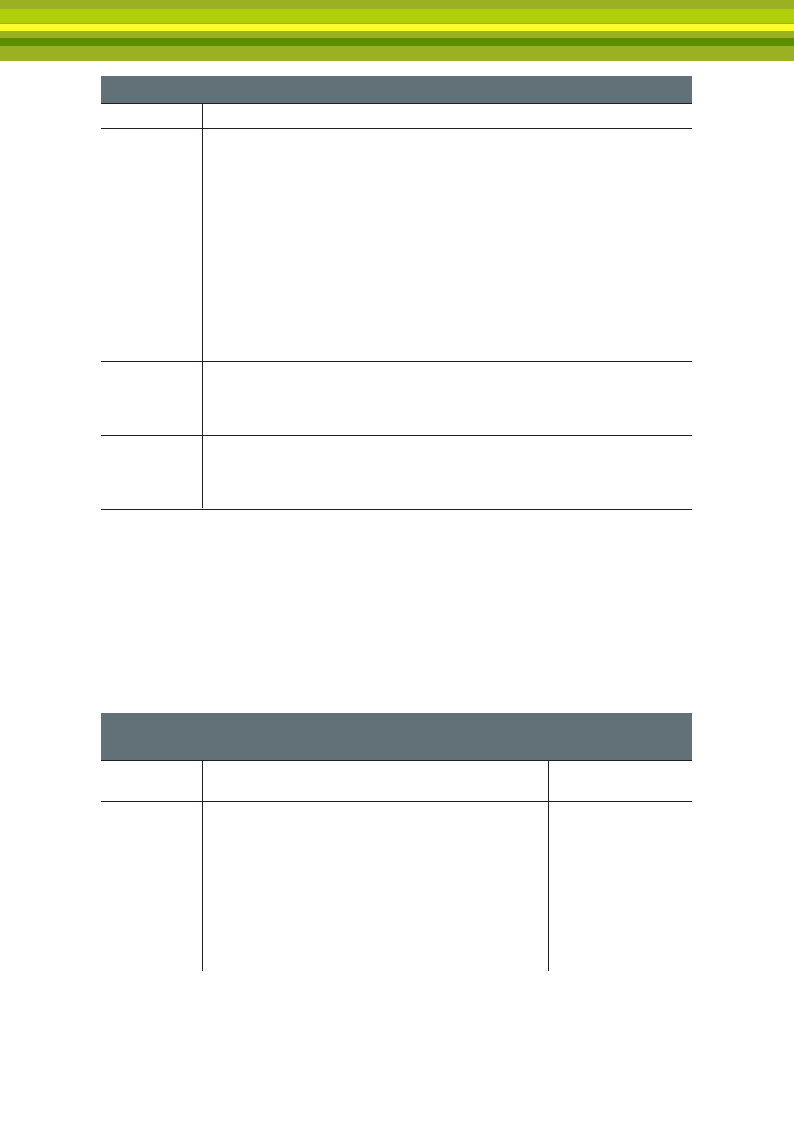
Table 5.12 Impacts of Droughts and Floods on the Environment
Hazard
Environmental Impact
Drought
• Damages ecological systems
• Cumulative stress on wetlands, wildlife, forests, ground water, and soil
• Changes in the quantity and quality of water available in the hydrologic
system
• Damages both plant and animal species by depriving them of food and
water, increasing their susceptibility to disease, and increasing their
vulnerability to predation
• Results in a loss of biodiversity, and often increases erosion of dried soils
when rain eventually comes
• Degrades water quality, shifts salt concentration, pH levels and dissolved
oxygen, while increasing water temperatures
• Diminishes air quality due to increased dust and pollutants
• Leads to more wildfires, while adversely changing salinity levels in coastal
estuaries and reducing the flushing of pollutants
Flood
• Positive and negative effects on river-floodplain ecosystems
• During great floods, floodplains do not merely store water, but become
part of the flowing river itself, conveying water slowly downstream through
the forests and marshes
Hazardous
waste
• Result in agro chemical waste such as herbicides, insecticides, fungicides,
pesticides, and fertilizers
• Industrial and municipal waste are released into the soil, water, and
atmosphere
Mainstreaming DRM into Environment and Climate Resilient
Green Economy
The following section discusses steps and activities for incorporating DRM into environment
and climate resilient green economy (Table 5.13). Based on the challenges and issues
discussed in the previous section, this section proposes suggestions on mainstreaming
DRM.
Table 5.13 Key Steps and Activities for Mainstreaming DRM into
Environment and Climate Resilient Economy
Step
Potential Activities/Action/Role for DRM Main-
streaming
Outcome
Step 1:
Planning for
Engagement
Summary: In this initial stage, the objective is to
generate advocacy for DRM mainstreaming with the
Ministry of Environment, Forestry and Climate Change,
National Planning Commission, Ministry of Finance
and Economic Cooperation, the Sector Development
Planning Office responsible for environment and
climate resilient green economy, and the sectoral task
force on DRM mainstreaming. The outcome of this step
would lead to an agreement and the establishment of a
team for conducting a situation analysis.
Key stakeholders
recognise the need
for mainstreaming
DRM into
environment and
climate resilient
green economy
92

Step
Step 2:
Situation
Analysis
Potential Activities/Action/Role for DRM Main-
streaming
Outcome
Suggestions:
• Conduct meetings to facilitate partnerships with
the key officials from the Ministry of Environment,
Forestry and Climate Change, National Planning
Commission, Ministry of Finance and Economic
Cooperation, Sector Development Planning Office
responsible for environment and climate resilient
green economy, and sectoral task force, and
NDRMC for mainstreaming DRM into environment
and climate resilient green economy
• Establish team for undertaking situation analysis
(Step 2) and share findings and reports with key
stakeholders
Guidance on
conducting
situation analysis of
environment and
climate resilient
green economy
Summary: This step deals with the collection of
information, and the identification of key risks related
to environment and climate resilient green economy.
Suggestions:
• Assess disaster risks and projected effects of
climate change in the program location and the
wider geographical context
• Use hydro metrological data related to rainfall,
temperature, etc. for the situation analysis from
the National Metrological Agency
• Use historical disaster records, combined with the
knowledge of at-risk populations to understand
the interaction between disaster risks and natural
resources
• Use WDRP to understand the environmental
problem by kabele
• Use WDRP to understand the situation of
deforestation in wereda prone to natural hazard
risks
• Use WDRP to understand the situation of natural
resources availability (natural resources available
and changes in wereda prone to natural hazard
risks)
• Use WDRP to understand the situation of rainfall
and temperature (observed changes on rainfall and
temperature in wereda prone to natural hazard
risks)
• Use WDRP to understand the situation of reasons
for environmental changes in wereda prone to
natural hazard risks
• Use WDRP to understand the situation of soil
erosion (observed changes on levels of soil erosion
in wereda prone to natural hazard risks)
Sector Briefing notes
on environment and
climate Resilient
green economy
Problem statement
93

Step
Step 3:
Main-
streaming
Action
Develop-
ment
Process
Potential Activities/Action/Role for DRM Main-
streaming
Outcome
• Undertake study on impact of land degradation,
expansion of steep slopes, and inadequate land
cover during erosive periods on drought and flood
prone areas in Ethiopia
• Undertake study on adoption of soil conservation
measure in Ethiopia, including current issues,
challenges, needs, and capacity in the context of
drought and flood risk
• Undertake studies on assessment of capacity of
relevant institutions in planning, implementation,
monitoring, and evaluation of the sector on DRM
mainstreaming
• Undertake study on the best practices in climate
change adaptation practices in the context of
climate and disaster risks in Ethiopia
• Undertake study on environmental impact
assessment (EIA) in Ethiopia, including the gaps
and challenges in the context of climate and
disaster risk
• Undertake study on the current practices on
forest development, conservation techniques, and
existing system of education and training. What are
the gaps and challenges in the context of climate
and disaster risks?
• Review the performance of environmental policy,
EIA, in the context of climate and disaster risks in
Ethiopia
• Review the performance of other relevant policies
in the context of climate and disaster risks (e.g.,
land tenure policies, land forest use regulations,
infrastructure development, monitory and credit
policy, etc.)
Summary: Step 3 deals with the problem validation
process, problem prioritization process, problem-
solution tree analysis, and action matrix development.
It prioritizes actions in line with GTP-II actions.
Suggestions:
• Based on situation analysis and sector briefing
notes, identify good practices/actions in natural
resource management to confront some of the
new challenges posed by disasters and climate
change
• Based on situation analysis and sector briefing
notes, adopt adaptive management approaches.
Climate and disaster impacts and NAPA measures
should be monitored carefully so that management
actions can be appropriately adjusted in response
to changing conditions
• Refer and review disaster risk mitigation and
adaptation plans that are prepared by the wereda
sectors (NDRMC)
• Conduct trainings to educate and build knowledge
on mainstreaming DRR into EIA (see Box 5.2)
• Conduct trainings and develop capacity on
forest development and conservation technics
that confront some of the challenges posed by
disasters and climate change
Problem tree(s)
Root-causes
Mainstreaming DRM
action matrix for
environment and
climate resilient
green economy
94

Step
Step 4:
Costing
of Actions
and
Develop-
ment
of
Imple-
mentati
on Plan
Step 5:
Approval
Process
Potential Activities/Action/Role for DRM Main-
streaming
Summary: Stage 4 deals with identifying and
developing a financial strategy, implementation
strategy, communication strategy, and monitoring
and evaluation strategy for mainstreaming actions for
environment and climate resilient green economy.
Suggestions:
• Conduct cost analysis for mainstreaming actions,
including incremental cost (gaps) and developing
a financial strategy along with environment and
climate resilient green economy actions/activities
• Create institutional arrangements such as the
creation of an implementation unit along with the
implementation unit for environment and climate
resilient green economy activities
• Develop communication strategies for
mainstreaming actions under the environment and
climate resilient green economy actions/activities
under GTP - II
• Develop monitoring and evaluation strategies for
mainstreaming actions under the environment and
climate resilient green economy actions/activities
under the GTP – II
Summary: This step deals with obtaining political
support for risk sensitive development of environment
and climate resilient green economy plan
Suggestions:
• Provide convincing evidence of the costs of short-
term decisions in the environment and climate
resilient green economy sector over the short,
medium and long-term
• Promote legislation change to incorporative
climate and disaster risk. Suitable legislation
often promotes incentives for environment and
climate resilient green economy. For example,
EIA legislation is required for the development or
construction of infrastructure or production units/
plants
• Set appropriate monitoring systems and enabling
strategies at the planning, execution, and
evaluation stages of environment and climate
resilient green economy plan
Outcome
Disaster resilient
initiatives are
prioritized in the
environment and
climate resilient
green economy plan
The environment
and climate resilient
green economy
plan promotes/
strengthens
risk sensitive
development
95

Step
Potential Activities/Action/Role for DRM Main-
streaming
Step 6:
Implementa-
tion, Moni-
toring and
Evaluation
Summary: This step deals with implementation and
tracking progress towards achieving the activities as
per the action plan developed in Step 4.
Suggestions:
• Monitoring and evaluation of DRM mainstreaming
actions should be carried out within the GTP- II
monitoring and evaluation strategies.
• Technical guidance will be provided for compiling
and analyzing the collected information and data.
Currently, a biennial report is submitted using the
planned Sendai framework for monitoring and
evaluation.
• The gaps, challenges or issues identified in
this step will be used to adjust for continual
improvements in the plan implementation and for
DRM efficacy and cost effectiveness. In addition,
issues or gaps not adjusted are taken up in Step 1
for discussion.
Outcome
Plan implementation
is adjusted
for continual
improvements in
DRM efficacy and
cost effectiveness
Box 5.2 EMB Integrates Disaster Risk Reduction and Climate Change Adaptation
in the Environmental Impact Assessment (EIA) Requirement in the
Philippine EIS System
The Philippine Environmental Impact Statement System (PEISS) is a planning tool for
incorporating environmental management concerns into proposed development
projects, and has been specifically identified as an entry point for considering climate
change risks and formulating climate change adaptation in planning development
initiatives at the project level. Likewise, in the light of the current disaster events,
there has been a realization of the importance of considering disaster risks in project
planning and development and the PEISS has been identified as one of the government
processes where these concerns should be tackled. Hence, EMB Memorandum Circular
2011-005 on Integrating DRR/CCA concerns in the PEISS was issued in November 2011.
The Memorandum Circular is intended to enhance the PEISS into a risk-based planning
and management tool, in addition to it being a tool for incorporating environmental
management concerns in project planning and implementation. Since then, a number
of projects have used the Technical Guidelines for Integrating DRR/CCA concerns in the
EIA. With assistance from the Asian Disaster Preparedness Center (ADPC), implementation
of EMB MC 2011-005 is currently being assessed in order to enhance its effectiveness.
Source: (Environment Management Bureau, n.d.)
96

Guidance Note 3:
Health Sector Development

Health sector development is one of the key sectors/sub-sectors that contributes
to human development and technology capacity building during the Second
Growth and Transformation Plan (GTP – II), and was developed as an outcome of
national development planning process in Ethiopia. It is represented by the Ministry of
Health. The roles and responsibilities in the national development planning and
implementation of national development plan8 and DRM are defined in Table 5.14
Table 5.14 Lead Agencies Roles and Key Programs on DRM:
Heath Sector Development*
Lead
Agency/
Ministry
Roles & Responsibilities
Key Institutions/
Programs for
Accessing Data
Relevant to DRM
Mainstreaming
Ministry of • Lead agency to implement national nutrition policy Key stakeholders
Health
which includes, among others:
recognise the need
National
• Responsibility for implementing specific objectives for mainstreaming
Disaster
related to health sector development in the
DRM into
Risk Man-
national development plan
environment and
agement
• Accountability for monitoring, evaluating, and
climate resilient
Commission
reporting of progress and achievements of
green economy
(NDRMC)
implementation
• Lead institution with respect to food shortage
induced malnutrition affecting children and
mothers and also other human epidemics
associated with disasters
Provides key information about:
• Household access to drinking water - Households’
methods of treating drinking water, number of
times households fetch water per week, time taken
per day to fetch water for households
• Household access to health facilities - Where do
patients go for health care?
• Hazards: Health problems by kebele - Health
problems and changes over the past decade
• Household health status - Households’ health
condition and major health problems
• Household access to sanitation - Percentage of
households with access to types of toilet facilities
• Household access to drinking water - Sources of
drinking water for households
WDRP
MoWIE
* Information presented in above table is illustrative and not exhaustive. It is subjected to government structure arrangement
in the country.
98

Objective
The objective of the health sector is to improve the health outcomes of citizens through
provision of equitable, accessible, and quality health services, and enhancing awareness of
the public so that they protect themselves from various health hazards (National Planning
Commission, 2016a).
Implementation Strategy
•
•
•
•
•
Reduce the turnover of health professionals by providing adequate
training for health professionals
Support private investors to establish highly specialized hospitals
Strengthen or improve government investment policy in order to increase the
participation of private investors in pharmaceuticals, production of medical
equipment, and other areas
Transform health service delivery through enhanced governance, development
of the sector’s leadership capacity, strengthened survey and surveillance
systems, revolutionized information management system through utilization to
a systematic information management approach
Health sector transformation through wereda transformation (National Planning
Commission, 2016b)
Major Hazards and its Analysis
The health sector is prone to the negative effects of droughts and floods, which have
in some cases been catastrophic. Since 1974, the occurrence of droughts have
become more frequent, more severe, and have caused tremendous loss of human lives
and property damage (Tadesse and Ardalan, 2014). The most severe events were in
the years 1974, 1983, 1987, 1989, 2003, 2005, 2008, and 2009 (Tadesse and Ardalan,
2014). Floods are the second natural disaster in Ethiopia. They have been occurring
more frequently and have affected the country almost every year between 1993 and
2013 (Tadesse and Ardalan, 2014). Epidemics can also be considered disastrous,
causing mortality and morbidity throughout the country. Major examples include
measles, dysentery, meningococcal meningitis, anthrax, influenza A and B, relapsing
fever and yellow fever as reported by the government (Tadesse and Ardalan,
2014). In addition, diarrhea and malaria are the two main diseases that affect flood
victims. In several instances, the problem of diarrhea was aggravated in a temporary
resettlement camp because of overcrowding and inadequate water and sanitation
facilities (Tadesse and Ardalan, 2014). In addition, the risk of a diarrhea outbreak is high
when displaced people return to their villages, since floods destroy protected springs,
shallow wells, and boreholes (Tadesse and Ardalan, 2014). Table 5.15 describes some
of major impacts of floods on the health system in Ethiopia.
99

Table 5.15 Health Impacts of Floods in Ethiopia
Hazard
Health Impact
Remark
Floods in
2003, 2005, &
2006
Deaths, injuries, infectious
disease, vector borne diseases,
malnutrition, mental health
problems, and damage to
health infrastructure
According to OFDA/CRED (2008) database,
119, 156 and 932 flood deaths have occurred
in 2003, 2005, and 2006 respectively in
different parts of the Ethiopia (Abaya, 2008)
Diarrheal disease
Diarrhea outbreaks were reported in many
parts of Ethiopia following the occurrence of
the 2005 and 2006 floods (UN OCHA, 2006;
Abaya, 2008)
Vector-borne diseases
There is always a fear of a malaria epidemic
after flooding in many parts of Ethiopia, as
floods create numerous breeding sites for
mosquitos (FDPPA, 2006). The absence of
good disease surveillance in Ethiopia makes it
difficult to show how floods affect the pattern
of malaria epidemic (Abaya, 2008).
Mental stress
Significant stress can also result from floods
because of damage to property, disrupted
livelihoods, and loss of social networks (Chae
et al, 2005). Several studies indicate that
anxiety, depression, and sleeplessness have
increased among flood victims (Otto et al
2006; Morgan, 2005; Chea et al, 2005; Abaya,
2008).
Malnutrition
The 2006 flood in the Gambella region
resulted in 1,650 ha of maize crops
damaged. There was also a 20% reduction
in production, mainly from flood recession
farming as result of water lodging in the
farm lands (GRDPPA, 2007). Most of the
people affected by this flood were poor and
considered highly vulnerable in terms of food
security (Abaya, 2008).
It is likely that shortage of food caused by
flooding in Ethiopia will exacerbate the
existing malnutrition problem in the country.
Damage to hospitals, health
centers, and related facilities
There were reports that the health facilities
in some parts of Ethiopia flooded as a result
of heavy rains in 2005 (Ethiopian Red Cross/
Crescent, 2005; Abaya, 2008).
100

Steps for Mainstreaming DRM into Health Sector Development
Table 5.16 Key Steps and Activities for Mainstreaming DRM into Health
Sector Development
Step
Potential Activities/Action/Role for DRM
Mainstreaming
Outcome
Step 1: Plan-
ning for
Engagement
Summary: In this initial stage, the objective is
to generate advocacy for DRM mainstreaming
within the Ministry of Health, National Planning
Commission, Member of Parliament, Ministry of
Finance and Economic Cooperation, the sector
development planning office responsible for
health sector development, and sectoral task
force on DRM mainstreaming. The outcome
of this step would lead to agreement and
establishing team for conducting situation
analysis.
Key stakeholders recognize
the need for mainstreaming
DRM into health sector
development
Suggestions:
• Ministry of Health takes lead role to facilitate
partnership with the key stakeholders
• Establish team for undertaking situation
analysis (Step 2) and share findings and
reports with the key stakeholders
Guidance on conducting
situation analysis of health
sector development
Step 2: Situa- Summary: This step deals with information
tion Analysis collection, and identification of key risks related
to health sector development.
Sector briefing notes on
health sector development
Suggestions:
• Conduct assessment on the impact of
disasters on the six building blocks of the
health system in Ethiopia. The building
blocks are clearly identified in HSTP as
follows:
Health System Building Blocks
o
Health workforce
o
Infrastructure
o
Logistics and supply chain
o
Health information system
o
Health systems financing
o
Leadership and governance
Problem statement
• Undertake study on multi-hazard risk
assessment on building blocks of health
system in Ethiopia (see Box. 5.3 and Box
5.4)
• Undertake study on disaster impacts on
building blocks of health system in Ethiopia,
including their current coping mechanism,
and challenges
• Undertake assessment on current early
warning system for health sector in Ethiopia
based on key hazards; namely, drought,
disease outbreak, nutrition-related, flood,
and disease-related
101

Step
Potential Activities/Action/Role for DRM
Mainstreaming
Outcome
• Undertake assessment of the current
preparedness and response capacity in the
health sector
• Undertake assessment of the current
resource capacity in general, including the
search capacity in health system
• Undertake assessment on quality of health
system, policy, legislation, vulnerability
intervention program and its coverage,
institutional capacity in general, including
capacity to implement DRM
• Undertake study on private investor
knowledge and capacity gaps on
establishing specialized hospital with
DRR components. The study may also
include the review of current regulations
of establishing hospital in the context of
climate and disaster risk
• Undertake necessary feasibility level study
that evaluates performance of health
service delivery in the hazard prone areas/
wereda in Ethiopia. What are the costs
and benefits incorporating risk factors
into health service delivery, and current
challenges? Create recommendations on
how to incorporate risk factors into the
transformation of health service delivery
• Review and performance of health policy
of Ethiopia and other relevant policy (such
as Public Health Emergency Management
– Guidelines for Ethiopia 2012, Protocol
for the Management of Severe Acute
Malnutrition – Guideline) in the current
context of risks of climate change and
disaster risks
• Review the preformation of local institutions
and contractors’ DRM knowledge and
practice for health sector
Step 3: Main-
streaming
Action De-
velopment
Process
Summary: This step deals with the problem
validation process, problem prioritization
process, problem-solution tree analysis and
action matrix development while ensuring that
actions are in line with GTP-II actions.
Problem tree(s)
Root-causes
Suggestions:
• Based on the assessment of the impacts of
disasters on the health system blocks and
multi-hazard risk assessment, identify areas
and necessary actions to mainstream DRR
into health system blocks
• Based on the assessment of the early
warning system, identify actions for making
it robust in nature
Mainstreaming DRM action
matrix for Health sector
development
102

Step
Potential Activities/Action/Role for DRM
Mainstreaming
Outcome
• Identify actions to strengthen preparedness
and response capacity in the health sector,
and enhance response capacity in general
• Identify actions to strengthen quantity
aspect of health system and improve the
policy, vulnerability intervention programs,
legislations, and institutional capacity for
DRM in the health system
• Based on the review of the performance of
local institution and contractors’ knowledge
and practice on DRM for the health sector,
design trainings for health professionals on
DRM and increase their number significantly
• Based on the study findings regarding the
investors’ knowledge and capacity gaps on
establishing specialized hospital with DRR
components, establish capacity of private
investors on the standards of resilient
health infrastructure and facilities
• Based on the findings of the feasibility
study, look at performance of the health
service delivery in hazard prone areas/
wereda in Ethiopia. If required, identify
key DRM actions/recommendations to be
incorporated into the transformation of
health service delivery strategies.
• Use findings from the risk assessment of
health sectors to update or revise health
sectors policies, plans, and programs with
DRM sectoral strategies (Figure 5.2)
• Use working group sessions with
stakeholders using a range of tools (e.g.,
problem-solution tree analysis, guiding
questions) for identifying root causes and
effects relating to key problems
• Identify root causes and solutions
• Identify solutions by classifying possible
risk management strategies for health
sector development into three categories:
mitigation, risk transfer, and coping.
Step 4:
Costing of
Actions and
Develop-
ment of
Implementa-
tion Plan
Summary: Stage 4 deals with identifying and
developing a financial strategy, implementation
strategy, communication strategy, monitoring
and evaluation strategy, and strategy for
mainstreaming actions for health sector
development.
Suggestions:
• Conduct cost analysis of mainstreaming
actions, including incremental cost (gaps)
and develop a financial strategy along with
health sector development actions/activities
• Create institutional arrangements such
as the creation of an implementation unit
along with the implementation unit for
health sector development activities
Disaster resilient initiatives
are prioritized in the health
sector development plan
103

Step
Step 5:
Approval
Process
Potential Activities/Action/Role for DRM
Mainstreaming
• Develop communication strategies for
mainstreaming actions under the health
sector development actions/activities under
GTP - II
• Develop monitoring and evaluation
strategies for mainstreaming actions under
the health sector development actions/
activities under the GTP – II
Summary: This step deals with obtaining
political support for risk sensitive development
of the health sector development plan.
Outcome
Disaster resilient initiatives
are prioritized in the health
sector development plan
The Health Sector
Development Plan promotes
risk sensitive development
Suggestions:
• Provide evidence of the costs of such
short-term decisions in health sector
development sector over the short, medium
and long-term
• Promote legislation change to incorporative
climate and disaster risk. Suitable legislation
often promotes incentives for health sector
development. For example, legislation is
required for the design of health services
and infrastructure
• Set appropriate monitoring systems
and enabling strategies at the planning,
execution and evaluation stages for the
Health Sector Development Plan
Step 6:
Implementa-
tion, Moni-
toring, and
Evaluation
Summary: This step deals with implementation
and tracking progress towards achieving the
activities as per the action plan developed in
Step 4.
Suggestions:
• Monitoring and evaluation of DRM
mainstreaming actions should be carried
out within the GTP- II monitoring and
evaluation strategies
• Technical guidance will be provided for
compiling and analyzing the collected
information and data. Currently, a biennial
report is submitted using the planned
Sendai framework for monitoring and
evaluation
• The gaps, challenges or issues identified in
this step will be used to adjust for continual
improvements in the plan implementation
and for DRM efficacy and cost effectiveness.
In addition, issues or gaps not adjusted are
taken up in Step 1 for discussion
Plan implementation is
adjusted for continual
improvements in
DRM efficacy and cost
effectiveness
104

Box 5.3 Health Sector Self-Assessment Tool for Disaster Risk Reduction - Pan
American Health Organization
The Health Sector Self-Assessment Tool for disaster risk reduction aims to help health
sector managers and health disaster coordinators (HDC) determine the status of key
aspects of disaster risk management (DRM) in their country (notably mitigation
and preparedness). Its purpose is to assist health disaster coordinators arrive at a
comprehensive assessment of disaster mitigation and preparedness of the health sector.
Once completed and adjusted to national particularities, it could provide a baseline
against which to monitor progress in the implementation of a disaster risk reduction or
disaster risk management program, if conducted as part of an annual review process.
Source: (Pan American Health Organization, 2010)
Source: (Environment Management Bureau, n.d.)
Box 5.4 Promote the Use of Wereda Disaster Risk Profile Data and Information for
Enhancing the Health Sector Vulnerability and Risk Assessment Mapping
The Ministry of Health, Government of Ethiopia has planned to strengthen its capacity
of its Health Emergency Risk Management System through implementing the key
strategic initiatives/activities under the Health Sector Transformation Plan (2015/16
- 2019/20). One of the key initiatives is to enhance regular risk assessment (hazard,
vulnerability, and capacity analysis) and early warning; and development of public
health risks profile maps for each wereda. In December 2016, the National Disaster
Risk Management Commission (NDRMC) developed a methodology for Wereda Disaster
Risk Profile (comprehensive disaster risk assessment program) and successfully
conducted wereda risk assessment in 337 weredas. Moreover, in the profile, one
section specifically deals with health and sanitation characteristics in wereda with
different hazard exposures. The overall disaster risk assessment findings of the
weredas, including methodology, can serve or provide technical input to the Ministry
of Health in enhancing the health sector risk assessment initiative in Ethiopia.
Note: The mainstreaming of DRM should be aligned with the implementation strategy
of the health sector GTP – II plan, especially for the areas that are highly prone to
the risk of natural hazards. For instance, in order to build highly specialised hospitals,
it is important that private investors and relevant government officials are trained on
Health Facility Safety Index components and how to incorporate them into the new
design of health facilities or upgradation of the existing health facilities in highly disaster
prone wereda.
Monitoring and evaluation components of DRM mainstreaming should be incorporated
into the framework of GTI – II health sector monitoring and evaluation.
105


Guidance Note 4:
Potable Water Supply and Irrigation
Development Sector

Potable water supply and irrigation development is one of the key sectors/sub-
sectors that contributes to the economic infrastructure during the Second Growth
and Transformation Plan (GTP – II), and was developed as an outcome of national
development planning process in Ethiopia. It is represented by two key line agencies
or ministries: 1) Ministry of Water, Irrigation and Electricity; and 2) Ministry of Health.
In addition, these ministries are also the lead agencies in regards to climate and
disaster risks in Ethiopia. The roles and responsibilities in the national development
planning and implementation of national development plan8 and DRM are defined in
Table 5.17.
Table 5.17 Lead Agencies Roles and Key Programs on DRM: Potable
Water Supply and Irrigation Development*
Hazard
Roles & Responsibilities
Key Programs on DRM
(Example)
Ministry
of Water,
Irrigation and
Electricity
• Responsible for implementing specific
objectives related water, irrigation, and
electricity in the national development plan
(Table 5.18). Accountable for monitoring,
evaluating and reporting of progress and
achievements of implementation
• Act as a lead institution with respect to
floods and other water supply, and water
dams related hazards and associated
disasters
Flood protection
components of the water
resource development
program
Ministry of
Health
• Responsible for implementing the specific Improve health emergency
objectives related to health in the national risk management under the
development plan (Table 5.18) for potable health sector development
water supply and irrigation development.
program
• Accountable for monitoring, evaluating, and
reporting of progress and achievements of
implementation.
• Act as a lead institution with respect to food
shortage induced malnutrition affecting
children and mothers and also other human
epidemics associated with disasters.
National
Disaster Risk
Management
Commission
(NDRMC)
Provides key information about:
• Hydro-meteorological hazards (i.e., floods,
droughts, storms/hail storms, heat waves,
main hazards perceived by the community)
of the wereda and losses from the
associated disasters
• Physical vulnerability (e.g.,access to
electricity)
• Proportion of households with access to
safe drinking water, including quality and
ease of access
• Water for irrigation, including access to
water for irrigation in the community7
• Water availability for livestock
WDRP
* Information presented in above table is illustrative and not exhaustive. It is subjected to government structure arrangement
in the country.
7 Can be also accessed from MoANR, MoWIE
108

Objectives
Potable water supply and irrigation development plan includes strategic direction,
objectives, major targets, and implementation strategies. The major objectives of the
sector are primarily focused on 1) providing access to a safe and sustainable water
supply and improving waste water disposal systems; 2) improving potable water
supply services and accessibility as well as urban sewerage systems; 3) assessing the
quantity and quality of the country’s water resources and their contribution to the
development of the economy; and 4) mitigating flood and runoff impacts (National
Planning Commission, 2016a). The specific objectives are described in Table 5.18.
Table 5.18 Specific Objectives of the Potable Water Supply and Irrigation
Development Sector
Specific Objectives
Roles & Responsibilities
• Improving the quality, sustainability, and supply of drinking Ministry of Water, Irrigation
water
and Electricity
• Improving urban and rural water supply
• Developing surface and underground water hydrological Ministry of Health
information
• Rehabilitation and conservation of water bodies
• Improving the urban waste management and sewerage
system
• Increasing the quality and access to safe drinking water
and improving sanitary services
Source: (National Planning Commission, 2016b)
Implementation Strategy for Potable Water Supply and Irrigation
Development Sector
• Establish system to record underground water levels (i.e., quantity) and apply
quality standards
• Raise awareness on national water resource frameworks among officials involved
in planning and policy formulation, including managers
• Actively participate in irrigation development. Before commencing any irrigation
construction, design works will be evaluated by social and environmental safe
guards as well as international experts.
• Share experience and encourage knowledge transfer. Facilitation activities will
be conducted for local consultants and contractors to encourage them work
with international firms.
Challenges
In places where water, electricity, irrigation and sanitation services have not been
constructed with resilience in mind, hazards can destroy or paralyze them. Table 5.19
includes possible impacts of natural hazards on water supply, electricity infrastructure, and
irrigation development.
109
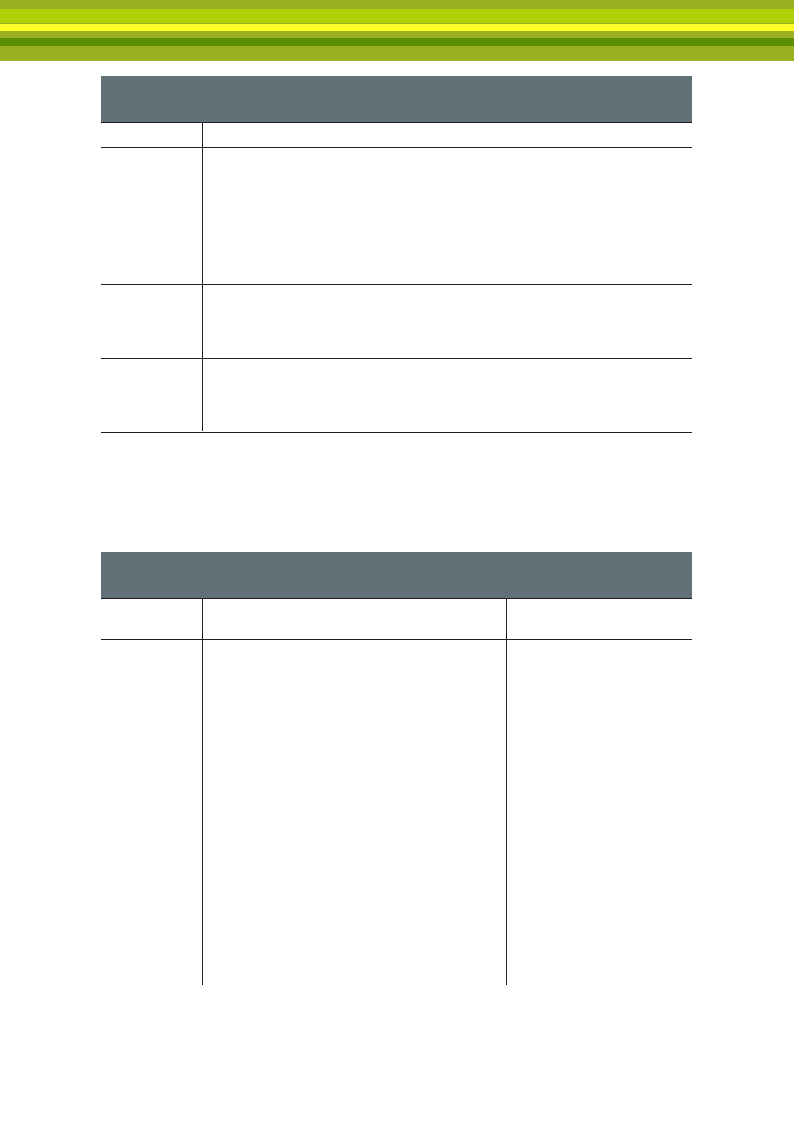
Table 5.19 Impacts of Natural Hazards on Water Supply, Irrigation,
and Electricity
Hazard
Impact of Natural Hazards on Water Supply, Irrigation and Electricity
Floods
• Contaminate water sources and block distribution and collection networks
• Increase intensity and frequency of severe weather events impacts on
energy infrastructure, power plants, transmission lines, refineries, oil and
gas drilling platforms, pipelines and power lines resulting high energy
prices
• Increase intensity and frequency of severe weather events impact design
and safety requirements of future energy infrastructure and other capital
investments
Droughts
• Cause water sources to dry up temporarily or even permanently, and
prevent sewerage networks from functioning adequately
• Extend periods of drought lead to reduced water availability for
hydropower generation, household consumption, and irrigation
Earthquakes,
landslides,
and
windstorms
• Damage wells, tanks, piped water distribution systems, and water towers
and disrupt solid waste collection systems
Steps for Mainstreaming DRM into Potable Water Supply and
Irrigation Development
Table 5.20 Key Steps and Activities for Mainstreaming DRM into Potable
Water Supply and Irrigation Development
Step
Potential Activities/Action/Role for DRM
Mainstreaming
Outcome
Step 1:
Planning for
Engagement
Summary: In this initial stage the objective is
to generate advocacy for DRM mainstreaming
with key stakeholders who have key roles and
responsibilities in the implementation of the
national development plan for potable water
supply and irrigation development sector. Key
stakeholders may include:
- Ministry of Water, Irrigation and Electricity
- Ministry of Health
- Ethiopian Electric and Power Authority
- Ministry of Education
- Regional Implementing Partners
- Wereda offices
- Development partners
- UN agencies
- National Metrological Agency (NMA)
- National Planning Commission
- Ministry of Finance and Economic
Cooperation
- Ministry of Environment, Forest and Climate
Change
Key stakeholders recognize
the need for mainstreaming
DRM into potable water
supply and irrigation
development
Guidance on conducting
situation analysis
110

Step
Potential Activities/Action/Role for DRM
Mainstreaming
This step aims to reach an agreement among
the above stakeholders for establishing a team
for conducting the situation analysis.
Outcome
Suggestions:
• Conduct meetings to facilitate partnership
with the key stakeholders
• Establish team for undertaking the situation
analysis (Step 2) and sharing findings and
reports with the key stakeholders
Step 2: Situa-
tion Analysis
Summary: This step deals with information
collection, identification of key risks related
to potable water supply and irrigation
development.
Sector briefing notes on
potable water supply and
irrigation development
Problem statement
Suggestions:
• Undertake study on detailed assessment
of floods in Ethiopia on water sources,
distribution and collection networks,
irrigation development projects (Box 5.5)
• Under take field baseline survey to
investigate on the existing irrigation system
and drainage canals, identifying problems
related to flood disasters and their causes
• Undertake detailed assessment of drought
on water resources, sewerage networks
(Box 5.5)
• Undertake assessment on awareness levels
of officials involved in planning and policy
formulation, including managers on disaster
risk management for water and irrigation
development
• Undertake necessary feasibility level
studies that look at alternative options,
including the associated costs, benefits,
and risks involved in delivering the project
or components of the project (may include
new available technology that can be used
to deliver the project or component(s) of
the project), and selecting the best possible
implementation plan/project options/
configurations/technology
• Review of the Ethiopia water sector policy,
Ethiopia water resource management
proclamation no. 197/2000, Ethiopia water
resource management policy, Ethiopia
water resource sector strategy, and Africa
water vision, among others
• Review the preformation of local
institutions and contractors in designing,
implementing, monitoring, and evaluating
projects with resilient design features in
irrigation infrastructure, rehabilitation, and
conservation of water bodies, etc.
111

Step
Potential Activities/Action/Role for DRM
Mainstreaming
• Use wereda-level risk information to
understand the current situation of water
availability, source of drinking water, access
to water for irrigation in weredas exposed
to the risk of natural hazards (Box. 5.5)
• Use problem tree and root causes tools to
conduct situation analysis
• Undertake strategy analysis
• Develop risk minimization and prioritization
strategy
Step 3: Main-
streaming
Action De-
velopment
Process
Summary: This step deals with the problem
validation process, problem prioritization
process, problem-solution tree analysis, and
action matrix development. Prioritize actions in
line with GTP-II actions.
Outcome
Sector briefing notes on
potable water supply and
irrigation development
Problem statement
Suggestions:
• Based on findings during the survey on the
irrigation and drainage infrastructures and
lower resilience to the floods and water
loggings, design and plan the drainage
infrastructure construction projects under
the GTP - II
• Use potable water supply and irrigation
development planning guidelines for
mainstreaming action development
processes
• Use GTP-II methodology for the problem
validation process, problem prioritization
process, problem-solution tree analysis, and
action matrix development
• Use prioritisation process for the validation
of issues and problems
• Use working group sessions with
stakeholders using a range of tools (e.g.,
problem-solution tree analysis, guiding
questions) for identifying root causes and
effects of key problems
• Identify root causes and solutions
• Following the assessment of risks and
analysis of stakeholder vulnerability, risk
management strategies such as trainings
can be proposed (see Box 5.6)
• Develop appropriate DRM strategy
and program to address specific
vulnerability level within the context of
the water, irrigation, agriculture, and rural
development
• Identify solutions by classifying possible risk
management strategies for potable water
supply and irrigation development into
three categories: mitigation, risk transfer,
and coping (see Case Study 2)
112

Step
Potential Activities/Action/Role for DRM
Mainstreaming
Step 4: Cost-
ing of Ac-
tions and
Develop-
ment of
Implementa-
tion Plan
Summary: Stage 4 deals with identifying and
developing a financial strategy, implementation
strategy, communication strategy, and
monitoring and evaluation strategy for
mainstreaming actions for potable water supply
and irrigation development.
Suggestions:
• Conduct cost analysis of mainstreaming
actions, including incremental cost (gaps)
and developing a financial strategy along
with potable water supply and irrigation
development actions/activities
• Create institutional arrangements such
as the creation of an implementation
unit along with the implementation unit
for potable water supply and irrigation
development activities
• Develop communication strategies for
mainstreaming actions under the potable
water supply and irrigation development
actions/activities under GTP - II
• Develop monitoring and evaluation
strategies for mainstreaming actions under
the potable water supply and irrigation
development actions/activities under the
GTP – II
Step 5:
Approval
Process
Summary: This step deals with obtaining
political support for risk sensitive development
of potable water supply and irrigation
development plans. The approval process
includes both sectoral and national approval
under the national development planning
framework of Ethiopia.
Outcome
Disaster resilient initiatives
are costed in the potable
water supply and irrigation
development
The potable water supply
and irrigation development
plan promotes risk sensitive
development
Suggestions:
• Provide evidence of the costs of such short-
term decisions in potable water supply
and irrigation development sector over the
short, medium and long- term
• Promote legislation change to incorporative
climate and disaster risk. Suitable legislation
often promotes incentives for potable water
supply and irrigation development sector.
For example, legislation is required for food
production
• Set appropriate monitoring systems
and enabling strategies at the planning,
execution, and evaluation stages of potable
water supply and irrigation development
plan
113

Step
Potential Activities/Action/Role for DRM
Mainstreaming
Outcome
Step 6:
Implementa-
tion, Moni-
toring, and
Evaluation
Summary: This step deals with implementation
and tracking progress towards achieving the
activities as per the action plan developed in
Step 4.
Suggestions:
o Monitoring and evaluation of DRM
mainstreaming actions should be
carried out within the GTP- II monitoring
and evaluation strategies
o Technical guidance will be provided
for compiling and analyzing the
collected information and data.
Currently, a biennial report is submitted
using the planned Sendai framework for
monitoring and evaluation
o The gaps, challenges or issues identified
in this step will be used to adjust
for continual improvements in the plan
implementation and for DRM efficacy
and cost effectiveness. In addition,
issues or gaps not adjusted are taken
up in Step 1 for discussion.
Continual improvements
in DRM efficacy and cost
effectiveness
Ensure resilient sector plan
implemented
114

Case Study 2: Integrated Watershed Management in Harbu,
Ethiopia
Source: DEVOE, D., 2013
Summary
In 2001, in the Harbu watershed of Ethiopia’s northern Kalu district, environmental
degradation could be seen in almost every direction. The hills were bare, with few
plants or grass growing on the steep slopes, which were historically green, fertile lands.
This degradation came about over many years. As the region’s population grew, farmers
cleared away the natural forest to grow crops. They cut trees for timber and firewood,
resulting in extreme deforestation. Rains began to carry away the top soil as water rushed
down hills. Farmers found it difficult to keep rain-fed crops watered in these conditions.
Yields dropped accordingly, a major concern for the majority of residents depending
on subsistence agriculture for survival. Families could no longer produce enough
sorghum for their needs, resulting in chronic food insecurity.
In 2001, CRS joined forces with Water Action, local leaders and the local government
agricultural office to implement an Integrated Watershed Management (IWM) project
targeting 570 households in Harbu. Water Action is a local NGO with considerable
experience in natural resource management, water supply, and livelihoods. The
project’s objective was to work with the community to reduce land degradation and
the risks of drought. At the start of the Harbu IWM project, the surrounding vegetation
cover was estimated at just 7 percent. Now, long stalks of grass bend in the breeze on r
egenerated hillsides. Achieving this in just a few years was a significant accomplishment.
What is presented? Integrated Watershed Management
• Knowing that community involvement would be the key to success, project
staff hosted community consultations to determine priority problems. Participatory
tools used included a transect walk, trend analysis, key informant survey, and
focus group discussions.
• The need to increase harvests and access safe, clean water quickly rose to the
top of the priority list. Women and children were traveling more than two miles to
collect water from rivers and unprotected springs for drinking, cooking, cleaning,
and for livestock.
• Construction – The project team and the community members decided to
construct one small-scale irrigation scheme, build two new water supplies, and
rehabilitate selected degraded hillsides through area closures.
• Committees/Association/Groups for community involvement – The watershed
development committee and irrigation water user association were in place to
oversee use of the irrigation scheme. Areas closure management committees,
two agro-enterprise groups, and two water and sanitation committees were in
place to collect fees and oversee maintenance of the water schemes.
115

• Trainings - Trainings were also held to increase committee members’ skills in natural
resource management, management of water supplies and irrigation schemes,
maintenance, recordkeeping, agricultural production, postharvest crop
management and agricultural marketing. In addition, project partners assisted
the committees in developing by-laws, taught them how to enforce the bylaws and
linked the committees with relevant government line offices for ongoing guidance
and support.
• Cash for work projects - The Harbu community also implemented a number of soil
and water conservation measures to further strengthen their resilience. Measures
included physical interventions, such as hillside terracing, soil and stone bunds,
check dams (small dams that slow water runoff and reduce soil erosion), gully
rehabilitation, cut-off drains and micro basins to collect surface runoff. Community
members also undertook biological measures, including planting trees, legumes
and grasses to reduce erosion and stabilize the physical structures.
• The community also established a cut-and-carry feeder system once 80 percent
of a degraded area rejuvenated. Residents living around the closed areas are not
able to let their livestock graze freely, they can cut grasses from the protected
areas to feed to their animals
What was achieved? – Impact and Results
• Sixty percent of project beneficiaries reported improvements in their overall
living conditions, highlighting increased food security and incomes. Beneficiary
households had more food, with annual food supplies increasing on average
the equivalent of one-months’ worth of food.
• Farmers using the small-scale irrigation system earned three times the amount
of farmers who are solely dependent on rain-fed agriculture.
• The Harbu watershed has significantly better vegetation cover, with coverage in
protected areas increasing from 7 percent to 80 percent. Community members are
still protecting the four closed areas and using grasses from these areas to feed
their livestock.
• The small-scale irrigation scheme and two water supplies established during the
project are still functional. These systems allow beneficiary families to be more
resilient to drought compared with other families in areas where water systems
have not been constructed.
• Forty-four miles of terraces on cultivated land has reduced soil erosion and
increased water retention, leading to increased agricultural productivity. Project
partners introduced improved varieties of sorghum, chick pea, pigeon pea,
groundnut and sesame, which further increase farmers’ yields. Sorghum yield
alone increased on average by 20 percent.
116

Is this case promoting mainstreaming DRR or providing an opportunity to
mainstream DRR?
• Drought risk was significantly reduced through Integrated Watershed
Management (IWM): IWM strengthens DRR efforts, drought and flood
preparedness and mitigation and sustainable livelihood and food security and
climate change adaptation
• Community institutions are prepared in terms of knowledge and skills to
address drought risk in future: The community institutions are now more
prepared to address the drought risk with their acquired knowledge by engaging
them in trainings, project implementation and monitoring activities
Way forward: Operational steps for mainstreaming DRR
• Promote integrated watershed management in drought affected areas: As
mentioned earlier, IWM strengthened DRR efforts, as well as drought and flood
preparedness and mitigation. It is essential that such projects are pilot tested
and implemented in drought prone areas. While selecting the project site for
IWM, Wereda Disaster Risk Profile should be referred as it provides detail
information on environmental characteristics, hazard characteristics, vulnerability,
exposure information of each wereda.
• Promoting integrated watershed management project for sustainable
agricultural development: The project clearly demonstrates how IWM
contributes in significantly better vegetation cover, increased agricultural productivity
(increased farmers’ yields, sorghum yield alone increased on average by 20 percent).
Thus, it is important that such projects are linked and implemented under the
GTP-II plan which aims to sustain agriculture development by expanding
watershed management practices.
• Promoting integrated watershed management project for improved water
resource management and utilization: The project clearly demonstrated how
IWS contributed in reduced soil erosion and increased water retention through
implementing irrigation scheme successfully. Moreover, farmers using the small-
scale irrigation system earn three times the amount of farmers who are solely
dependent on rain-fed agriculture. Thus, such projects should be promoted
and implemented under the GTP – II as the project contributes in improving
water resource management and utilization.
117

BOX 5.5 Promote the Use of Wereda Disaster Risk Profile Data and Information
for Irrigation Development Feasibility Study and Design
In the GTP II plan, medium and large-scale irrigation development feasibility studies
and designs on 250,000 ha and construction on 280,385 ha will be undertaken by
the Ministry of Water, Irrigation and Electricity. Wereda risk profile provides key
information about the status of access to water for irrigation in the community.
Moreover, within economic vulnerability – the status of agriculture, irrigation input
utilized households has been identified as one of the key factors by the population.
Thus, while developing the feasibility study and design for irrigation development
work, information and data of wereda risk profile should utilized or incorporated in
the feasibility study and design process.
BOX 5.6 Conduct Capacity Building or Training of Staff on DRM/R Integration
into Irrigation Development, Including Irrigation and Design Works
The GTP – II implementation strategies for Potable Water Supply and Irrigation
Development in Ethiopia also include conducting awareness trainings for officials
involved in planning and policy formulation on irrigation development. This platform
can be used for enhancing officials’ knowledge on best practices on DRR into irrigation
development projects, including large-scale and small-scale projects. Some of common
practices of small scale projects include drip irrigation practices, small scale irrigation
and reforestation, water harvesting schemes, small-dam based irrigation programs,
constructing irrigation system, rain water harvesting techniques including floodwater
diversion, on-farm runoff retention, soil moisture conservation, impounding in storage
structures, etc. Most of these practices are carried by the communities who have
generated a vast body of indigenous knowledge on disaster prevention and mitigation,
early warning, preparedness and response, and post-disaster recovery.
118
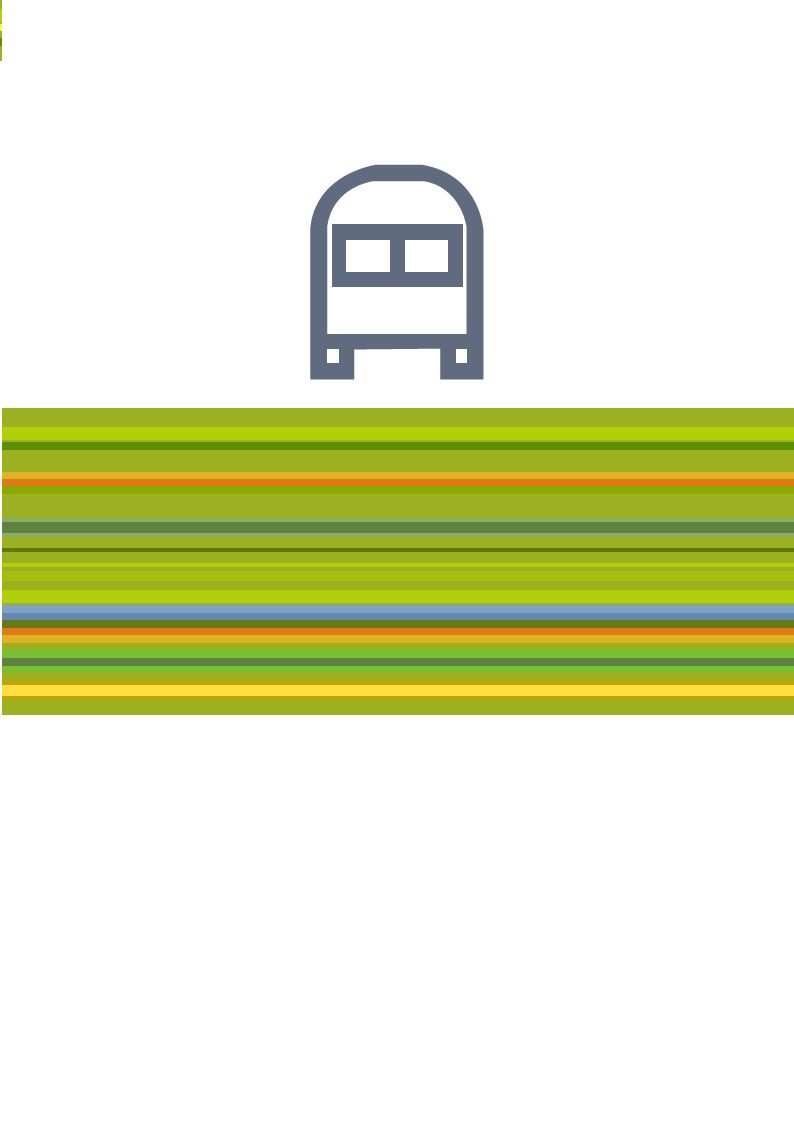
Guidance Note 5:
Integrated Transport and
Logistics Services

Integrated transportation and logistics services is one of the key sectors/sub-
sectors that contributes to the economic infrastructure plan during the Second
Growth and Transformation Plan (GTP – II), and was developed as an outcome of
national development planning process in Ethiopia. It is represented by the several
agencies, namely, Transport Authority, Ethiopian Railways Corporation, and Ethiopia
Civil Aviation Authority, Ethiopian Road Authority, and the Ethiopian Shipping Agency.
The roles and responsibilities of the ministry/authority/agency in the national
development planning and implementation of national development plan8 and DRM
are defined in Table 5.21.
Table 5.21 Lead Agencies Roles and Key Programs on DRM: Integrated
Transport and Logistics Services*
Lead Agen- Roles & Responsibilitiess
cy/Ministry
Key Programs on DRM
(Example)
Ministry of
• Responsible for implementing specific
Flood protection
Transport (air,
objectives related to transportation services components of the water
road, railways,
in the national development plan. The
resource development
and sea)
ministry is also accountable for monitoring, program
evaluating, and reporting on progress and
achievements in implementation
• Responsible to passengers’ safety through
reduced disaster risk
• Responsible for implementing specific
objectives related to railway infrastructure in
the national development plan. Corporation
is also accountable for monitoring,
evaluating, and reporting progress and
achievements of implementation
• Responsible for implementing specific
objectives related to air transport
service, marine transport, and logistics
infrastructure in the national development
plan. Authority is also accountable for
monitoring, evaluating, and reporting
of progress and achievements of
implementation
• Provide safety of passengers and their
properties
National
Disaster Risk
Management
Commission
(NDRMC)
Provides key information about:
• Physical vulnerability (e.g., access to roads
and urban center)
• Disaster events related to transport sector
WDRP
* Information presented in above table is illustrative and not exhaustive. It is subjected to government structure arrangement
in the country.
120

Objectives
The major objectives of integrated transportation and logistics services are to, 1)
enhance availability, accessibility and quality of transportation services, 2) reduce
traffic accidents and property damage, 3) support transportation of agricultural
and industrial products to enhance their competitiveness in the global market, 4)
support private sector investment and trade activities, 5) reduce the overall import
and export transit time and associated cost (National Planning Commission, 2016a).
The major objectives will be implemented through realizing specific objectives outline
in Table 5.22.
Table 5.22 Specific Objectives for Integrated Transportation and
Communication
Specific Objectives
Agency
Increase transportation services
Transport Authority (TA)
Increase supply of railway infrastructure
ERC and TA
• Improve the quality and expansion of air transport service ECAA, Ethiopian shipping
• Improve the supply of safe and accessible marine
Agency
transport and logistics infrastructure
Source: (National Planning Commission, 2016b)
Implementation Strategy
The objectives of integrated transportation and logistics services, including specific
objectives are implemented through a strategy developed under the GTP – II. The
implementation strategies of the transport and logistics sector are:
• Plan efficient port operation, which includes avoiding congestion through prioritization
• Develop strategic relief fleet management
• Conduct warehouse management
• Ensure quality control
• Develop alternate port usage strategy
• Enable the private sector participate in the development of ports in collaboration with
the government to increase foreign exchange earnings and reduce expenditures by
introducing systems
• Provide transport facilities in line with the demand for road transport
• Reduce waiting time of goods at ports
• ncrease the number of marine workers and register ships owned by other countries
• Support the logistics system with modern technology
• Conduct problem oriented research and trainings
• Enable operators and institutions to provide knowledge based services
• Establish a center of excellence to enable the sector’s regulatory institution equip them
with the necessary knowledge
• Strengthen and expand the national logistic centers and improve the capacity of logistics
service providers (National Planning Commission, 2016b)
• The following implementation strategies are designed to effectively implement the
transport and logistics plan:
• Establish the Ethiopian National Logistics Coordination Council (ENALCO) with the
necessary legal framework
• Establish logistics transformation office (LTO)
• Establish improved trade system
121

• Establish corridor facility and modern transit transport system, fulfil logistics
infrastructure
• Establish information communication system
• Improve containerization procedure and implement ships registration policy
• Make the road traffic safety the main agenda of the political leadership at all levels
• Work in partnership with traffic police to improve the enforcement of road traffic laws
• Strengthen coordinated activities with stakeholders
• Improve the coordinated activities of the federal and regional transport organizations
and working procedures
• Establish transport system to link major cities of the country and import freight transport
vehicles with high loading capacity (National Planning Commission, 2016b)
Roads and Disasters
Temperatures are projected to rise across the African continent and very high
temperatures can result in the softening and rutting of asphalt roads (Cervigni et al.,
2017). Some parts of Africa will see an increase in precipitation, which can lead to
reduced load-carrying capacity and lifespan of roads. Many parts of Africa will face more
intense precipitation, which can increase flooding frequencies. These floods can overrun
and erode roads, particularly unpaved roads. Some recent literature also provides
insights about the potential economy-wide implications of severe climate events that
affect the road network, particularly implications for food security (Cervigni et al., 2017).
For example, in Burkina Faso, maize price volatility is found to be greatest in remote
(poorly connected) markets. As climate change further reduces connectivity, this raises
the potential for food shortages and economic shocks to vulnerable areas.
The road network in Addis Ababa is vulnerable to gridlock, particularly at peak hours.
There are some key points of high traffic congestion, but much of the network is
susceptible to delays caused by lack of traffic management, breakdowns, or accidents
(Cervigni et al., 2017). Even minor accidents can cause substantial disruption to traffic
flows, delaying the arrival of emergency services. Currently, transport development
plans and regulations do not include such risk analysis.
There is a strong dependency between roads and urban drainage, as existing and new
roads interrupt natural drainage patterns (Cervigni et al., 2017). Run-off has been
increasing due to the increased area of hard landscape. Flooding causes significant but
short-lived disruption to the road network, as a result, congestion and delays tend to
increase during the rainy seasons. At present, road transportation infrastructure is
funded from the city’s own budget. Generally, the city does not include resources for
road maintenance; it is sourced from the national road fund, whose allocation to
Addis Ababa is generally inadequate for comprehensive maintenance. It is
recommended that the city supplements maintenance resources from the road fund
with its own resources.
122

Steps for Mainstreaming DRM into Integrated Transport and
Logistics Services
Table 5.23 Key Steps and Activities for Mainstreaming DRM into
Integrated Transport and Logistics Services
Step
Potential Activities/Action/Role for DRM
Mainstreaming
Outcome
Step 1:
Planning for
Engagement
Summary: In this initial stage, the objective
is to advocate for DRM mainstreaming into
the transportation and logistics services
sectors, including relevant agencies (i.e., key
stakeholders) such as Transport Authority (TA),
Traffic Police, Ethiopian Marine time logistic
authority, Ethiopian Road Authority, Ethiopian
Rail Transport Authority, Civil Aviation Authority,
NDRMC, National Planning Commission, Ministry
of Finance and Economic Cooperation and
sector development planning office, vulnerable
groups representatives, among others.
Key stakeholders recognize
the need for integrating
DRM into transportation
and logistics services
Broad approach and
guidelines for conducting
situation analysis
Step 2:
Situation
Analysis
Suggestions:
• Establish Regional Traffic Committee, Road
Traffic Committee, incorporate transport
education in the national education
curriculum
• Establish team for conducting the situation
analysis
• Conduct meetings to facilitate partnership
with key stakeholders at different levels for
mainstreaming DRM into transportation and
logistics services
• Present brief information on the recent
disaster and climate change impacts on
the transportation and logistics services in
Ethiopia
• Undertake situation analysis (Step 2)
Summary: This step deals with information
collection, identification of key risks related to
transportation and logistics services in Ethiopia.
Sector briefing notes on
transportation and logistics
services
Suggestions:
• Use wereda risk information management
system to understand physical
vulnerabilities, such as access to roads and
urban center (i.e., percentage of households
by type of road and time taken to access
the nearest paved road and urban center)
• Review and analyze traffic damage and its
impacts on people and services
• Gather information, or if required
undertake study on the impact of disasters
on transportation and logistics services in
Ethiopia
Problem statement
123

Step
Step 3:
Main-
streaming
Action
Develop-
ment
Process
Potential Activities/Action/Role for DRM
Mainstreaming
Outcome
• Undertake study on the impacts of disasters
on the road sector in Ethiopia
• Undertake disaster risk and resilience
assessment in transportation system (IMC
Worldwide)
• Review relevant guideline for conducting EIA
of the roads
• Review and gather information on the best
practices from Road Sector Development
Program (1997-2007)
• Review the transportation policy of Addis
Ababa from the current disasters and
climate risks context
• Develop sectoral briefing note on urban
development and housing. The note
should be used during the development of
mainstreaming DRM actions (Step 3)
Summary: This step deals with the problem
validation process, problem prioritization
process, problem-solution tree analysis, and
action matrix development. Actions should be
prioritized in line with GTP-II actions.
Suggestions:
• Based on findings from Step 2 and the
sectoral briefing note, identify and prioritize
actions for mainstreaming DRM into
sectoral instruments (Figure 5.2)
• While designing mainstreaming DRM
actions, incorporate sectoral instruments
(e.g., policies, GTP, several decrees), sectoral
risk (e.g., softening of roads, accidents,
asphalt roads), and sectoral strategies
(e.g., improving road construction, strong
law enforcement in the transport sector,
awareness of road accidents, and building
feeder roads to reduce traffic)
• Promote the use of DRR into ESIA and
SESA or feasibility study for transport
related infrastructure, including roads:
This may include capacity building of
officials responsible for conducting
feasibility studies or ESIA and SESA on
how to integrate DRR. It can also include
reviewing and updating sections, such as,
Environmental Impact Statement Screening
Forms, Initial Environmental Examination
Checklist, etc. (see Box 5.7)
• Promote regular assessment of traffic
damage with a continuous education
awareness through media, radio, and TV
Problem tree(s) Root-causes
Mainstreaming DRM action
matrix for transportation
and logistics
124

Step
Step 4:
Costing
of Actions
and
Develop-
ment of
Implemen-
tation Plan
Potential Activities/Action/Role for DRM
Mainstreaming
Outcome
• Establish communication systems during
an emergency: Compatible and reliable
communication systems between service
providers and between service providers
and road users must be available during
an emergency (see Box 5.8). Within GTP
– II, this can be established along with the
implementation strategy to establish an
Information Communication System
• Promote transport planning with disaster
and climate risk as separate criteria for
identification, and preparing appraisal
standards (see Box 5.9)
• Promote local approaches to mitigate
the effects of disasters on the transport
network: These may include promoting
local authorities to interact and share
information on a regular basis so similar
levels of resilience can be achieved. Local
authorities and communities should
understand the risks affecting their
infrastructure and what infrastructure is
critical in their community.
• Promote a coordination mechanism for
strengthening the operational aspects of
mainstreaming DRM into transportation and
logistics services.
Summary: Stage 4 deals with identifying and
developing a financial strategy, implementation
strategy, communication strategy, and a
monitoring and evaluation strategy for
mainstreaming actions for transportation and
logistics.
Disaster resilient initiatives
are prioritized in the
transportation and logistics
plan
Suggestions:
• Costing of mainstreaming actions, including
incremental cost (gaps) and developing a
financial strategy along with transportation
and logistics actions/activities
• Create institutional arrangements such
as the creation of an implementation unit
along with the implementation unit for
transportation and logistics
• Develop communication strategies
for mainstreaming actions under the
transportation and logistics actions/
activities under GTP – II
• Develop monitoring and evaluation
strategies for mainstreaming actions under
the transportation and logistics actions/
activities under the GTP – II
125

Step
Step 5:
National
Approval
Process
Step 6:
Implemen-
tation,
Monitoring,
and
Evaluation
Potential Activities/Action/Role for DRM
Mainstreaming
Summary: This step deals with obtaining
political support for risk sensitive development
of transportation and logistics plan.
Suggestions:
• Provide convincing evidence of the costs of
such short-term decisions in transportation
and logistics sector over the short, medium
and long-term
• Promote legislation change to incorporative
climate and disaster risk. Suitable
legislation often promotes incentives for
transportation and logistics
• Set appropriate monitoring systems
and enabling strategies at the planning,
execution and evaluation stages of
transportation and logistics plan
Summary: This step deals with implementation
and tracking progress towards achieving the
activities as per the action plan developed in
Step 4.
Suggestions:
• Monitoring and evaluation of DRM
mainstreaming actions should be carried
out within the GTP- II monitoring and
evaluation strategies
• Technical guidance will be provided for
compiling and analyzing the collected
information and data. Currently, a biennial
report is submitted using the planned
Sendai framework for monitoring and
evaluation
• The gaps and challenges identified in this
step will be used to adjust for continual
improvements in the plan implementation
for DRM efficacy and cost effectiveness. In
addition, issues or gaps not adjusted are
taken up in Step 1 for discussion.
Outcome
The transportation and
logistics plan promotes and
strengthen risk sensitive
development
Plan implementation is
adjusted for continual
improvements in
DRM efficacy and cost
effectiveness
126

BOX 5.7 Disaster Risk Reduction and the Road Network, The Philippines
The Philippines is exposed to many natural hazards, such as typhoons, floods, and
earthquakes. As a result, the road network is exposed to landslides, road slips,
embankment scouring, and other geotechnical hazards. Road closures are common,
disrupting both the movement of passengers, goods, and services, which affects
communities and well as negatively impacts the country’s economy and infrastructure.
The road sector was considered a priority for mainstreaming disaster risk reduction by
the Regional Consultative Committee (RCC) on Disaster Management. Against this
background, a partnership was developed between the Philippines National Disaster
Coordinating Council (NDCC) and the Philippines Department of Public Works and
Highways to implement DRR on the road network in the Philippines. The partnership
was technically supported by the Asian Disaster Preparedness Center (ADPC), with
financial support from UN International Strategy for Disaster Reduction (UN/ISDR)
through Swedish International Development Cooperation Agency (SIDA). A Technical
Working Group was established with multi-agency membership in order to steer the
project and provide the technical inputs as needed.
The basic approach included, 1) examining existing procedures followed in regards to
DRR and road projects, particularly the feasibility and preliminary stages, 2) analysing
the damage to road infrastructure from disasters, 3) identifying steps for incorporating
DRR into project developments, and 4) reviewing the future priority needs for road
construction projects. A short report was published about the strategy and actions
carried out to achieve these aims. It was titled, “Towards Mainstreaming Disaster Risk
Reduction into the Planning Process of Road Construction”. This case study provides
a summary of the main points.
Policies, Institutions and Processes
• Liaise with a large number of stakeholders, programs, projects, and agencies:
The report recognised that mainstreaming DRR concerns into the road sector
involves a number of stakeholders and interrelated plans and programs, including
road maintenance investment programs, road improvements, seismic vulnerability
assessments, technical assistance for risk assessment and management, monitoring
and evaluation of roads, studies on sediment related disaster on national highways,
and hazard mapping and assessment for community disaster risk management
programs.
• Improve Environmental Impact Assessments (EIA): The previous EIA report
structure considers the impact of hazards by defining an“environmentally critical
area” of the project site that is frequently affected by natural hazards. However, it
does not explicitly provide details on how to address natural hazard vulnerability
and risks to infrastructure and the consequent impact from its damage or failure.
Financial Arrangements and Incentives
• The report advises that by considering risks at an early stage, there is the potential
for cost saving. For example, the alignment of roads that avoid areas of high
landslide risk may avoid costly stabilization techniques that would have not
otherwise been identified until geotechnical investigations were carried out at
the detailed design stage (RCC, 2008). It also points out that national budgets do
not always provide funds for surveys and investigations at the feasibility study
stage, and it is therefore unusual for disaster risk reduction measures to be
incorporated at early stages of project preparation. The cost-benefit analysis did
not comprehensively consider DRR.
127

Operations and Maintenance
• The key recommendation for successfully integrating disaster risk
reduction into road projects lies in the planning phase of the project
cycle, which includes project identification and preparation of the
feasibility study. Feasibility reports should include an assessment of the impact
of potential disasters, and DPWH needs to have a standard for project
identification and preparation procedures in order to eliminate quality
discrepancies between nationally and externally funded projects and to pave the
way for mainstreaming disaster risk reduction in road projects. This case study
found that the Department of Public Works and Highways administers a basic
feasibility study, typically due to lack of funding for construction of national road
projects, but for foreign-assisted projects, the assessment process is more
extensive. It was also noted that externally funded projects are prepared to
higher standards, particularly in relation to environmental assessments (where
disaster risk aspects are described if required by the particular agency) and
resettlement planning. It was reported that the road studies undertaken did
look at hazards, but were primarily limited to protecting the road segments
from geological hazards such as landslides and debris, and not comprehensive.
• Data, monitoring and risk assessment: It was reported that there was an
uneven application of design standards between national and local roads, including
an absence of one fixed format for collecting information on damage to roads
and bridges from natural hazards. Hydrological data was available, but information
was not uniformly processed to allow it to be used in road design (ADPC, 2008;
RCC, 2008). It was additionally noted that it is important to benchmark hazard
intensities with their return periods/damages. However, this was difficult due to l
ow resolution topographic maps, few hazard monitoring stations and a short
monitoring period with limited processed data on hazards. The report
recommended that the capacity of staff to assess the impact of disasters needs
to be increased, particularly at regional and district levels.
Source: (El Nakat, 2015)
Box 5.8 Communication During Emergency Response
After the 2007 earthquake in Peru, national telecom operators and the Transport and
Communications Ministry created a special emergency phone network to connect the
presidential office, the police, fire departments, and health institutions (UNISDR, 2008).
Missouri’s Department of Transport reaches commercial vehicle operators through
trucking organizations (FHWA, 2012).
Social media was used to communicate with the public about the recovery effort in
New York following Sandy. The Daily Pothole Tumblr, which documents NYCDOT street
maintenance crews, was temporarily transformed into the “Sandy Recovery” page to
document clean-up efforts. The number of Daily Pothole subscribers increased by 50
percent after the storm, to 15,000, as did NYCDOT’s Twitter and Facebook following
(NYC, 2013).
Source(El Nakat, 2015)
128

Box 5.9 Checklist for Encouraging Disaster Risk Reduction to be Mainstreamed
into Transport Projects - Identification, Preparation, and Appraisal Standards
Governments can encourage disaster risk reduction to be mainstreamed into transport
projects (e.g.,roads, highways, airports, interchanges, etc.) by issuing standards and
guidance on project identification and preparation procedures.
• Appraisal models: They evaluate and prioritize the costs and benefits of various
options, and could also measure the cost of infrastructure damage, failure, and
service delays from multiple natural hazards, and the benefits of long-term
resilience.
• All feasibility reports should include an assessment of the impact of disasters
on transport infrastructure.
• Neighboring land-use practices and upper catchment land management should be
included within the scope of transport projects.
• ESIAs can become critical tools for mainstreaming resilience into transport
infrastructure by explicitly addressing the impact of natural hazards on
infrastructure, and by also considering climate change and how a project will
respond to an “evolving environmental baseline” (European Commission, 2013,p15).
• Project reporting standards: Technical experts must ensure that there are
project evaluation and reporting requirements in place to share all information
about the project’s capabilities and limitations with key decision makers and
emergency responders.
• Standards can stipulate the study teams and stakeholders to be engaged in the
identification and planning of all transport projects in order to ensure the impact of
natural hazards is taken into account.
• Guidelines should prescribe engaging with communities and emergency
responders right from the initial project design through to identifying and
evaluating adaptation options.
Source: (El Nakat, 2015)
129

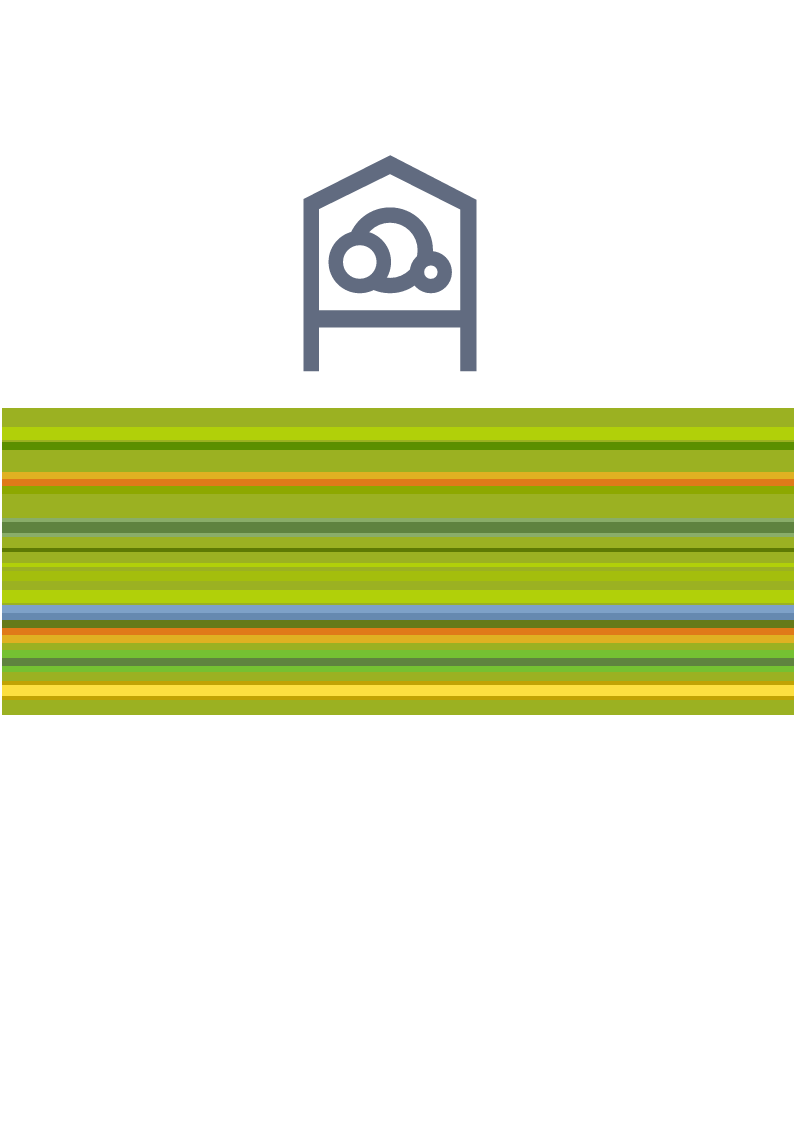
Guidance Note 6:
Urban Development and Housing

Urban development and housing is one of the key sectors/sub-sectors that
contributes to the economic development sector plan during the Second Growth
and Transformation Plan (GTP – II), and was developed as an outcome of national
development planning process in Ethiopia. The sector is represented by the Ministry of
Urban Development and Housing. The roles and responsibilities of the ministry in the
national development planning and implementation of national development plan8 and
disaster risk management are defined in Table 5.24.
Table 5.24 Lead Agencies Roles and Key Programs on DRM: Urban
Deveopment and Housing*
Lead Agen- Roles & Responsibilitiess
cy/Ministry
Key Programs on DRM
(Example)
Ministry
• Responsible for implementing specific
of Urban
objectives related to urban development
Development
and housing in the national development
and Housing
plan. The ministry is also accountable
for monitoring, evaluating, and reporting
on progress and achievements in
implementation
• Leads institution with respect to urban
infrastructure and building and other
constructions related hazards and
associated disasters and other urban
disasters, including fire
• Responsible for issuing building codes
• Provides key information on physical
vulnerabilities, such as access to roads and
urban center
• Provides information on technological
hazards
Flood protection
components of the water
resource development
program
National
Disaster Risk
Management
Commission
(NDRMC)
Provides key information about:
• Physical vulnerability, such as access to rural
roads and rural village center, and type of
dwelling units
Wereda Disaster Risk Profile
Ministry of
Environment,
Forest and
Climate
Change
• Environmental situation: Changes in
landscape
• Environmental situation: Environmental
problems
• Environmental situation: Natural resources
availability
• Issues certification of environmental safety
* Information presented in above table is illustrative and not exhaustive. It is subjected to government structure arrangement
in the country
132

Objectives
The main objectives of the integrated housing development program are to improve
urban housing provision and related challenges, and to minimize the escalating
housing demand by sustainable provision of housing and related services. A common
platform will be created with concerned parties and institutions to facilitate the
continuous provision and expansion of integrated urban infrastructure by
strengthening infrastructure financing capacity and transferring skills and technology
(National Planning Commission, 2016a).
Additional objectives of the sector are to ensure the use right of urban land by
organizing and strengthening urban land information system with modern technology,
and to realize urban development and urban good governance through active public
engagement, and building strong urban development army and labor-based approach
to public works. The other objective is to develop and manage climatic resilient urban
green infrastructure so as to create conducive working and living environments for
citizens, and to realize the vision of green economy (National Planning Commission, 2016a).
Additionally, the program aims to enable women, youth, elderly, children, and the
unemployed individuals in the community to benefit from urban development activities,
and ensure their safety through introducing new occupational safety standards and
strengthening existing ones (National Planning Commission, 2016a).
Other related objectives include: creating urban development leadership at each level
of urban administration; enabling and supporting poor and food insecure sections of
the urban community to generate their own income and improve their livelihood;
establishing efficient and cost-effective urban planning and implementation systems,
aimed at realizing the urban development and good governance objectives (National
Planning Commission, 2016a).
In order to achieve the above objectives, specific objectives with outputs and indicators
were developed for a given time frame (2015/16 – 2019/20) (Table 5.25).
Table 5.25 Specific Objectives of Urban Development and Housing
Specific Objectives
Agency
• Improve the provision of urban and rural housing
Ministry of Urban Development
• Ensure urban food security and employment through
and Housing (MoUDH)
PSNP
• Strengthen urban planning system
• Strengthen urban land provision and administration
• Improve urban infrastructure provision and administration
system
• Improve urban infrastructure provision and management
system
• Strengthen solid waste management and disposal system
• Expand urban climatic change adaption technologies and
activities
• Protect urban environment pollution and enhance
efficient energy and resource usage
• Develop urban building, construction, and road codes
Source: (National Planning Commission, 2016b)
133

The objectives of urban development and housing are implemented through a strategy
developed under the GTP – II. The implementation strategies consist of various programs
briefly described below.
Implementation Programs
• Scientific, rational, and developmental urban leadership building program
• Urban development safety net program
• Urban good governance and capacity building program
• Urban planning and implementation program
• Urban land development and management reform program
• Housing development and management program
• Integrated urban infrastructure delivery program
• Urban green infrastructure development and beautification improvement program
• Urban map production, surveying, and land use right registration program
• Urban finance development and management program (National Planning Commission,
2016a)
Urbanization and Disaster Risk
Urban populations in Africa are affected by numerous disasters. These range from
acute but infrequent events such as traffic accidents, building collapse, pollution
(e.g., air, water, environmental pollution), fire, floods, epidemics and terrorism that can
kill or injure large numbers of people, to chronic and recurrent events that may affect
only a few households or individuals at a time, but cumulatively have the greatest
impact on poor people. While large-scale disasters often receive media and policy
attention, and generate support from governments and the international humanitarian
community, small events seldom receive the same level of attention, and it is usually
individual households or communities that are left to cope. Urban risks in Ethiopia
are increasingly becoming a concern due to increasing exposure to hazards and
vulnerabilities in urbanized and rapidly urbanizing areas, for example, Table 5.26
shows shocks and stresses in Addis Ababa. Thus, it is essential that both shocks and
stresses in the urban areas of Ethiopia receive deserved attention in the planning
and development of urban areas. In addition, the existing risks in the urban areas
should be treated with sectoral strategies (i.e., cope and transfer) (Figure 5.2).
134

Table 5.26 Shocks and Stresses in Addis Ababa
Lead Agency/
Ministry
Roles & Responsibili- Key Programs on DRM (Example)
tiess
Flooding, urban
fire, earthquake,
traffic accidents,
building collapse,
environment
pollution (e.g.,
air, water, noise),
fire, floods, and
epidemics
Unprecedented urban
growth, water scarcity,
unemployment and
social vulnerability
• Climate of Addis Ababa is forecasted
to have an increase in precipitation
variability and temperature. This will likely
induce a wide range of shocks in the city
• Geographic location and topographic
features of Addis Ababa, compounded by
the existing state of the drainage system,
road network and sewerage system
exposes the city to street and riverine
flooding and landslides
• Increasing temperatures due to climate
as well as land-use changes in the city,
combined with poor housing standards
could further amplify fire incidents
• If an earthquake was to occur at about
27 km away from the city (at similar
magnitude of historic earthquake events
in the 20th century), it is estimated that
15% of buildings could collapse, and it
could result in a high number of fatalities
(UNISDR, 1999).
Steps for Mainstreaming DRM into Urban Development and
Housing
Table 5.27 Key Steps and Activities for Mainstreaming DRM into Urban
Development and Housing
Step
Potential Activities/Action/Role for DRM
Mainstreaming
Outcome
Step 1:
Planning for
Engagement
Summary: In this initial stage the objective
is to advocate for DRM mainstreaming
into the urban development and housing
sector, including relevant agencies such as
Ministry of Labour and Social Affairs, National
Planning Commission, Ministry of Women’s,
Children’s and Youth Affairs, Ministry of
Finance and Economic Cooperation and Sector
Development Planning Office, vulnerable groups
representatives, among others.
Key stakeholders
recognize the need for
integrating DRM into urban
development and housing
Broad approach and
guidelines for conducting
situation analysis developed
Suggestions:
• Conduct meetings to facilitate partnership
with the key officials from Ministry of
Urban Development and Housing, National
Planning Commission, Ministry of Women’s,
Children’s and Youth Affairs, Ministry of
Finance and Economic Cooperation and
Sector Development Planning Office,
for mainstreaming DRM into urban
development and housing
135

Step
Potential Activities/Action/Role for DRM
Mainstreaming
• Present brief information on the recent
disaster and climate change impacts on the
urban development and housing sectors
(i.e., shocks and stress in urban areas)
(Table 5.26)
• Establish a team for undertaking a situation
analysis (Step 2)
Step 2: Situa- Summary: This step deals with information
tion Analysis collection, and identification of key risks related
to urban development and housing.
Outcome
Sector briefing notes on
urban development and
housing
Suggestions:
• Use wereda risk information management
system to understand the disaster (shocks)
and stresses characteristics by kebele in
urban areas of Ethiopia
• Use wereda risk information management
system to understand the physical
vulnerability, such as access to roads and
urban centers, households’ access and
utilization of electricity, and households’
type of dwelling houses
• Use wereda risk information management
system to understand the social
vulnerability. Study demographic
characteristics of households, population
structure by kebele, education status of
household members, household access to
health facilities, among others
• Use wereda risk information management
system to understand environmental
situation in urban areas. Consider reasons
for environmental changes and their
effect for each kebele, changes observed
by the community on landscape and the
problems due to the changes, and observed
changes on rainfall and temperature by the
community over the last decade.
• Use wereda risk information management
system to understand economic
vulnerability in urban areas by looking at
major categories of occupation and percent
of population engaged in the occupation
by kebele, percent of population above
15 years of age by occupation categories,
households’ important sources of livelihood
(response in %), among others
• Use “City Strength Resilient Cities Program”
to understanding the qualities of resilience
(i.e., robust, coordinated, inclusive,
redundant, reflective). Refer to Box 5.10 to
understand the case for Addis Ababa
Problem statement
136

Step
Potential Activities/Action/Role for DRM
Mainstreaming
• Use wereda risk information management
system to understand household access to
health facilities, drinking water, sanitation,
etc. in the hazard prone weredas
• Undertake study on drought and flood
impacts and current risks experienced
by the disabled population and current
coping mechanism, DRR knowledge, and
challenged faced by the group in Ethiopia
• Review relevant guidelines, manuals, ESIA
document etc., from current climate and
disaster risks. For example, urban planning
and implementation manual, integrated
urban infrastructure and services planning
manual, manual for the preparation of
social development strategy for urban
vulnerability groups, among others
• Develop sectoral briefing note on urban
development and housing. The note
should be referred and used during the
development mainstreaming DRM actions
(Step 3).
Step 3: Main-
streaming
Action De-
velopment
Process
Summary: This step deals with the problem
validation process, problem prioritization
process, problem-solution tree analysis, and
action matrix development, where actions
should be in line with GTP-II actions.
Suggestions:
• Based on findings from Step 2 and the
sectoral briefing note, identify and prioritize
actions for mainstreaming DRM into
sectoral instruments (Figure 5.2)
• Promote better understanding of urban
vulnerable groups to natural hazard
risks. This may include reviewing the
existing manual for preparation of social
development strategy for urban vulnerable
groups by introducing participatory
methods and tools for the understanding
of the urban risk (e.g., hazards, vulnerability,
exposure elements, local community
based strategy to address urban risk,
etc.). Use wereda risk profile information
management system as a baseline
• Promote integration of solid waste
management practice in urban areas (Box.
5.11). Within GTP – II, this practice can be
implemented to strengthen solid waste
management.
• Promote safe building codes and safety
regulations (see Box 5.12). Within GTP – II,
this can be implemented to improve the
Improve the provision of urban and rural
housing.
Outcome
Problem tree(s) Root-causes
Mainstreaming DRM
action matrix for urban
development and housing
137

Step
Step 4:
Costing of
Actions and
Develop-
ment of
Implementa-
tion Plan
Step 5:
Approval
Process
Potential Activities/Action/Role for DRM
Mainstreaming
• Promote safe FIRE CODE in urban areas
by revising and updating the international
standards
• Promote awareness about the dos and
don’ts to protect from different pollution
sources, river quality, poor hygiene
practices, and waste management
• Encourage people to understand their roles
in Solid Waste Management Proclamation
No. 513 and the Environmental Pollution
Control Proclamation
Summary: Stage 4 deals with identifying and
developing a financial strategy, implementation
strategy, communication strategy, and a
monitoring and evaluation strategy for
mainstreaming actions for urban development
and housing.
Suggestions:
• Costing of mainstreaming actions, including
incremental cost (gaps) and developing
a financial strategy along with urban
development and housing actions/activities
• Create institutional arrangements such
as the creation of an implementation unit
along with the implementation unit for
urban development and housing
• Develop communication strategies for
mainstreaming actions under the urban
development and housing actions/activities
under GTP – II
• Develop monitoring and evaluation
strategies for mainstreaming actions under
the urban development and housing
actions/activities under the GTP – II
Summary: This step deals with obtaining
political support for risk sensitive development
of urban development and housing plan.
Suggestions:
• Provide convincing evidence of the costs
of such short-term decisions in urban
development and housing sector over the
short, medium and long term
• Promote legislation change to incorporative
climate and disaster risk. Suitable legislation
often promotes incentives for urban
development and housing
• Set appropriate monitoring systems
and enabling strategies at the planning,
execution, and evaluation stages of urban
development and housing plan
Outcome
Disaster resilient initiatives
are prioritized in the urban
development and housing
plan
The urban development
and housing plan promotes/
strengthens risk sensitive
development
138

Step
Step 6:
Implementa-
tion, Moni-
toring, and
Evaluation
Potential Activities/Action/Role for DRM
Mainstreaming
Summary: This step deals with implementation
and tracking progress towards achieving the
activities as per the action plan developed in
Step 4.
Suggestions:
Monitoring and evaluation of DRM
mainstreaming actions should be carried out
within the GTP- II monitoring and evaluation
strategies
Technical guidance will be provided for
compiling and analyzing the collected
information and data. Currently, a biennial
report is submitted using the planned Sendai
framework for monitoring and evaluation
The gaps and challenges identified in this
step will be used to adjust for continual
improvements in the plan implementation
and for DRM efficacy and cost effectiveness. In
addition, gaps not adjusted are taken up in Step
1 for discussion.
Outcome
Plan implementation is
adjusted for continual
improvements in
DRM efficacy and cost
effectiveness
Box 5.10 City Strength Resilient Cities Program for Addis Ababa
The Resilient Cities Program was launched by the World Bank Group in December 2013
to help cities strengthen their ability to prepare for and adapt to changing conditions,
and to withstand and recover rapidly from disruptions related to climate change,
natural disasters, and other shocks and stresses. The program serves as an umbrella for
delivering the analysis, rationale, and supporting local governments to make resilience
part of their urban management agendas.
The CityStrength Diagnostic was developed as a means of engaging cities on the
complex issue of resilience by using a holistic approach to identify priority actions and
investments to strengthen urban systems. Designed to be implemented by sectoral
specialists, the rapid diagnostic process draws upon ideas and data from a multitude of
existing tools. A longer-term goal of CityStrength is to promote alignment in approaches
to urban resilience to improve awareness of resilience considerations among local
leaders and development partners. Financial and technical support for the development
of the Diagnostic was provided by the Global Facility for Disaster Reduction and Recovery
(GFDRR).
In February 2015, Addis Ababa invited a team of specialists from the World Bank Group
to implement the CityStrength Diagnostic in close collaboration with local officials,
technical staff, and stakeholders.
Source: (World Bank, 2015)
139

Box 5.11 Check List for Integrated Solid Waste Management Initiatives in Cities
• Avoid disposing solid waste in flood retention areas, and along river banks
• Locate landfills away from flood prone areas, and residential areas
• Plan and implement ways of disposing hazardous waste separately
• Plan to reduce un-systematic disposal of solid waste and implement proper waste
disposal
• Explore the potential benefits of converting solid waste into other products such as
energy and fertilizer, and take advantage of globally-promoted programs such as
Cleaner Development Mechanism
• Promote Cleaner Production in which reducing waste at source is possible instead of
disposing at the end of the pipeline
• Promote production of compost fertilizer at the levels of household and community
popularize “Reduce, Recycle and Reuse” waste among people
• Strictly enforce existing law against haphazard dumping of waste
Box 5.12 Check List for Building Codes and Disaster-Resilient Construction in Cities
•
• Promote strict application of appropriate building codes that integrate hazard-resistant
elements in construction
• Periodically review and revise building laws to integrate hazard-related aspects
• Train local government officials to supervise, execute controls and restrictions, and
ensure building code compliance
• Implement certification programs for those who are involved in the construction process
(masons, contractors, etc.)
• Obtain assistance from qualified professionals for developing guidelines for shelter and
infrastructure development in hazard prone areas
• Allocate funds for minor infrastructure that reduces flood risk (e.g., construction of
drains to divert water from stagnated areas)
• Promote hazard-resilient housing designs in disaster prone areas
• Ensure periodic maintenance of main roads, especially the access roads to critical
facilities such as hospitals, power stations, transformer stations, water reservoirs, etc.
• Practice routine maintenance of infrastructure, government buildings, etc.
140

Guidance Note 7:
Education and Training

Education and training is one of the key sectors/sub-sectors that contributes to
the human development and technology capacity building during the Second
Growth and Transformation Plan (GTP – II), and was developed as an outcome of
national development planning process in Ethiopia. It is represented by the Ministry of
Education. The roles and responsibilities of the ministry in the national development
planning and implementation of national development plan8 and disaster risk
management are defined in Table 5.28.
Table 5.28 Lead Agencies Roles and Key Programs on DRM:
Education and Training*
Lead Agen- Roles & Responsibilitiess
cy/Ministry
Key Programs on DRM
(Example)
Ministry of
•
Education and
its agency
•
Responsible for implementing specific
objectives related to education and
training in the national development plan.
Ministry is also accountable for monitoring,
evaluating and reporting of progress and
achievements of implementation
Lead institution with respect to measures
necessary to be taken before, during,
and after the disaster period to prevent
any hazards and related disasters from
interrupting the normal teaching learning
process as well as regarding mainstreaming
of disaster risk management into school
curricula and integrating it into studies ad
researches conducted by research and
higher learning institutions levels
Course on disaster
risk management and
sustainable development in
university/college
Central
Statistical
Agency (CSA)
• Provide secondary data of all types required Census/survey
for DRR
National
• Provide information on forecasted weather
Meteorology
Agency (NMA)
Hydro-meteorological
Information
Ethiopian
• Provide spatial and temporal data on
Mapping
natural resources
Agency (EMA)
UN agencies; • Responsible for investing in human capital
local and
and expanded access to quality and
international
equitable basic social services
NGOs; civil
society and
private sector
Educational opportunities
for children caught up in
emergency situations
National
Disaster Risk
Management
Commission
(NDRMC)
Provide key information about:
• Social Vulnerability: Level of educational
attainment
• Gender parity in education level (7+ years)
and household heading
• Early warning
WDRP
* Information presented in above table is illustrative and not exhaustive. It is subjected to government structure arrangement
in the country
142
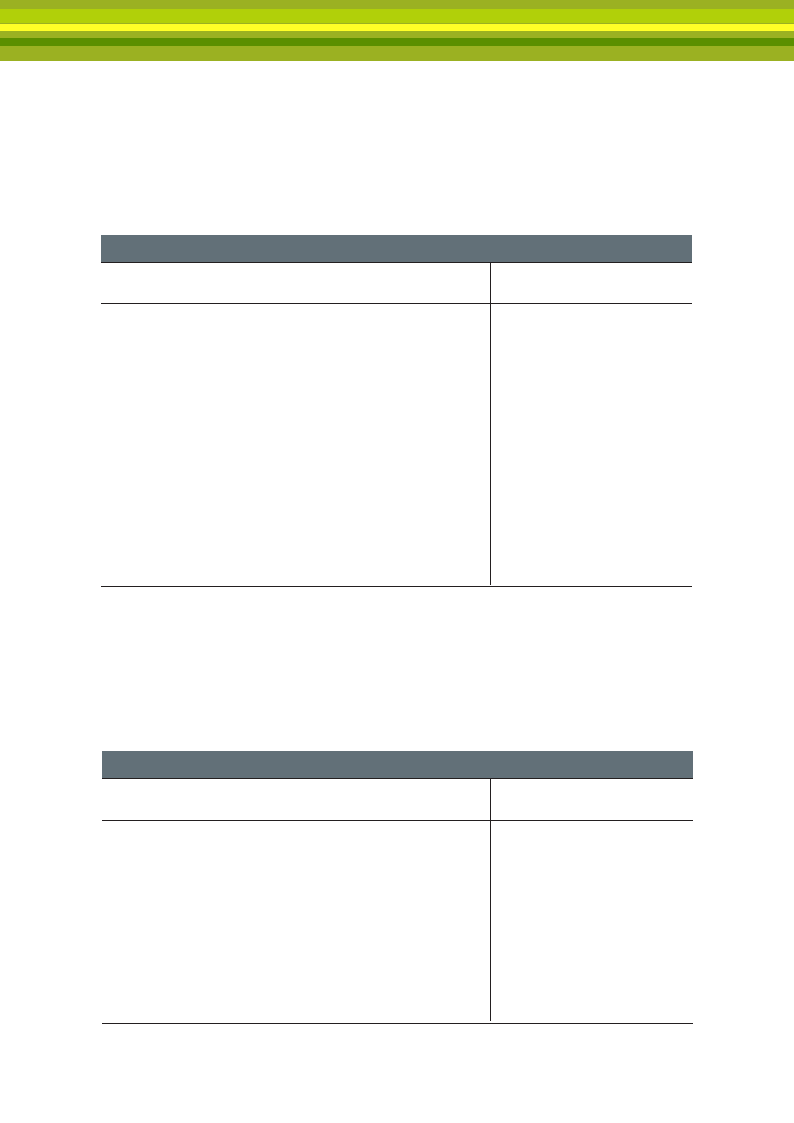
Objectives
The main objective of the education sector development plan is to ensure effective
and efficient education and training system that enhance quality, relevance, equity
and access at all levels. This will be achieved through building sectoral implementation
capacity and the development and adherence to competency criteria (National
Planning Commission, 2016a). The specific objectives are described in Table 5.29.
Table 5.29 Specific Objectives of education and training
Specific Objectives: Education and Training
Development
Lead/Responsible Agency
• Became a lead organization for establishment and
Ministry of Education
operationalization of school DRM club, which works closely
with school based parents’ organization
• Develop school DRM module and create harmonization of
DRM curriculum with the existing education and training
development objectives, which include among others:
• Increase pre-school and primary school access and
enrolment
• Increase primary school net enrolment
• Expand adult education
• Increase secondary school enrolment rate
• Increase middle-level trained man power
• Higher student intake in higher education programs intake
capacity
• Increase postgraduate student intake level of higher
education
• Improve the quality of education
Source: (National Planning Commission, 2016b; Ministry of Education, 2015)
The Ministry of Education has also formulated Education Sector Development
Programme V (ESDP V) in line with GTP – II (Table 5.30). It is a program action plan
that consists of education development context, education policy framework, priority
programs, and implementing and financing arrangements.
Table 5.30 Priorities of Education and Training
Priorities of the Education and Training System
in Ethiopia
• Provide equal opportunities and participation for all, with
special attention to disadvantaged groups
• Deliver quality education that meets the diverse learning
needs of all children, youth, and adults
• Develop competent citizens who contribute to social,
economic, political and cultural development through
creation and transfer of knowledge and technology
• Promote effective leadership, management and
governance at all levels in order to achieve educational
goals by mobilizing and using resources efficiently
• Assist children, youth and adults to share common values
and experiences and to embrace diversity
The Priority Programs
• Capacity development for
improved management
• General education: quality
• General education:
access, equity and internal
efficiency
• Adult and non-formal
education
• Technical and vocational
education and training
• Higher education
Source: (Ministry of Education, 2015)
143

Implementation Programs
To achieve the above objectives and annual targets, the implementation strategies
for Education and Training Development consist of three specific areas: 1) general
education, 2) technical and vocational education and training, and 3) higher education.
The inclusion of DRM in the existing curricula of the three areas would promote
establishment of DRR volunteer’s clubs in the education sector. The components are as
follows:
Capacity development for improved management: Component 1: A relevant structure,
with a clear distribution of mandates and responsibilities at all levels; Component 2:
Regular gathering, processing, and sharing of information to inform decision making;
Component 3: Good coordination and communication within and across levels;
Component 4: Adequate supply of staff with the right mix of skills in each post/level; and
Component 5: Resources and conditions of work.
General Education – Quality: Component 1: Teachers’ and leaders’ development;
Component 2: Curriculum, teaching, and learning materials; Component 3: School
Improvement Program (SIP); Component 4: Information and communications
technology; and Component 5: Quality assurance.
General education access, equity, internal efficiency: Component 1: Pre-primary;
Component 2: Primary; Component 3: Secondary; and Component 4: Special support
program for the four emerging regions.
Adult and non-formal education (ANFE): Component 1: Expanding IFAE and post-
IFAE programs in all regions; Component 2: Improving female participation in IFAE and
post-IFAE programs; Component 3: Introducing continuing education programs in
emerging regions; Component 4: Improving the quality of ANFE; and Component 5:
Creating a strong and efficient institutional system for ANFE at all levels.
Technical and Vocational Education and Training (TVET): Component 1: Occupational
standards development and assessment; Component 2: Trainees’ development and
institutional capacity building; and Component 3: Industry extension and technology
transfer services.
Higher education: Component 1: University expansion and consolidation; Component 2:
Equity enhancement; Component 3: Relevance and quality enhancement; Component
4: Research, technology transfer, and community engagement; and Component 5:
Institutional collaboration, leadership, and governance.
Source: National Planning Commission 2016a
Challenges
Educational development in Ethiopia could face challenges due to hazard risks, which
could affect learners, education personnel, education facilities, and students’ learning
achievements at varying degrees as highlighted in Table 5.31.
144

Table 5.31 Impact of Hazards on Education
Hazard
Impact on Education
Remark
Flood
• High dropout rate
• Damage to school facilities
• Children are missing up to
several days of school
Flood emergency could severely affect
schools in several districts, causing
high dropout rates, damaged on school
facilities, and disruption of learning
activities
Assessments indicate that more than
two million primary school students have
been affected by drought, floods, or
conflict (Education Cluster Unit, 2016)
Drought
• Schools are closed
A study on drought impacts on
• Disruption of learning activities education in Tigray region shows that
• Undermine learnings
primary schools are often closed as
• High dropout rate
children leave to help support individual
• Women and children are most family incomes during severe drought
affected
events (Asheber, 2010).
Children are missing up to 3 days of
school a week (more than half of their
normal attendance) as they support their
families by fetching water, taking care of
younger siblings, or taking livestock in
search of water sources.
Inadequate feeding limits the level
of children’s attention in class and
malnourishment could seriously
undermine learnings. Children are at
high risk of dropping-out, and are being
exposed to protection issues related to
child labor, trafficking, and exploitation
(Asheber, 2010).
The situation of women and children
worsened in the Tigray region when a
severe drought event occurred. Women
collected water from the nearest water
resource, but during drought time, water
scarcity obliges women to walk long
distances to fetch water (Asheber, 2010).
145

Steps for Mainstreaming DRM into Education and Training
Table 5.32 Key Steps and Activities for Mainstreaming DRM into
Education and Training
Step
Potential Activities/Action/Role for DRM
Mainstreaming
Outcome
Step 1:
Planning for
Engagement
Summary: Initial stage where the objective
is to advocate for DRM mainstreaming in the
education sector, including agencies mandated
on education development and other relevant
schemes such as Ministry of Education, National
Educational Assessment and Examinations
Agency (NEAEA), Higher Education Quality
Assurance Agency, Regional Education Bureaus
(REBs), National Planning Commission, Ministry
of Women’s, Children’s and Youth Affairs,
teacher associations, school community,
education cluster, CSA, and NMA
Key stakeholders recognize
the need for integrating
DRM into education and
training development and
jointly work on situation
analysis
Broad approach and
guidelines for conducting
situation analysis developed
Step 2:
Situation
analysis
Suggestions:
• Ministry of Education and its agency at all
levels conduct meetings to create buy-
in and facilitate partnership among key
officials from concerned government
agencies at national and sub-national
levels, development partners with thematic
focuses on school disaster risk reduction,
emergency education, child welfare, etc. and
representatives from the ground level such
as wereda education office, school heads,
teachers, and staff in hazard-prone areas to
reflect the issues and challenges on disaster
risk that impede education development
• Review existing risk information and data to
identify predominant issues with regards to
disaster impacts on education at national
scale, regional scale, Wereda scale and
school level
• Establish team for undertaking situation
analysis (Step 2)
Summary: This step deals with information
and data collection, applying risk assessment
from a sector-specific perspective, risk ranking,
and prioritization.
Sector briefing notes on
education and training
Problem statement
Suggestions:
• Conduct compilation, review, and analysis
of statistics, data, and information from
education sector (such as existing database,
reports, planning documents including
ESDP V) to understand trends and patterns
of disaster impacts on the sector. The data
shall be grouped in terms of:
146

Step
Potential Activities/Action/Role for DRM
Mainstreaming
Outcome
o Physical impacts/physical
vulnerability of school facilities (e.g.,
structural damage of school buildings,
number of schools with no water tank
for clean drinking water, number of
schools byWereda experienced
structural impact in the past 10 years);
o Education continuity (e.g., number of
school closures due to hazard impacts
from drought, conflicts, and flood,
school drop-out rate compared to next
hazard affected period, structural
damage of school facilities due to flood,
etc.)
• Undertake study to review the education
curriculum of school towards developing
a curriculum consisting of a DRM subject
matter
• Use wereda risk information management
system to understand the level of
educational attainment of households’
members (as factor for understanding
social vulnerability). Educational attainment
of households’ members (as factor for
understanding social vulnerability)
• Use wereda risk information management
system to understand the level of gender
parity in education level (7+ years) and
household heading
• Undertake study on the impacts drought,
conflicts, and flood on women and children.
What initiatives have been taken so far and
what are the challenges and way forward?
• Identify schools, students, school personnel,
and school activities with high risk using
multi-hazard or specific-hazard risk ranking
(i.e., very high, high, medium, low, very low).
Use these rankings to identify schools that
require urgent attention
• Develop user-friendly presentation of the
assessment result for concerned officials,
decision makers and stakeholders for wider
stakeholder consultation
• Review relevant policies of education
sector in the context of current disaster
and climate risk. For example, education
and training policy and its implementation,
2002; content and pedagogical standards
for different subject teachers which will
be identified later in Ethiopian Secondary
Schools (Grade 9-10), 2013; Curriculum
Framework for Ethiopian Education (KG –
Grande 12); Pastoralist and Semi-Pastoralist
area education strategy, etc.
147

Step
Potential Activities/Action/Role for DRM
Mainstreaming
Step 3: Main-
streaming
Action De-
velopment
Process
Summary: This step deals with problem
validation process, problem prioritization
process, problem-solution tree analysis, and
action matrix development, where actions
should be in line with GTP-II actions.
Outcome
Problem tree(s) Root-causes
Mainstreaming DRM action
matrix for education and
training
Suggestions:
• Based on findings in Step 2 (i.e., problem
statement and sector briefing notes),
promote safe learning facilities in highly
vulnerable schools to natural hazard risks
(see Case Study 3; Box 5.13). For example,
within the GTP – II, this can be taken up
under the school improvement initiatives
• Promote children’s continuation in schools
that have experienced the highest number
of drop outs or schools that have closed
to high dropout rates. Such schools must
establish a school disaster management
plan to address the issue of school drop-
out number. For example, within the GTP
– II, this can be taken up under the school
improvement initiatives.
• Promote mainstreaming DRR into school
curriculum of different subjects through
adopting/utilizing the following approaches:
Key Approach 1: Plan the national
curriculum development cycle in advance
Key Approach 2: Establish partnerships
between Ministry of Education and NDMO
Key Approach 3: Adopt a consultative
process
Key Approach 4: Link with processes of
the education sector programs funded by
the multilateral and bilateral agencies; and
the Education Sector Working Group led
Ministry of Education
For example, within the GTP – II, this can be
taken up under the general education –
quality
• Promote schools as well as local community
development or local NGOs to form clubs
for women and children about disaster risk
reduction education. For example, within
the GTP – II, this can be taken up under the
school improvement Initiatives (Case Study
3; Box 5.13). School feeding programs can
be strengthened or should be introduced
in most affected areas, if it has not already
been done
148

Step
Potential Activities/Action/Role for DRM
Mainstreaming
Outcome
• Promote actions such as the comprehensive
school safety policy; safe school facilities;
school disaster management; child
friendly school infrastructure, standards
and guidelines; key discussion tools and
check list for integrating DRR in the school
curriculum (Case Study 3; Box 5.13)
• Promote actions on simulations process
or exercises like doing the mechanism that
makes student alert
• Promote establishment of School DRM
volunteer club whose members include
parent representatives, students, school
management, community representatives,
and CBOs
Step 4:
Costing of
Actions and
Develop-
ment of
Implementa-
tion Plan
Summary: Stage 4 deals with identifying and
developing a financial strategy, implementation
strategy, communication strategy, and
monitoring and evaluation strategy for
mainstreaming actions for education and
trainings.
Suggestions:
• Costing of mainstreaming actions, including
incremental cost (gaps) and developing a
financial strategy along with education and
trainings actions/activities
• Create DRM unit in the education ministry
for the costing of actions and development
of implementation plan for education and
trainings
• Develop communication strategies for
mainstreaming actions under the education
and trainings actions/activities under GTP
– II
• Develop monitoring and evaluation
strategies for mainstreaming actions
under the education and trainings actions/
activities under the GTP – II
Disaster resilient initiatives
are prioritized in the
education and trainings
Step 5:
Approval
Process
Summary: This step deals with obtaining
political support for risk sensitive development
of education and trainings.
The education and trainings
promotes/ strengthen risk
sensitive development
Suggestions:
• Provide convincing evidence of the costs
of such short-term decisions in education
and trainings over the short, medium, and
long-term
• Revising legislation change to incorporative
climate and disaster risk. Suitable legislation
often promotes incentives for education
and trainings. For example, curriculum
revision procedures are required for the
development of DRR inclusive curriculum
for schools
149

Step
Step 6:
Implementa-
tion, Moni-
toring and
Evaluation
Potential Activities/Action/Role for DRM
Mainstreaming
• Set appropriate monitoring systems
and enabling strategies at the planning,
execution and evaluation stages of
education and trainings plan
Summary: This step deals with implementation
and tracking progress towards achieving the
activities as per the action plan developed in
Step 4.
Suggestions:
• Monitoring and evaluation for DRM
mainstreaming actions should be carried
out within the GTP- II monitoring and
evaluation strategies
• Technical guidance will be provided for
compiling and analyzing the collected
information and data. Currently, a biennial
report is submitted using the planned
Sendai framework for monitoring and
evaluation
• The gaps and challenges identified in this
step will be used to adjust for continual
improvements in the plan implementation
and for DRM efficacy and cost effectiveness.
In addition, gaps that were not adjusted are
taken up in Step 1 for discussion.
Outcome
Plan implementation is
adjusted for continual
improvements in
DRM efficacy and cost
effectiveness
150

Case Study 3: Mainstreaming DRR into Education Sector: Disaster
Risk Reduction Awarness in Schools in Malawi (United Nations
Economic Comission for Africa, 2015)
The education sector in Malawi has a pivotal role to play in conducting an effective
community education and awareness campaign as part of disaster risk reduction
mainstreaming work. Students of all ages can actively study and participate in school
safety measures as well as contribute to community risk reduction work. While efforts
are being made at the policy level by the Department of Disaster Management and civil
society networks to lobby for the incorporation of disaster risk reduction in school
curricula, on the ground NGOs are working with district education and area offices to
engage teachers and learners in disaster risk reduction awareness and mainstreaming
activities.
Integrating disaster risk reduction into school curriculum and extra-curriculum a
ctivities can help raise awareness and provide a better understanding of disaster risk
reduction in local-specific context for children, teachers, and communities. DRR clubs, sport
events, quiz competitions and DRR-related games were developed to help students interact
and learn more about disaster risk reduction in an engaging way. This strategy is contributing
to the creation of both a culture of safety and a proactive generation.
What is achieved – Impacts and Results
• Primarily, the initiative is helping promote the involvement of the education
sector in DRM and CCA-related work at community level, thereby promoting
effective community awareness and education in DRR mainstreaming work.
• The process is providing opportunities for civil society organizations to
conduct evidence-based advocacy, and work towards the inclusion of DRR and
CCA-related work into school curricula.
How mainstreaming DRR is promoted through various learning and student-
participatory activities
This case demonstrates that school-based activities under Pillar 3: Risk Reduction and
Resilience Education ultimately improves understanding, knowledge, life skills, and attitudes
of the students on DRR as follows:
• Forming of school clubs about disaster risk reduction promotes ownership of
initiatives by schools, teachers, and learners. This process provides a way for
translating DRR-related policies and strategies into practical activities at the
school level, thereby ensuring long-lasting results, as schools are actively
participating in DRR-related activities such as reforestation and community
awareness about disaster risk reduction.
• A well-informed community can contribute to the effective implementation of
disaster risk reduction activities, thereby enhancing resilience. Sustainability of
151

school based DRR work is easy because it is cheaper and thrives on the active
participation of teachers and students.
Way forward for Ethiopia: Operational steps for mainstreaming DRR
• Promoting schools to form clubs about disaster risk reduction: The school club on
DRR may promote DRR education in three areas – increasing knowledge about
disasters (e.g., science behind natural hazards), prepare against disasters (e.g.,
class activities – disaster imagination games, hold family DRR meetings;
domestic science - clearing your surroundings with emergency bag making);
strategic thinking about actions to take during an emergency (e.g., Health and
Physical - prevention of injuries and first aid; Social Studies - Think about what
you can do after evacuation; Integrated Studies - think about differently-abled people)
- School clubs in Ethiopia: School clubs are established to enhance the regular
curriculum delivery through engagement in co-curricular activities ( i.e., putting
the theoretical and classroom based education into practice). The aim of
school clubs is to solve social, cultural, and economic problems faced by students
and the local community. Various kinds of school clubs are organized in
primary and secondary schools such as environmental club, girls/ gender club,
media club, HIV/AIDS club, civic and ethics club, charity club, etc.
- Environmental clubs: Environmental science is a subject offered in early
grades (i.e., from grade 1 to 4). In the later grades, it is integrated into subjects
as social science, biology, chemistry, geography, and civic education as
subject matters. The club is key to coordinating environmental activities that
consider the local context, including assessments of environmental challenges,
identifying intervention mechanisms, and translating theoretical understanding
into actions in such a way that local environmental problems are mitigated.
These clubs can be used for the promotion or enhancement of knowledge
about disaster risk reduction.
• Promote comprehensive school safety policy: This may include the creation of
safe learning environments, which includes a safe location, construction, and
retrofitting; maintaining safe learning environments with school disaster
management; protecting educational access with continuity planning; teaching
and learning about disaster prevention and preparedness; and building a culture
of safety and inclusion. As discussed above, Education and Training Policy and
its implementation in 2002 is a comprehensive and coherent education policy
in Ethiopia that broadly analyses all education related issues. DRR issues need to
be discussed and integrated for developing a comprehensive school safety
policy. Similarly, Pastoralist Area Education Strategy in Ethiopia was designed
for the pastoralist areas that suffered a long history of neglect and
marginalization under past governments. Consequently, basic development
infrastructures and social services, including education and training in these
areas are very meagre. Thus, it important that DRR issues and DRR strategies
are included in the current development strategy for pastoralist areas.
• Promote safe school facilities: This may include school buildings with multi-
hazard features, DRR features, child friendly features, hygiene and nutrition features,
152

and environmentally friendly features. Maintenance of school buildings may
include check-list and tools to maintain school facilities daily, weekly, monthly, and
annually. Remedial repairs and maintenance (e.g., painting, roof coverings, roof
structures, steel structures, roof fascias, bargeboards and exposed roof
timbers, external ceilings, internal ceilings, walls and floors, doors and windows,
electrical installations, plumbing installations, and school grounds). School
Inspection handbooks or related documents can be used to incorporate the
above components for promoting safe school facilities in Ethiopia.
• Promote school disaster management: This may include Disaster and Emergency
Preparedness guidance for schools by developing check-list for: 1) Assessment
and Planning; 2) Physical and Environmental Protection; 3) Response Capacity
Development; and 4) Practicing, monitoring, and improving.
• Promoting child friendly schools infrastructure, standards, and guidelines: This
may include standard framework, planning, and guidelines (e.g., appropriate,
sufficient, and secure buildings; healthy, clean, secure and learner-protected
environment; child-friendly and barrier-free environment that promotes inclusive
access and equal rights of every child; and adequate and appropriate equipment
that supports the level of education).
• Promote the development of technical guidance for integrating DRR in the
school curriculum: The guidance can be designed primarily for use by policy
makers and curriculum developers in central and sub-national administrations,
as well as school principals, teachers, teacher trainers, and local education officials
as well as local community members committed to fostering DRR learning.
The guidance may include sections on preparing curriculum framework for disaster
risk reduction; planning and processing DRR curriculum development, DRR
learning outcomes, programs, activities, materials, etc.; applying changes in
the classroom and school; scaling up and DRR mainstreaming; and monitoring
and evaluating changes. As discussed earlier, the Curriculum Framework for
Ethiopian Education (KG – Grade 12) aims to address issues related specifically
to the curriculum, especially education materials, methodologies, and assessment
techniques. Moreover, this framework is also considered as a blue print and
provides guidance for the preparation of the subsequent curriculum materials
notably syllabi, textbooks and also for the overall implementation of the
teaching learning activities across the grade levels. Thus, this framework can
also provide technical guidance for integrating DRR into school curriculum in Ethiopia.
• The guidance for integrating DRR in the school curriculum may also
include some key discussion tools and checklist. For example, five dimensions
of DRR learning in the curriculum, ESDRR curriculum planning tools, problem
tree analysis, objective tree analysis, developing competency-based
curriculum, developing subject-based DRR curriculum learning outcomes, etc.
Some checklist examples are: DRR learning outcomes, DRR student
assessment, conducting an evaluation, etc.
153

Box 5.13 Comprehensive School Safety Framework
•
The Comprehensive School Safety (CSS) Framework was developed in preparation for
the 5th Asian Ministerial Conference on Disaster Risk Reduction in 2012, by the
members of the Asia Pacific Coalition for School Safety. The framework promotes a
comprehensive approach to DRR in the education sector, embedded in the education
policy, plans, and programs and aligned with national, sub-national and local disaster
management plans. The Framework also aims to support school safety as a priority area
of post-2015 frameworks for sustainable development, risk reduction, and resilience.
Goals
• To protect learners and education workers from death, injury, and harm in schools
• To plan for educational continuity in the face of all expected hazards and threats
• To safeguard investor investments
• To strengthen risk reduction and resilience through education
The CSS framework rests on three intersecting pillars as follows:
Pillar 1. Safe learning facilities. This involves education authorities, planners, architects,
engineers, builders, and school community members in safe site selection, design,
construction and maintenance, including safe and continuous access to the facility
Pillar 2. School disaster management. This is established via national and sub-national
education authorities and local school communities (including children and parents/
guardians) working in collaboration with their disaster management counterparts at each
jurisdiction in order to maintain safe learning environments and plan for educational
continuity, conforming to international standards
Pillar 3. Risk reduction and resilience education. This includes formal and non-formal
education designed to develop a culture of safety and resilient communities (GADRRRES
and WISS 2015). The Comprehensive School Safety Framework brings diverse school
safety efforts into a clear and unified focus in order for education sector partners to work
effectively, and to link with other sector with similar efforts at the global, regional, national
and local levels.
Source: (Association of Southeast Asian Nations, n.d.; GADRRRES, n.d.)
154
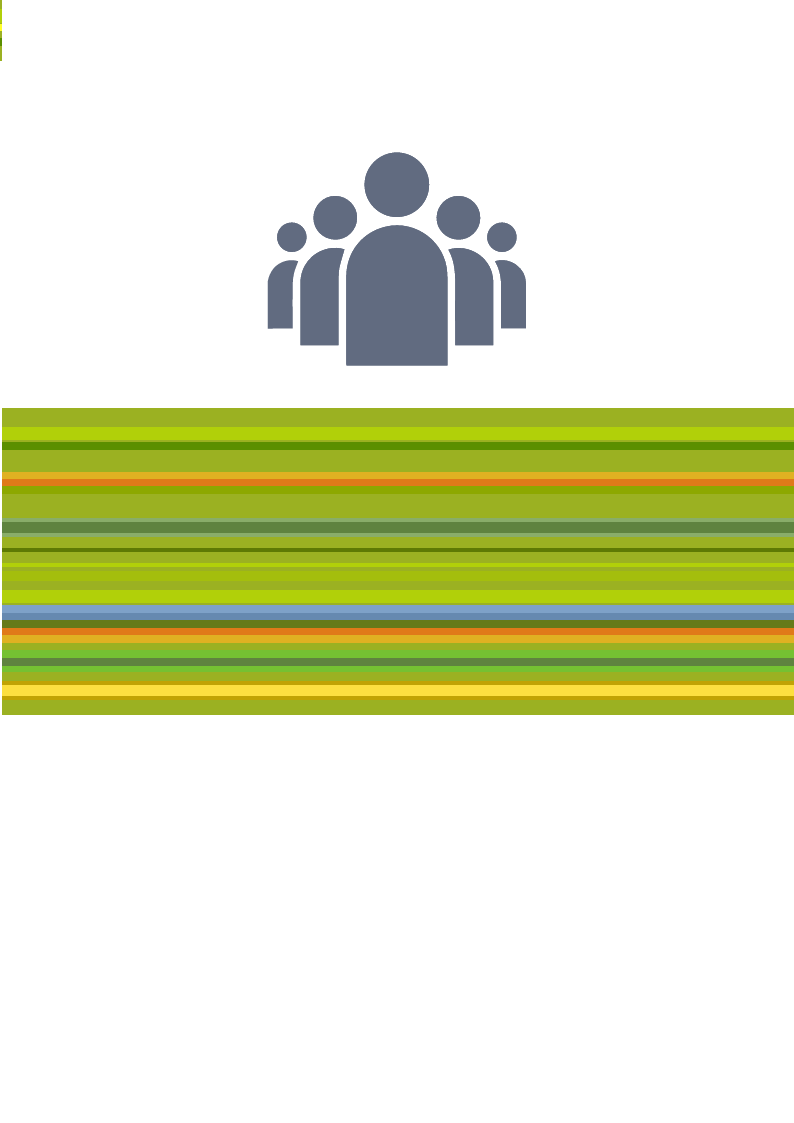
Guidance Note 8:
Social Welfare and Security
(Safety Net)

Social welfare and security is one of the key sectors/sub-sectors that addresses
the cross cutting issues during the Second Growth and Transformation Plan
(GTP – II), and was developed as an outcome of national development planning
process in Ethiopia. It is represented by the Ministry of Labour and Social Affairs.
The roles and responsibilities of the ministry in the national development planning
and implementation of national development plan8 and DRM are defined in Table 5.33.
Table 5.33 Lead Agencies Roles and Key Programs on DRM:
Social Welfare and Security (Safety Net)*
Lead Agency/ Roles & Responsibilitiess
Ministry
Key Programs on DRM
(Example)
Ministry of
Labour and
Social Affairs
• Responsible for implementing specific
objectives related to social welfare and
security in the national development plan.
Ministry is also accountable for monitoring,
evaluating, and reporting progress and
achievements of implementation
• Lead agency provides permanent direct
support through social safety net to
disadvantaged and disabled community
groups
• Lead institution with respect to gender
equity
Social protection policy
National
Disaster Risk
Management
Commission
(NDRMC)
Provide key information about:
• Disaster hot spot areas and sustainable
livelihoods framework
• Social vulnerability and conflict
• Employment vs unemployment
• Social security
WDRP
* Information presented in above table is illustrative and not exhaustive. It is subjected to government structure arrangement
in the country.
Objectives
The overall objective of social welfare sub-sector development plan under GTP- II is
increasing the benefits of disabled and elderly people as well as citizens by expanding
social security service coverage (National Planning Commission, 2016a). The specific
objectives for security affairs are:
Specific objectives:
• Improve benefits of citizens through expansion of social security systems
• Improve benefits of citizens through increasing accessibility and coverage of social security
Source: (National Planning Commission, 2016b)
In order to achieve the above objective, the sub-sectoral plan for social welfare and
security identified implementation strategies.
156

Implementation strategy
• Encourage disabled people to fully participate in the country’s political, economic and social
activities
• Remove barriers that hinder the activities of people with disabilities in workplace, residential
areas, recreation centers, and health centers
• Strengthen the existing community based coordination for public participation
• Promote formation of associations for disadvantaged community groups
• Enhance resource mobilization and networking
• Provide teaching and learning facilities applicable to disabled community groups
Source: (National Planning Commission, 2016a)
Challenges
In Ethiopia, the labor and social affairs sector is vulnerable to the various risks posed
by disasters and climate change. Both droughts and floods have caused extensive
loss and damages to the poorest segments of society, who are the prime focus of the
National Social Protection Policy 2014. The impacts of droughts and floods on the
social welfare and security are briefly explained in the Table 5.34.
Table 5.34 Table 5.34 Key Impacts of Hazard on Social Welfare
and Security
Hazard
Impact on Social
Remark
Welfare & Security
Drought
• Women
• Children
• Farmers
• Older people
• Disability group
A study on Tigray region about the drought impacts on
different sexes, age groups, and livelihoods found that
women and children are most affected by drought. For
example, in the study area, women collect water from the
nearest water source. They are often engaged in cooking,
cleaning, rearing children, and collecting firewood. In
addition, they also work in agricultural farms, earning
income for their family. Furthermore, they lack the skills
needed for employment in the less burdensome jobs.
During the drought, the situation worsens, with fewer
water sources near the dwelling, they will have to walk
long distance to fetch drinking water (Asheber, 2010).
In general, farmers are more affected by drought than
any other section of society. A study on Tigray region
confirmed throughout the study location (Asheber, 2010).
The situation of older people in Ethiopia is very poor,
especially for those who have no family and community
support and limited coping strategies. For instance, they
may not be able to travel long distances in search of
pasture, water or food or engage in daily labor or other
income generating activities. They may have difficulty
consuming wild or drought foods. In addition, they may
also sacrifice themselves in order to save the lives of
other members of the family, either by refusing food,
eating last or preferring to be left behind when families
migrate (Asheber, 2010).
157

Steps for Mainstreaming DRM into Social Welfare and Security
Table 5.35 Key Steps and Activities for Mainstreaming DRM into Social
Welfare and Security
Step
Potential Activities/Action/Role for DRM
Mainstreaming
Outcome
Step 1:
Planning for
Engagement
Summary: In this initial stage, the objective
is to advocate for DRM mainstreaming into
the labour and social affairs sector, including
relevant agencies such as Ministry of
Labour and Social Affairs, National Planning
Commission, Ministry of Women’s, Children’s
and Youth Affairs, Ministry of Finance
and Economic Cooperation and sector
development planning office, vulnerable groups
representatives, among others.
Key stakeholders recognize
the need for integrating
DRM into labor and social
affairs
Broad approach and
guidelines for conducting
situation analysis developed
Step 2:
Situation
analysis
Suggestions:
• Conduct meetings to facilitate partnership
with the key officials from Ministry of
Labour and Social Affairs, National
Planning Commission, Ministry of Women’s,
Children’s and Youth Affairs, Ministry of
Finance and Economic Cooperation and
sector development planning office, for
mainstreaming DRM into labor and social
affairs
• Present information on the recent disaster
and climate change impacts on the labor
and social affairs sectors (i.e., how disaster
impacts women, children, older people,
disabled people, etc.). Vulnerable groups
can be invited to share their experiences.
• Establish team for undertaking situation
analysis (Step 2)
Summary: This step deals with information
collection, and identification of key risks related
to labor and social affairs.
Suggestions:
• Use wereda risk information management
system to understand the households’
exposure to different hazards (response
in %), proportion of households getting
affected by type of disaster and frequency
• Use wereda risk information management
system to understand social vulnerability:
Household demographic characteristics;
population structure by kebele; population
trends and major ethnic group by kebele
• Use wereda risk information management
system to understand social vulnerability:
Level of educational attainment in the
hazard prone weredas
Sector briefing notes on
labor and social affairs
Problem statement
158

Step
Step 3:
Mainstream-
ing Action
Develop-
ment
Process
Potential Activities/Action/Role for DRM
Mainstreaming
• Use wereda risk information management
system to understand social vulnerability:
Gender parity (i.e., gender parity in
education level (7+ years) and household
heading) in the hazard prone weredas
• Use wereda risk information management
system to understand households’ health
condition and major health problems in the
hazard prone wereda
• Use wereda risk information management
system to understand household access to
health facilities, drinking water, sanitation,
etc. in the hazard prone weredas
• Undertake study on drought and flood
impacts and current risks experienced by
the disabled population and current coping
mechanism, DRR knowledge and challenged
faced by the group in Ethiopia
• Undertake study to understand the impacts
disasters on the targets set by labor
and social welfare under various GTPs
implemented in the past
• Review PSNP, HABP and reflect on lesson
learned, hindrances, gaps, and challenges
from past initiatives
• Review national social protection policy,
national social protection strategies in
Ethiopia, national physical rehabilitation
strategies, national plan of action on older
persons in the context of climate and
disaster risks in Ethiopia
• Use wereda risk information to determine
status of disabled community
• Develop sectoral briefing note on labor and
social affairs using above information. The
note should be referred and used during
the development mainstreaming DRM
actions (Step 3)
Summary: This step deals with the problem
validation process, problem prioritisation
process, problem-solution tree analysis, and
action matrix development. Actions should be in
line with GTP-II actions.
Suggestions:
• Based on findings in Step 2 and the sectoral
briefing note, identify and prioritize actions
for mainstreaming DRM into sectoral
instruments (Figure 5.2)
• Since one of the key focus areas of GTP – II
is on people with disabilities (PwDs), the
following priorities must be considered
while developing DRM actions for PwDs:
Outcome
Problem tree(s)
Root-causes
Mainstreaming DRM action
matrix for social welfare and
security
159

Step
Step 4:
Costing of
Actions
and
Develop-
ment of
Implemen-
tation Plan
Step 5:
Approval
Process
Potential Activities/Action/Role for DRM
Mainstreaming
-
Conduct multi-country surveys on the
impact of disasters on the quality of lives of
persons with disabilities and their caregivers to
fill the gap of the lack of data on persons with
disabilities and disaster
-
Compile good practices and lessons
learnt of disability inclusive DRR in the region
in order to promote an achievable vision of
disability inclusive DRR
-
Develop guide for including people with
disabilities in disaster preparedness planning
(See Box 5.14).
Summary: Stage 4 deals with identifying and
developing a financial strategy, implementation
strategy, communication strategy, and a
monitoring and evaluation strategy for
mainstreaming actions for social welfare and
security.
Outcome
Disaster resilient initiatives
are prioritized in the social
welfare and security plan
Suggestions:
• Costing of mainstreaming actions, including
incremental cost (gaps) and developing a
financial strategy along with social welfare
and security actions/activities
• Create institutional arrangements such
as the creation of an implementation unit
along with the implementation unit for
social welfare and security
• Develop communication strategies for
mainstreaming actions under the social
welfare and security actions/activities under
GTP – II
• Develop monitoring and evaluation
strategies for mainstreaming actions under
the social welfare and security actions/
activities under the GTP – II
Summary: This step deals with obtaining
political support for risk sensitive development
of social welfare and security plan.
Suggestions:
• Provide convincing evidence of the costs of
such short-term decisions in social welfare
and security sector over the short, medium,
and long-term
• Promote legislation change to incorporative
climate and disaster risk. Suitable legislation
often promotes incentives for social welfare
and security
• Set appropriate monitoring systems
and enabling strategies at the planning,
execution, and evaluation stages of social
welfare and security plan
The social welfare and
security plan promotes/
strengthen risk sensitive
development
160

Step
Step 6:
Implemen-
tation,
Monitoring
and
Evaluation
Potential Activities/Action/Role for DRM
Mainstreaming
Summary: The step deals with implementation
and tracking progress towards achieving the
activities as per the action plan developed in
Step 4.
Suggestions:
• Monitoring and evaluation of DRM
mainstreaming actions should be carried
out within the GTP- II monitoring and
evaluation strategies
• Technical guidance will be provided for
compiling and analyzing the collected
information and data. Currently, a biennial
report is submitted using the planned
Sendai framework for monitoring and
evaluation
• The gaps and challenges identified in this
step will be used to adjust for continual
improvements in the plan implementation
and for DRM efficacy and cost effectiveness.
In addition, issues not adjusted are taken
up in Step 1 for discussion.
Outcome
Plan implementation is
adjusted for continual
improvements in
DRM efficacy and cost
effectiveness
Box 5.14 A Guide for Including People with Disabilities in Disaster Preparedness
Planning
This guide, written for municipal and regional planners, reflects information, concerns
and recommendations that emerged at the day-long forum on December 6, 2005, on
“Lessons Learned” from recent large-scale disasters that affected states along the US
Gulf Coast. At the forum, individuals connected with the disability communities
in those states presented a compelling picture of both widespread ignorance of
disability issues among those responsible for disaster planning and response, and a
tragic lack of preparedness on the part of people with disabilities and the human service
infrastructure. Discussions among forum participants focused on sharing information
about the US state of Connecticut’s system for planning and responding to large scale
emergencies, and on ways to make sure the needs of people with disabilities are met.
Source: (University of Connecticut, n.d.)
161

References and Additional Reading:
Abaya, S. W. (2008). Floods and Health in Gambella Region, Ethiopia: An Assessment of the Strength and Weakness
of the Coping Mechanism. M.Sc. Thesis submitted to Lund University Centre for Sustainability Studies.
Asheber, S. A. (2010). Mitigating Drought: Policy Impact Evaluation A Case of Tigray Region, Ethiopia. Doctoral
dissertation, ITC Netherlands. Retrieved from http://reliefweb.int/sites/reliefweb.int/files/resources/publica-
tion_ASEANCommonFramework.pdf
Cervigni, R., Losos, A., Chinowsky, P., & Neumann, J. E. (Eds.). (2017). Enhancing the Climate Resilience of Africa’s
Infrastructure: The Roads and Bridges Sector. Washington DC: International Bank for Reconstruction and Devel-
opment / The World Bank.
Chae E., Kim T., Rhee,S., and Henderson, T. (2005). The Impact of Flooding on the Mental Health of Affected People
in South Korea. Community Mental Health Journal, 41(6):633-645.
DeVoe, D. (2013). Integrated Watershed Management in Harbu, Ethiopia. The Road to Resilience: Case Studies on
Building Resilience in the Horn of Africa.
Education Cluster Unit. (2016). Education Cluster – Ethiopia. Retrieved from http://educationcluster.net/country-
coordination/high-priority-countries/ethiopia/
El Nakat, Z.S. (2015). Disaster Risk Management in the Transport Sector: A Review of Concepts and International
Case Studies. Washington, D.C.: World Bank Group. Received from http://documents.worldbank.org/curated/
en/524081468188378328/Disaster-riskmanagement-in-the-transport-sector-a-review-of-concepts-and-inter-
national-case-studies
DesInventar. (n.d.). Ethiopia - Multi-hazard profile. Retrieved from http://www.DesInventar.net/DesInventar/pro-
filetab.jsp?countrycode=eth
Ethiopia Red Cross/Crescent. (2005). Ethiopia: Floods Emergency Appeal. Addis Ababa, Ethiopia.
European Commission. (2013). Guidance on Integrating Climate Change and Biodiversity into EIA, Study Contract
No 07.0307/2010/580136/ETU/A3, implemented for the European Commission by Milieu Ltd, Collingwood
Environmental Planning Ltd and Integra Consulting Ltd. Retrieved from http://ec.europa.eu/environment/eia/
pdf/EIA%20Guidance.pdf
Federal Disaster Prevention and Preparedness Agency (FDPPA). (2006). Joint Government and Humanitarian
Partners Flash Appeal for the 2006 Flood Disaster in Ethiopia. Addis Ababa, Ethiopia.
Federal Democratic Republic of Ethiopia. (2009). National Policy and Strategy on Disaster Risk Management. Ad-
dis Ababa, Ethiopia.
Gambella Region Disaster Prevention and Preparedness Agency. (2007). Report on Emergency Disaster Study.
Gambella, Ethiopia.
Global Alliance for Disaster Risk Reduction and Resilience in the Education Sector (GADRRRES). (n.d.). Com-
prehensive School Safety Targets and Indicators. Retrieved from http://gadrrres.net/resources/css-targets-and-
indicators
Ministry of Education. (2015). Education Sector Development Programme V (ESDP V). Programme Action Plan.
Federal Ministry of Education Federal Democratic Republic of Ethiopia, Addis Ababa, August 2015.
Ministry of Water Resources and Meteorological Agency. (2007). Climate Change NAPA of Ethiopia. Retrieved
from http://unfccc.int/resource/docs/ napa/eth01.pdf.
Morgan, O., Ahern, M., and Cairncross, S. (2005). Revisiting the Tsunami: Health Consequences of Flooding. PLoS
Medicine, 2(6): e184.
National Planning Commission. (2016a). Growth and Transformation Plan II (GTP II) (2015/16-2019/20). Vol 1:
Main Text. Federal Democratic Republic of Ethiopia.
National Planning Commission. (2016b). Growth and Transformation Plan II (GTP II) (2015/16-2019/20). Volume II:
Policy Matrix. Federal Democratic Republic of Ethiopia.
OFDA/CRED. (2008). Emergency Event Database. Retrieved from http://www.emdat.be/
162

Otto, K., Boos, A., Dalbert, C., Schops, D., Hoyer, J. (2006). Posttraumatic Symptoms, Depression, and Anxiety of
Flood Victims: The Impact of the Belief in a Just World. Personality and Individual Differences, 40: 1075–1084.
Pan American Health Organization. (2010). Health Sector Self-Assessment Tool for Disaster Risk Reduction. PAHO,
2010: Washington, D.C.
Tadesse L., and Ardalan A. (2014). Health Sector Initiatives for Disaster Risk Management in Ethiopia: A Narrative
Review. PLOS Currents Disasters. April 1, Edition 1. doi: 10.1371/currents.dis.949664319ad451313b499f9c90c
d9c0f.
UNISDR. (2009). Accelerated Livestock Marketing to Boost Household Income of Pastoralists During Drought:
Commercial Livestock Destocking as a Drought Response. Drought Risk Reduction Framework & Practices. United
Nations Secretariat of the International Strategy for Disaster Reduction (UNISDR), Geneva, Switzerland, in
partnership with the National Drought Mitigation Center (NDMC), University of Nebraska-Lincoln, Lincoln,
Nebraska, U.S.A. August, 2009.
United Nation Office for the Coordination of Humanitarian Affairs (UN OCHA). (2006). Focus on Ethiopia: A
Monthly Focus on Humanitarian Trends and Activities in Ethiopia. Addis Ababa, Ethiopia.
University of Connecticut. (n.d.). A Guide for Including People with Disabilities in Disaster Preparedness Planning.
University Center for Excellence in Developmental Disabilities at 1.860.679.1500(v) or 860.679.1502 (TTY).
Retrieved from http://www.ct.gov/ctcdd/lib/ctcdd/guide_final.pdf
World Bank. (2015). Enhancing Urban Resilience. City Strength Resilient Cities Programme. Global Practice on
Social, Urban, Rural and Resilience. The World Bank Group: Washington, DC.
163

Guideline for Mainstreaming Disaster Risks into Investment Decisions
This document provides guidance on how to mainstream disaster risks into the
development planning process, budgeting, and public and private investment
planning in Ethiopia. The sectors used in this document are derived from Ethiopia’s
Growth and Transformation Plan (GTP). The benefits of mainstreaming disaster risks
must contribute to the objectives of GTP and sustainable development goals (SDGs).
The guidance provided in this document is further illustrated through Ethiopian
context and case studies showing examples where mainstreaming-related tools have
been adopted to reduce disaster risk. This document aims to support stakeholders at
multiple levels to embrace mainstreaming disaster risks into future investment decisions.
National Disaster Risk Management Commission
Africa Venue, Addis Ababa
Telephone: +251 - 5516407, +251 -5524272
Fax. no.: +251 - 5514788
Website: dppc.gov.et
This document was prepared with the technical and financial support from
the World Bank through the Asian Disaster Preparedness Center




